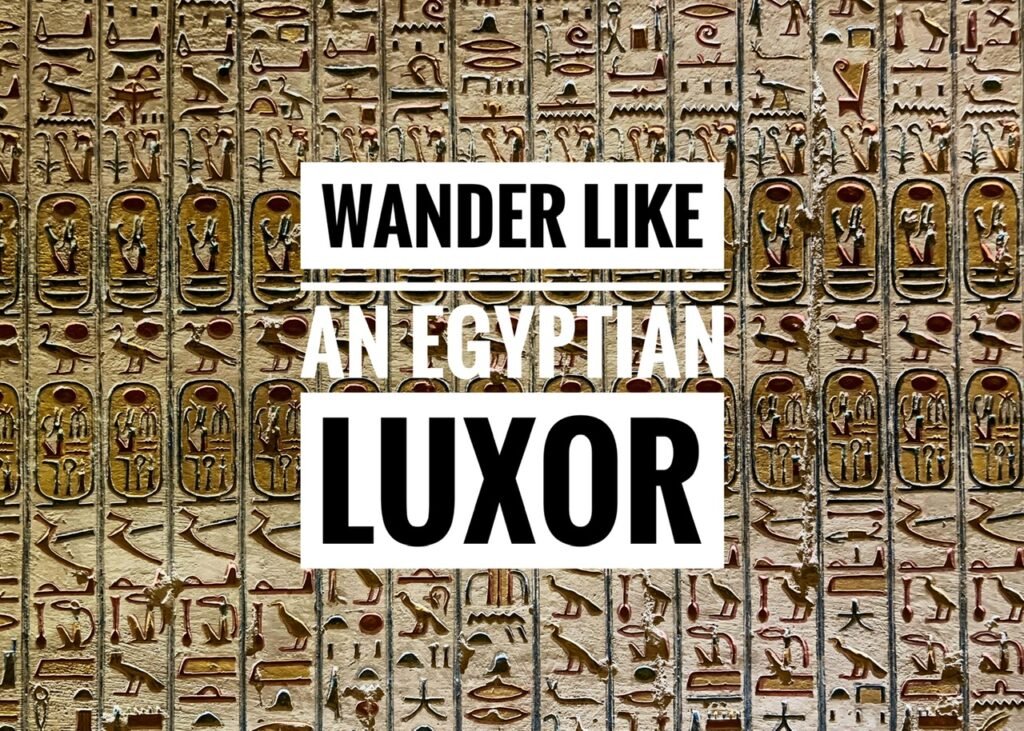
When we pulled into the GoBus station in Luxor, we expected to be battered from all angles by taxi drivers. And while they were indeed persistent, we’ve experienced way worse in other places. But fortunately, as we swooped down to fetch our under-bus bags, one of those drivers, a quite young one, revealed our What’s App profile photo on his phone so we knew this was the one to trust. This is why it pays to plan a pickup, preferably through your hotel, in Egypt! It was “pricy” at $10, but well worth it in this case.
Omar hoisted both our hefty bags onto his lanky frame and led us through the crowd to our actual driver, who proceeded to roll us a few miles to our first glimpses of the Nile River.
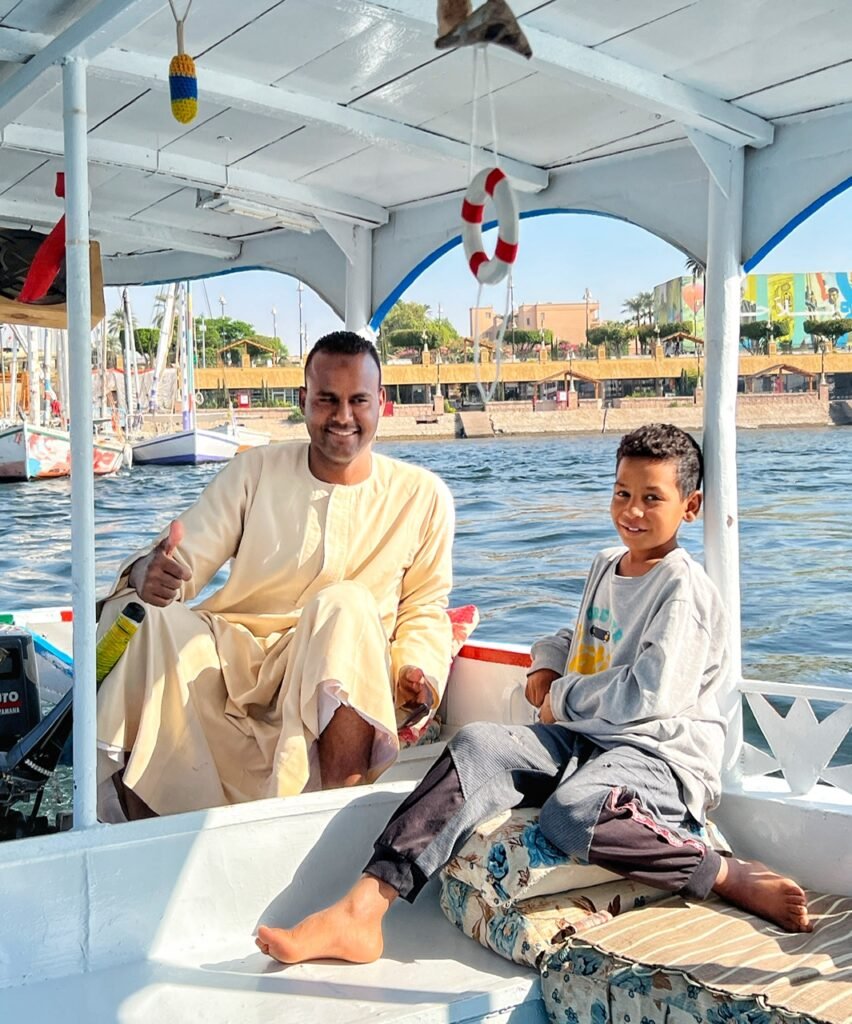
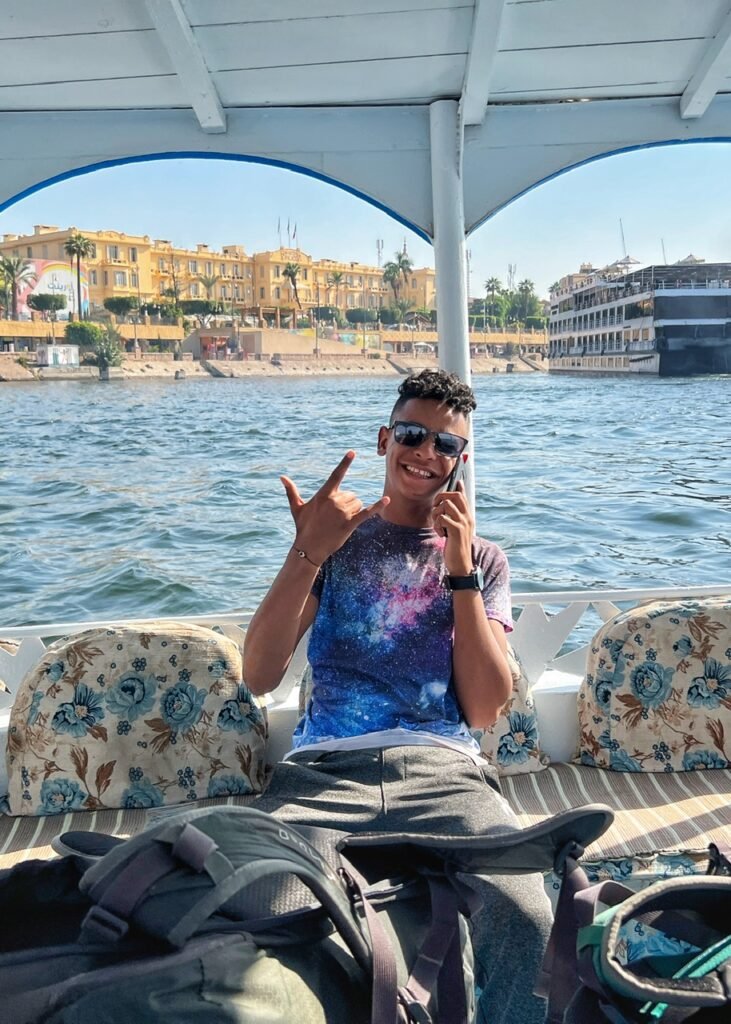
Climbing aboard a taxi boat on the Nile for the very first time we meet Ahmed, and his son. We had chosen to stay on the West Bank of the river because it is more scenic, less touristy, (which means less gimmicky) and cheaper, which ended up being a VERY good decision. The second photo is Omar, our chauffeur and “handler”.
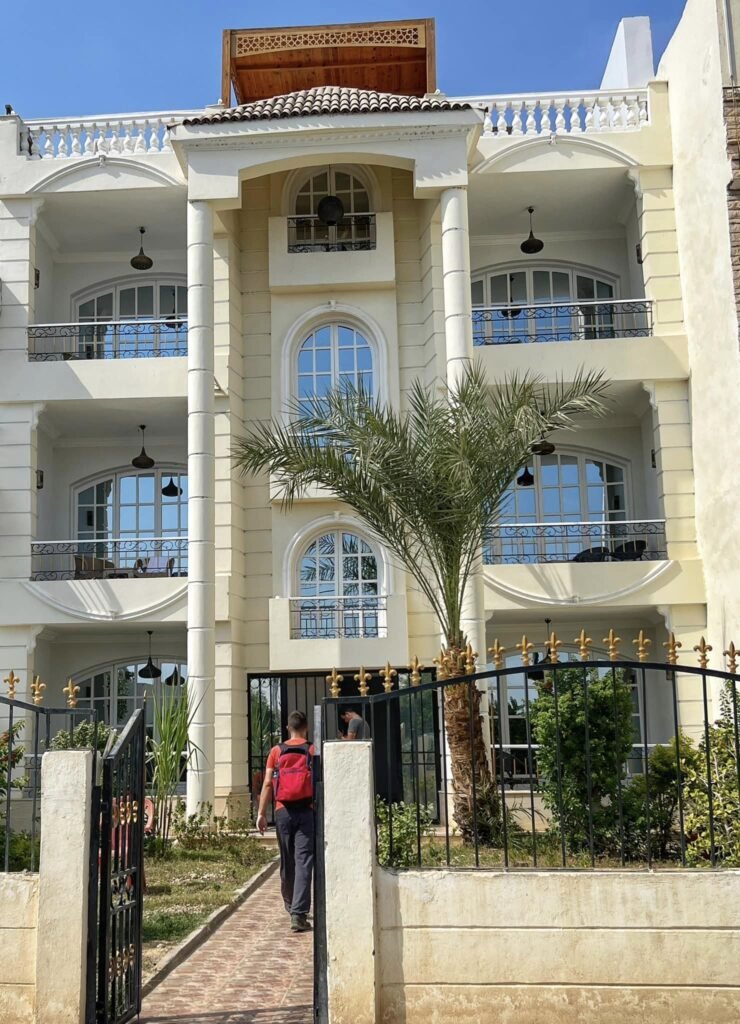
Arriving at our new home for the next six nights, the White House Apartments, which we found on Booking for $23/night. However, we had “Genius Level” Booking credits, which brought it to $19/night.


We were welcomed to the upper deck by Omar’s Uncle Mohammed and were floored by this view of Luxor Temple across the Nile, which would be ours for the next six days.
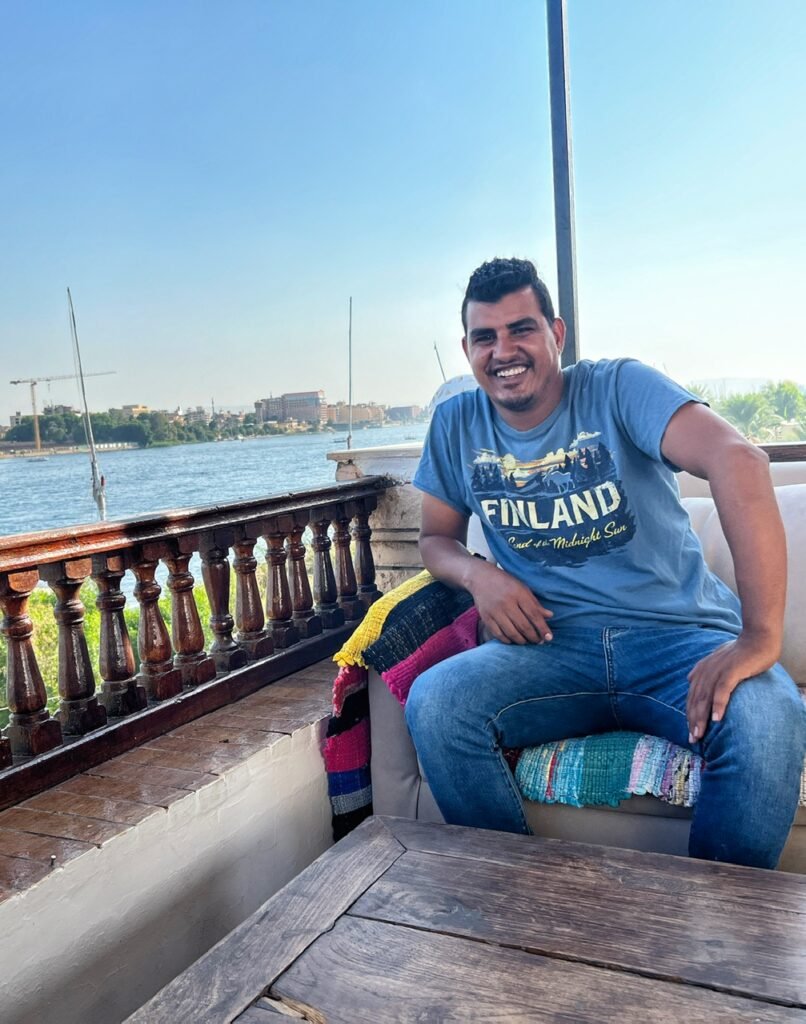
Mohammed, and his family who own the guest house, are the first genuinely welcoming people we’ve met in Egypt so far. He understands what hospitality actually means. He’s very kind, forthright about prices and just…cheery! Although he certainly presented us with tour options, he treated us like people and not ATMs from the beginning. We greatly appreciated his character and charm and couldn’t recommend this hotel any more.
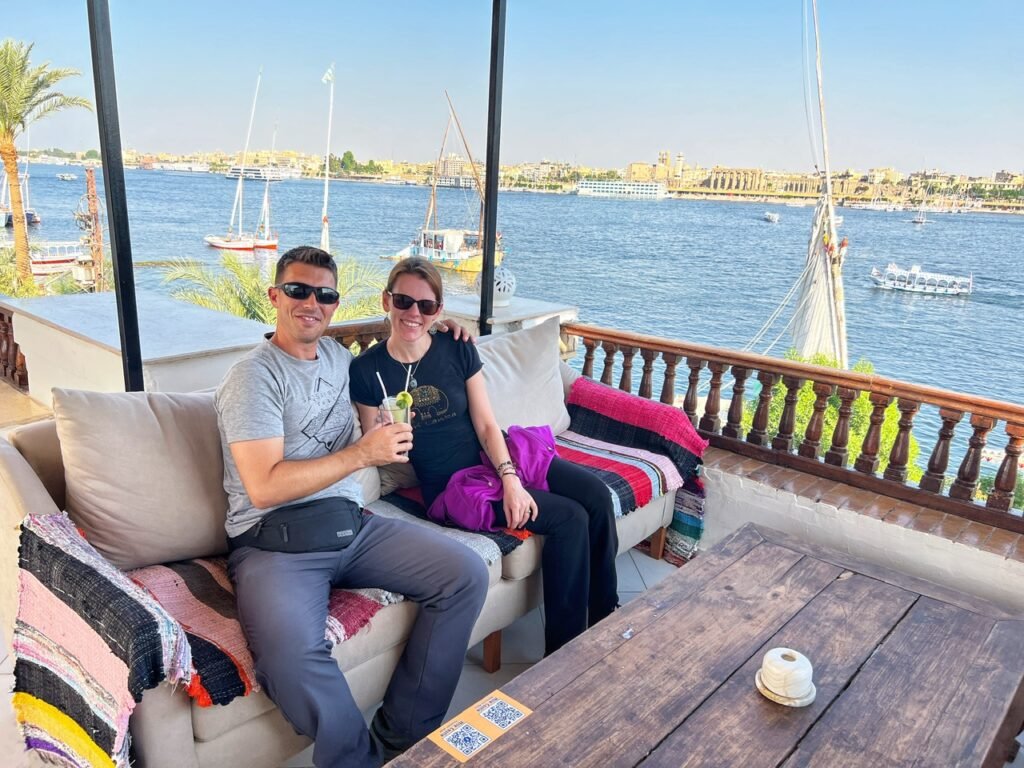
Having a welcome drink…Mandy’s was lemon/mint and Greg’s was hibiscus.
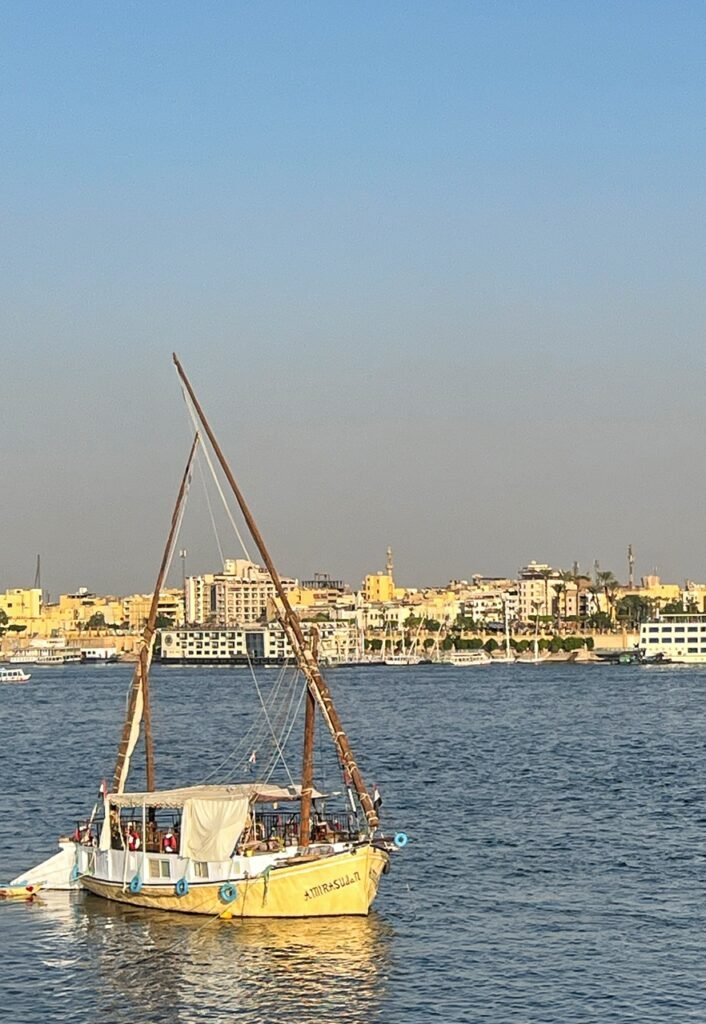
Gazing out at the longest river in the world at 6600 kilometers or 4100 miles. In addition to Egypt, it flows through or alongside Burundi, Tanzania, Rwanda, the Democratic Republic of the Congo, Kenya, Uganda, Sudan, Ethiopia, and South Sudan.

There are three ways to go cruising on the Nile. Most people cruise downstream from Aswan (south of here) to Luxor. The first option (pictured) is a small ship cruise (the most expensive), a dahabiya, essentially a houseboat with sails, which offers the nostalgic allure of a felucca without the need to rough it, or a felucca, a rustic traditional wooden boats powered by sails. We looked at doing a felucca cruise and although it would have only been a slight splurge for our budget, it would have taken 4-5 days and we really just wanted to concentrate on the sights this time. Maybe next time; it does sound dreamy…
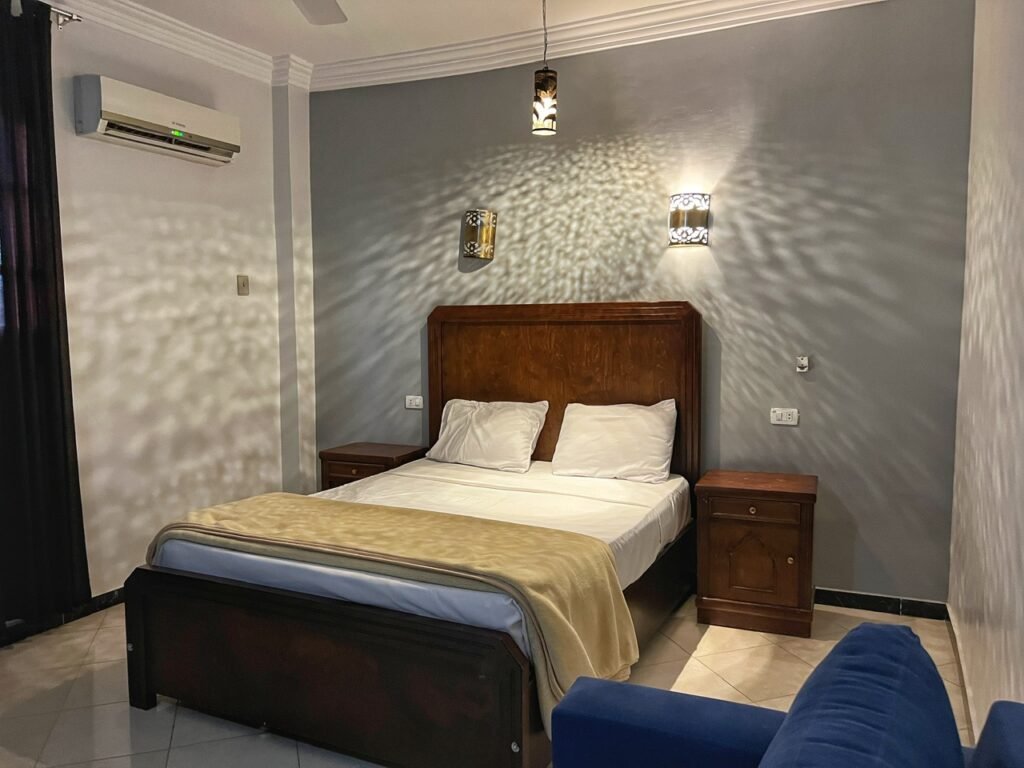
Mohammed sweetly upgraded us to a top-floor room with a comfortable bed (and TWO pillows!) for no extra cost and we were elated! Our bedroom was quiet, other than a tenacious little donkey who liked to cause a ruckus early in the morning.
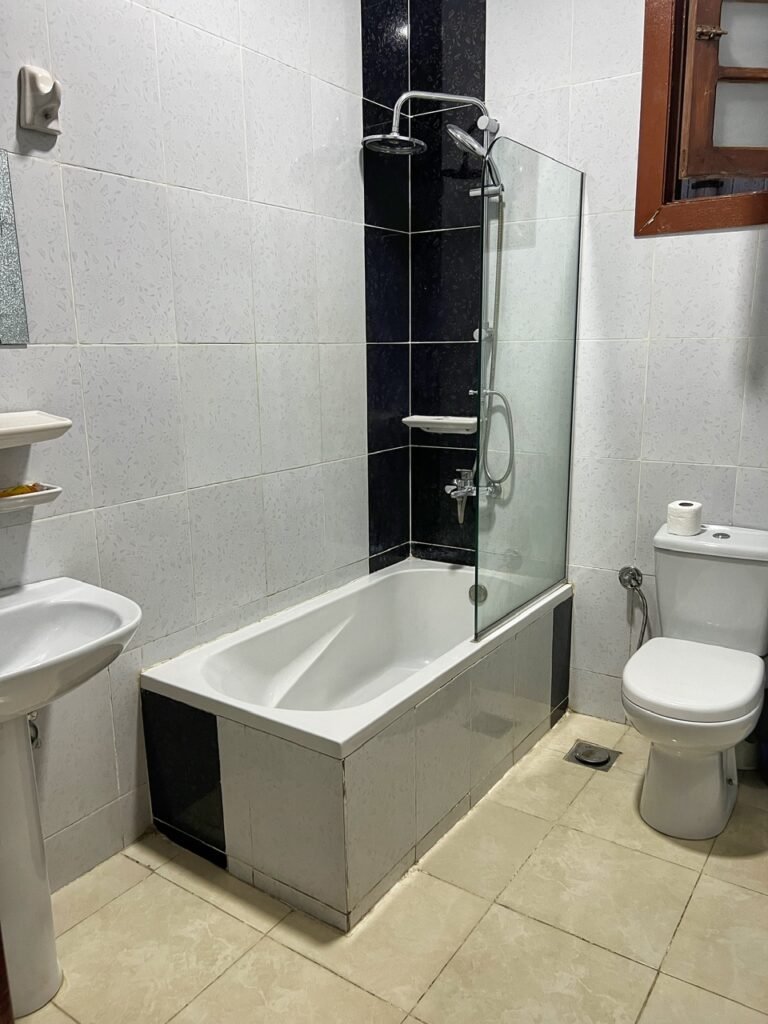
Our bathroom with plenty of hot water!
Our kitchen, which wasn’t too well equipped but we’ve always got our back-up plans! It had the most important things like a fridge, hot plate and a kettle.
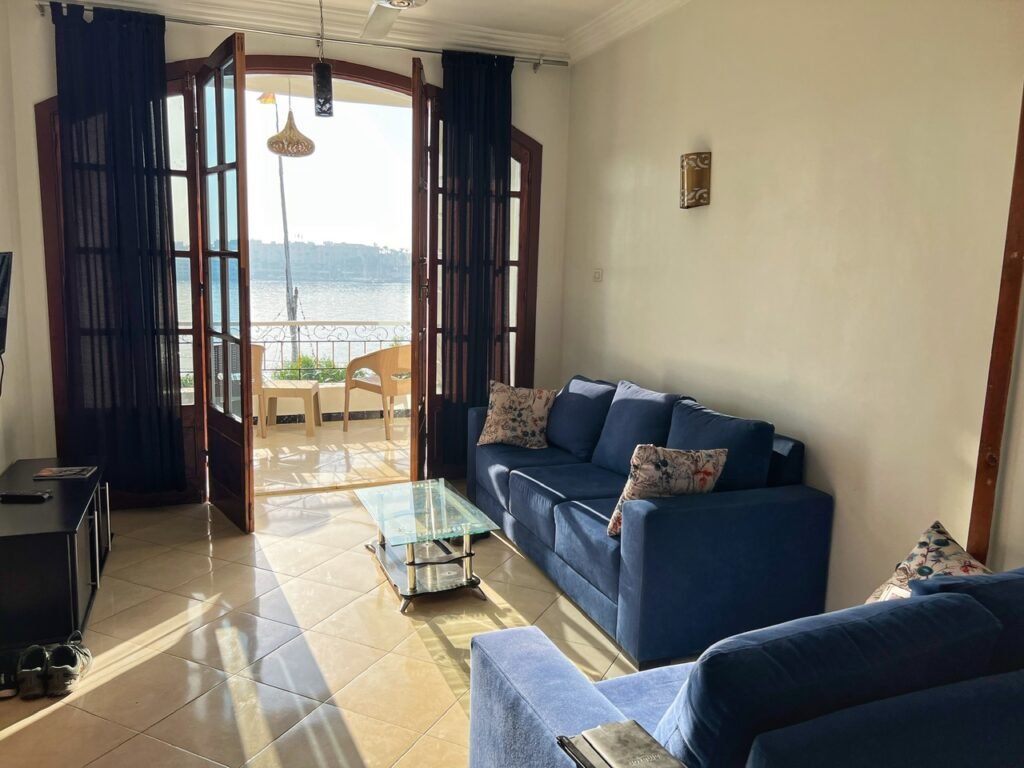
Our living room with balcony overlooking the Nile.
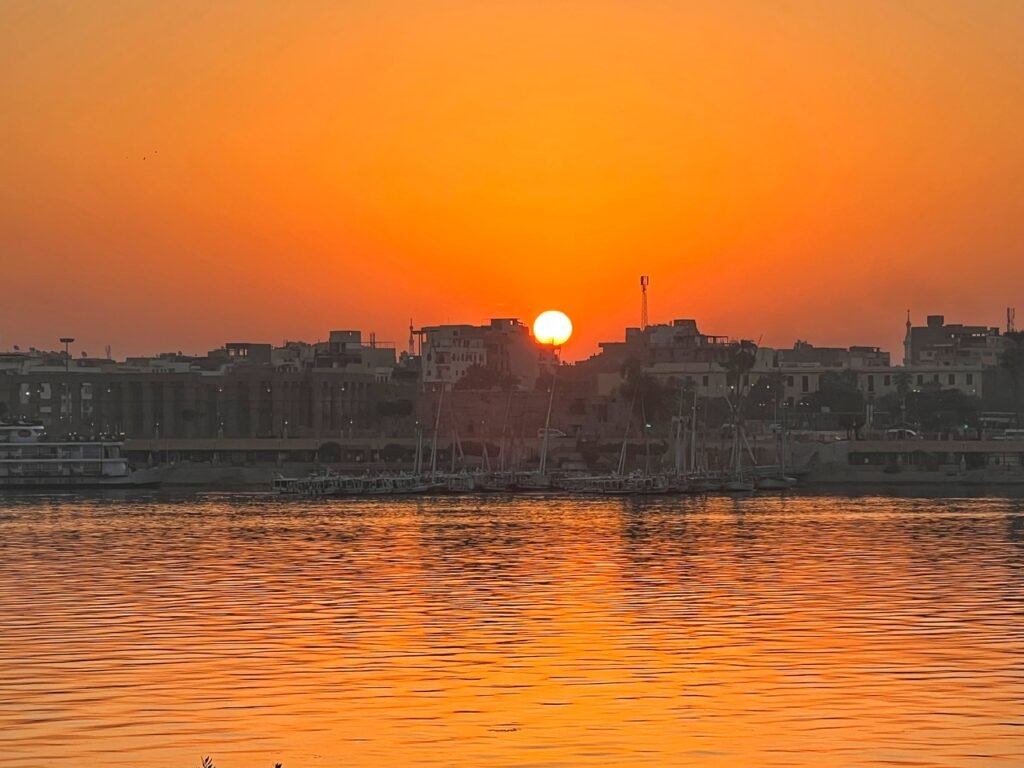
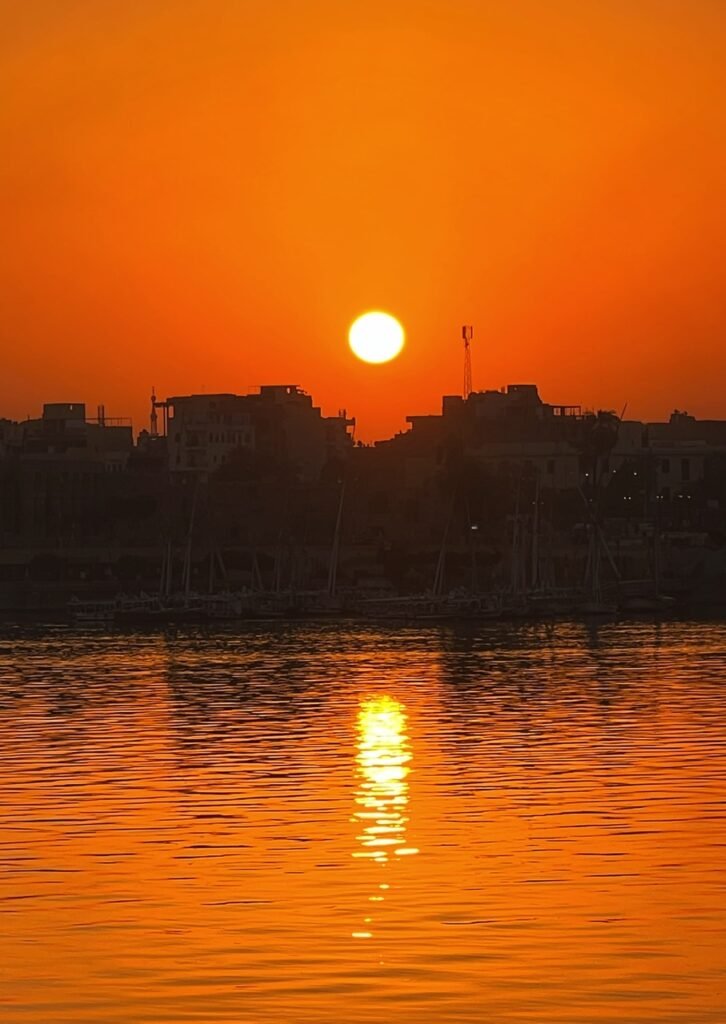
And the best part? That balcony featured a 5:55 sunrise directly over that sacred river and ample space for yoga. Ummm…yes. Namaste please. 🧘♀️ That glowing orb couldn’t have been more iconically African.
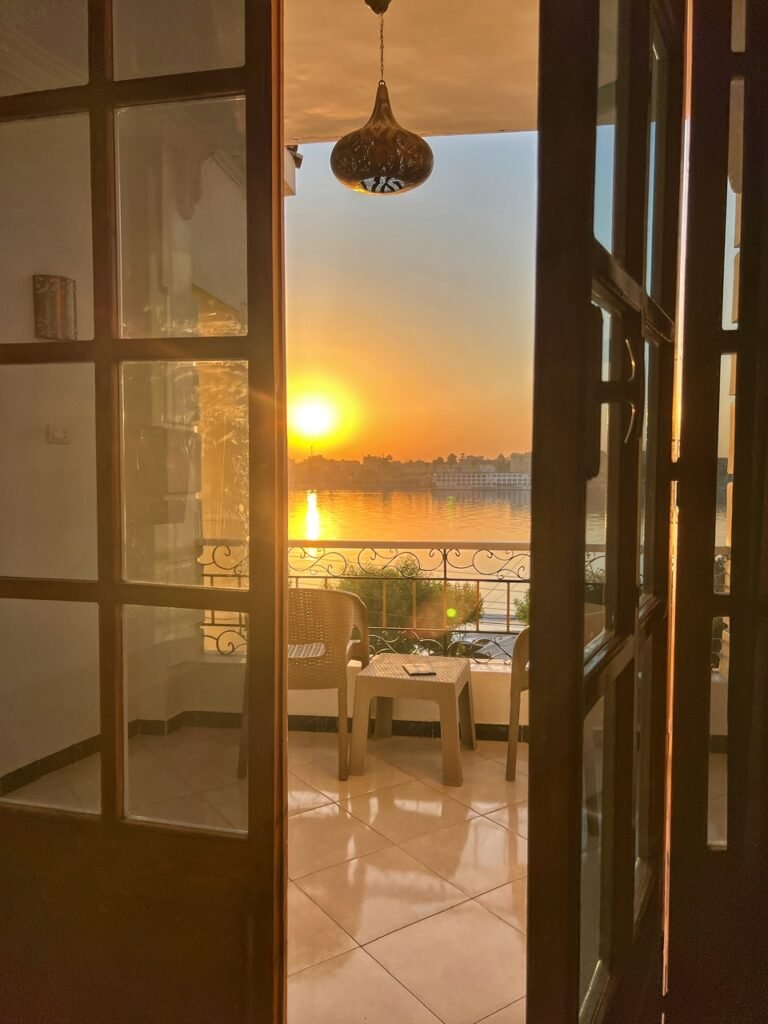
This might be what dreams of made of.
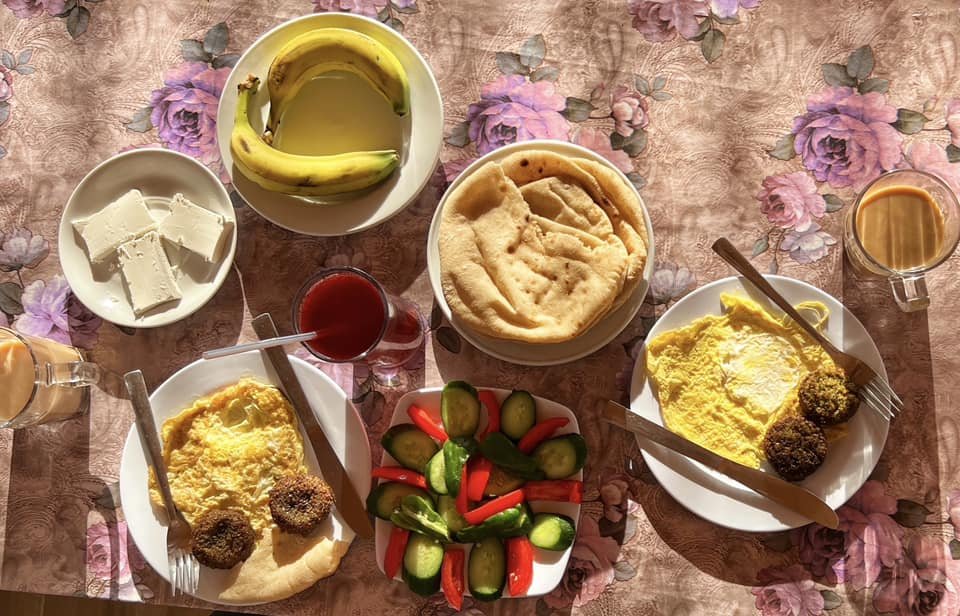
And a few hours later, we wandered upstairs for our complimentary breakfast, which was outstanding. It includes delicious cheese, ful (beans), cucumbers/tomatoes/peppers, eggs, fruit, falafel, Aish Baladi flat breads, tea/coffee and lemon or guava juice. Yes. All this is included in our $19 ($23)/night rate. What tremendous value!!
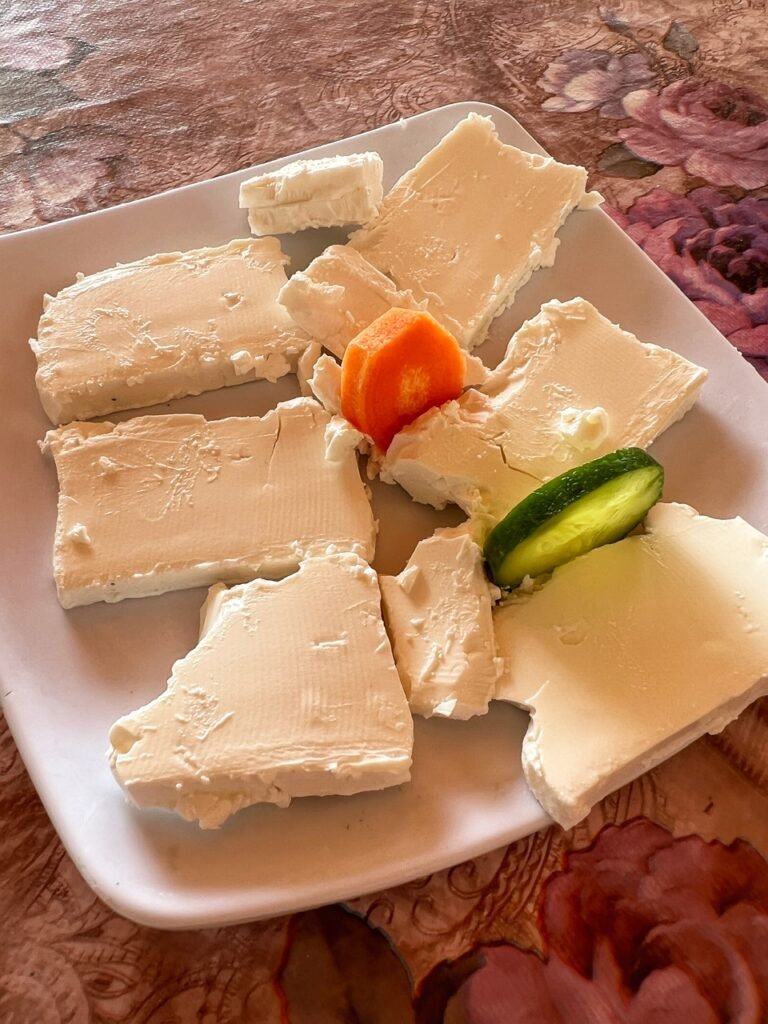
This cheese, similar to feta, was incredibly creamy. We absorbed every plate of it! So yummy.

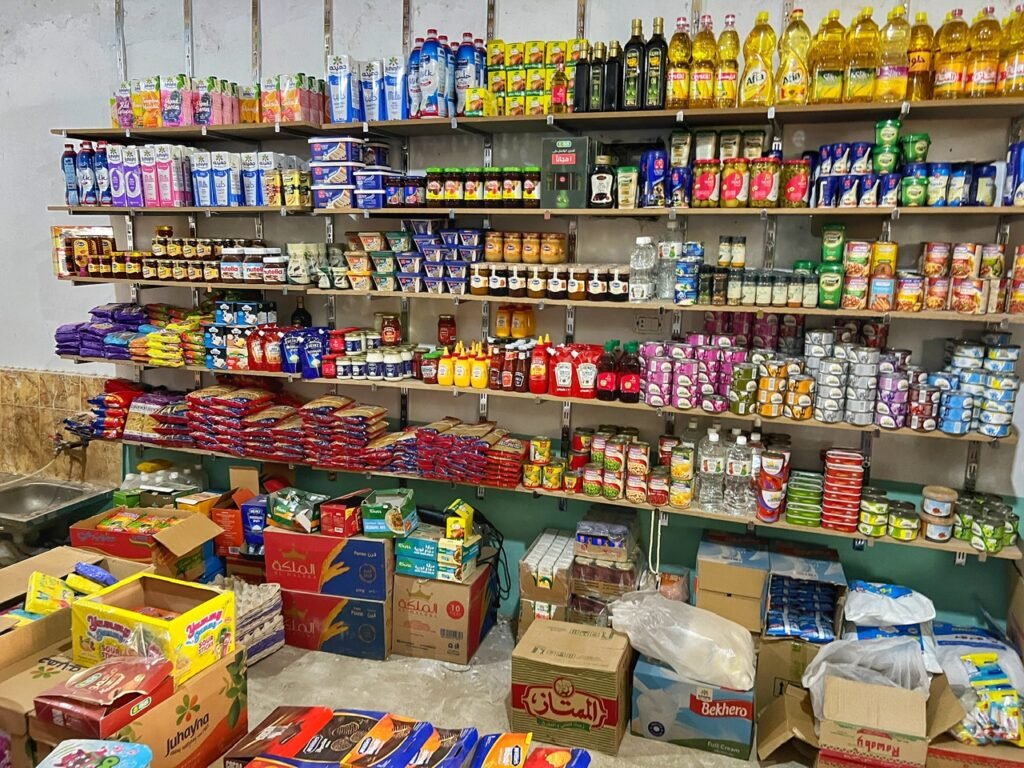
Our local market, Hamada Market, is a one-minute walk! Abdullah’s Market deservedly has 367 five-star reviews on Google.

Abdullah, the shopkeeper with a warm smile introduced himself immediately and promised to be fair and upfront with his pricing. Apparently, the west siders are doing everything they can to make up for their bad reputation among tourists. When we took everything to the register he even added up every single item with us and confirmed we still wanted it. We bought several days’ worth of groceries for about $10 and went back several times. The only downfall is he did not have fruits and veggies.
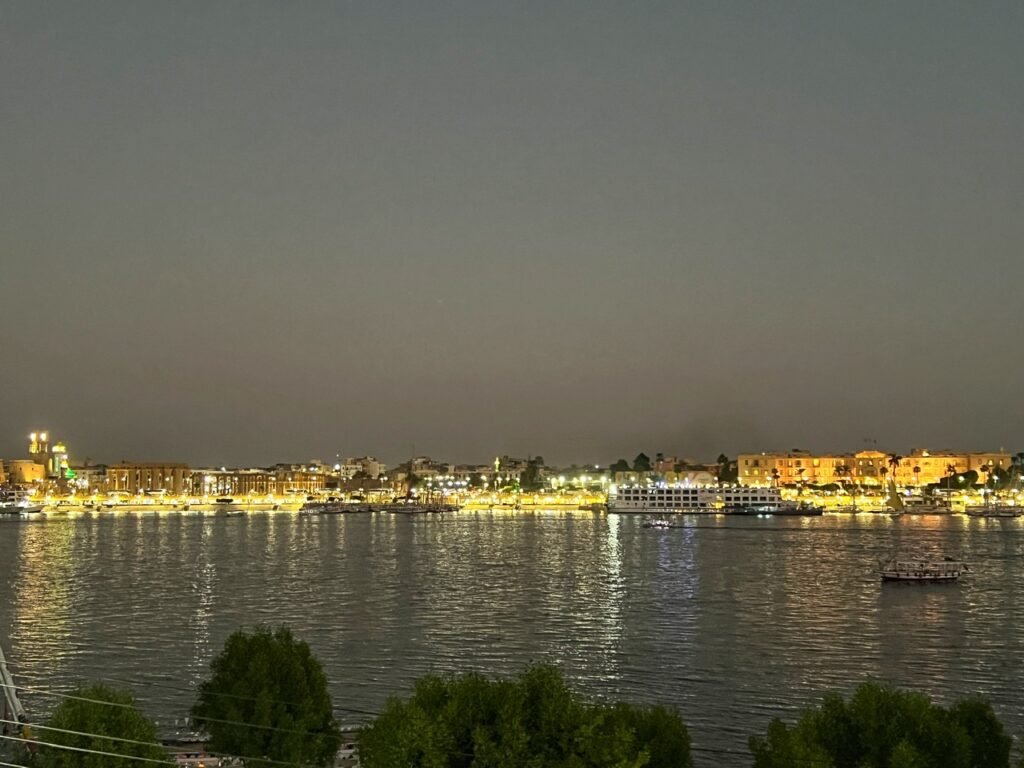
The Nile by night.
Taking Local Transit
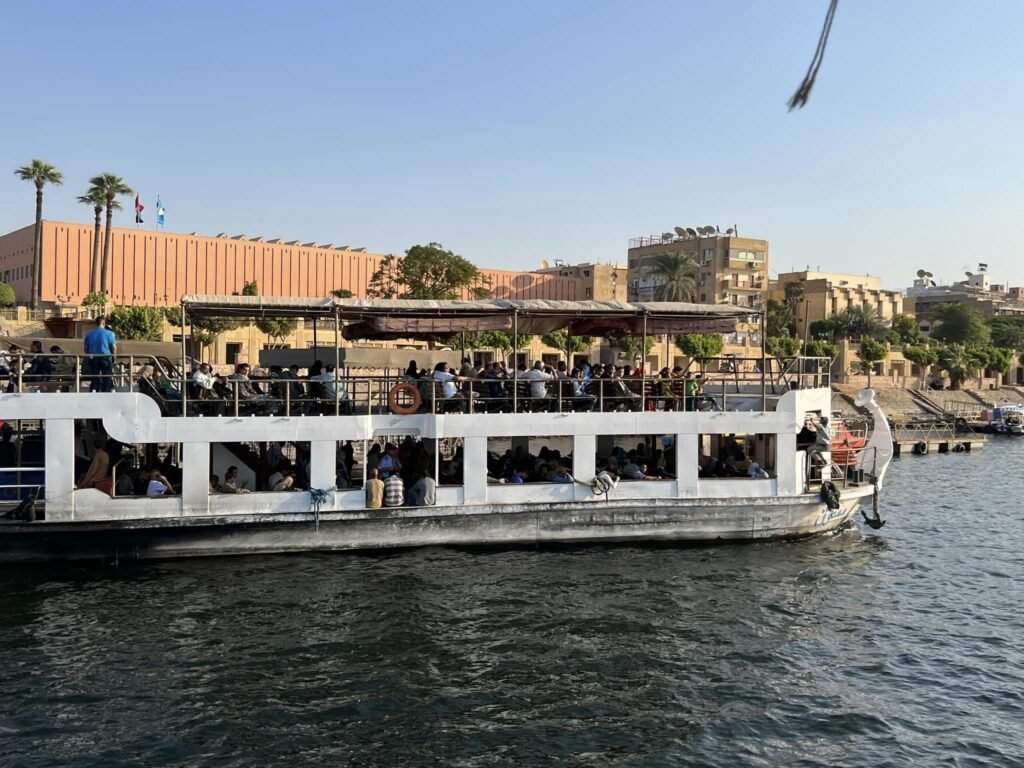
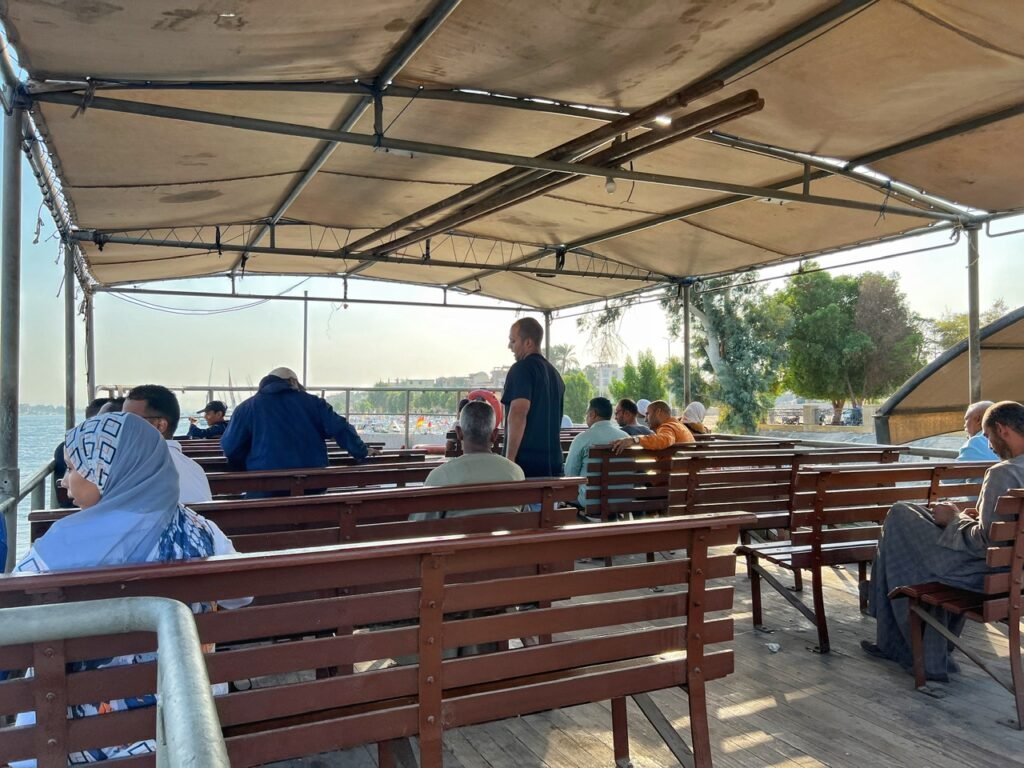
Speaking of staying away from the schemers, we highly recommend taking the public ferry from the west to east bank every single time. It costs 5 Egyptian Pounds ($.20), no matter what anyone tries to tell you and doesn’t close after dark! Just walk up with confidence and give your 5 pounds in EXACT change to the man at the dock before boarding.
For the love of budget travel, do not pay $5-$10 to cross the river every time!! ![]() You can even find it listed on Google Maps for the West Bank, and the East Bank pick-up is north about 50 meters from the Luxor Museum.
You can even find it listed on Google Maps for the West Bank, and the East Bank pick-up is north about 50 meters from the Luxor Museum.
We usually had to wait about 10-20 minutes for it to fill, which was well worth it for the savings!
Karnak Temple
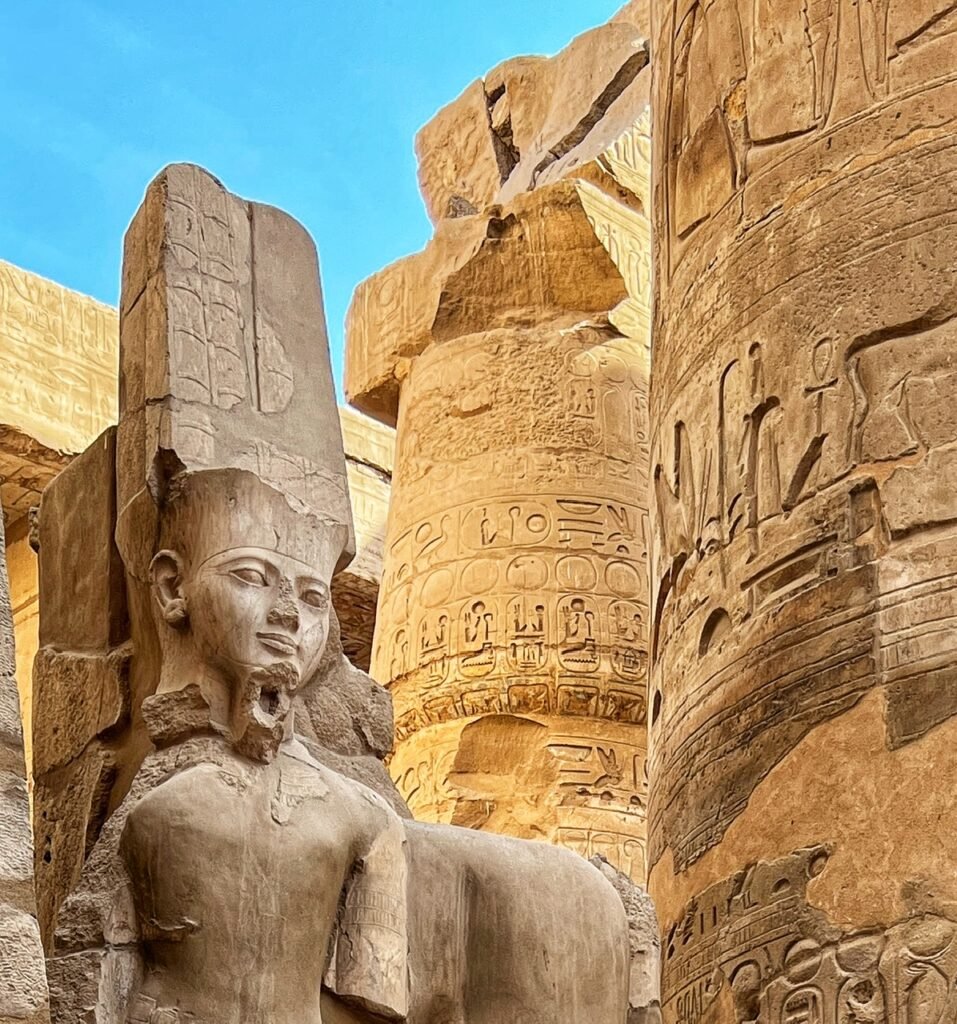
From our safe haven at White House Apartments, inevitably we knew we had to venture out for the reasons we’d come to Egypt…to see the sights. The first day we visited the east bank’s Karnak Temple via $.20/ticket public ferry (not $5 special-deal-just-for-you! private taxi!) and our own two feet. And, no, we don’t need a guide for Karnak, shukran. We also don’t need to see “special site” behind barricaded walls for baksheeh. To enter, it costs 220/Egyptian per ticket. ($9) Again, you need exact change and cards are not accepted.
Despite this, because Karnak was our first Egyptian site, we were in sheer astonishment when we arrived. The moment is completely surreal when years of history books and National Geographics suddenly come to life…the faces, the hieroglyphs all truly bring sheer wonder. Not to mention, everything is simply so massive and grand.
Karnak Temple is actually one of the largest religious complexes in the world, which at one time covered 247 acres and features a sea of erected columns, temples, shrines, statues and obelisks. It was fittingly called Ipet Sut “The Most Select of Places” by the ancient Egyptians and was the most significant of all Ancient Egyptian temples. It is a veritable comprehensive record of ancient Egyptian history and architecture for over 2000 years from the Middle Kingdom (c. 2034-1650 BC) to the Roman Period (30 BC- 306 AD).
Karnak was the primary cult centre of Amun, but also the home to more than one god as Montu ‘Theban god of war’, Mut ‘the wife of Amun’ and their son Khonsu.
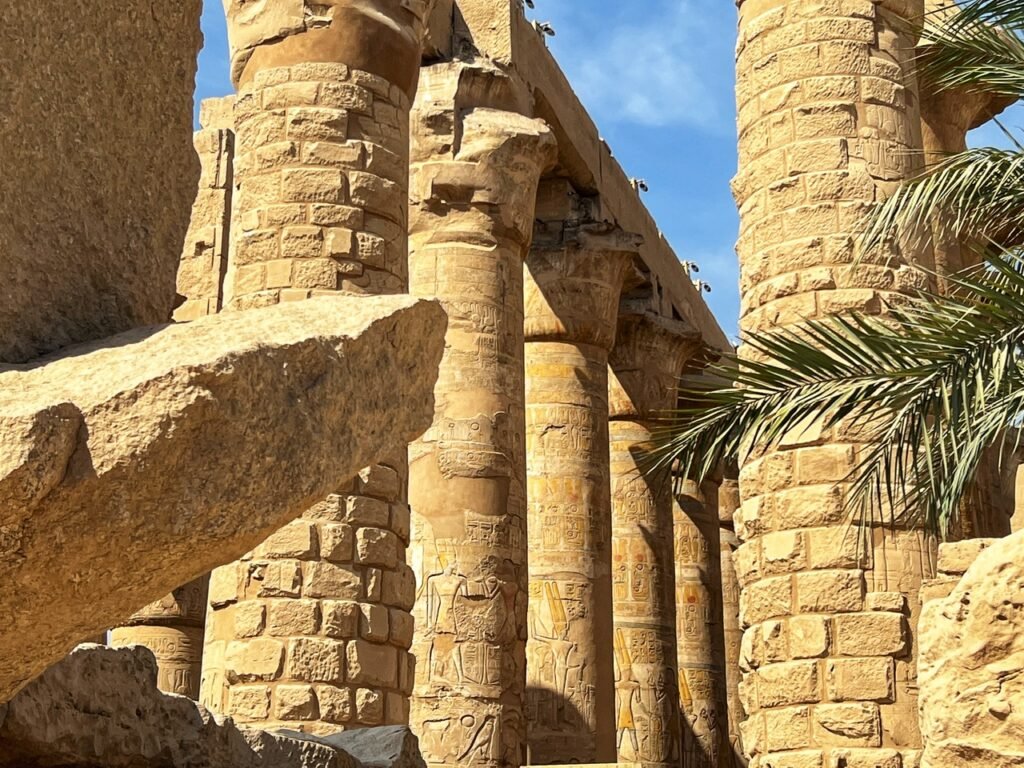
The most striking part of the complex is the world-famous Great Hypostyle Hall.
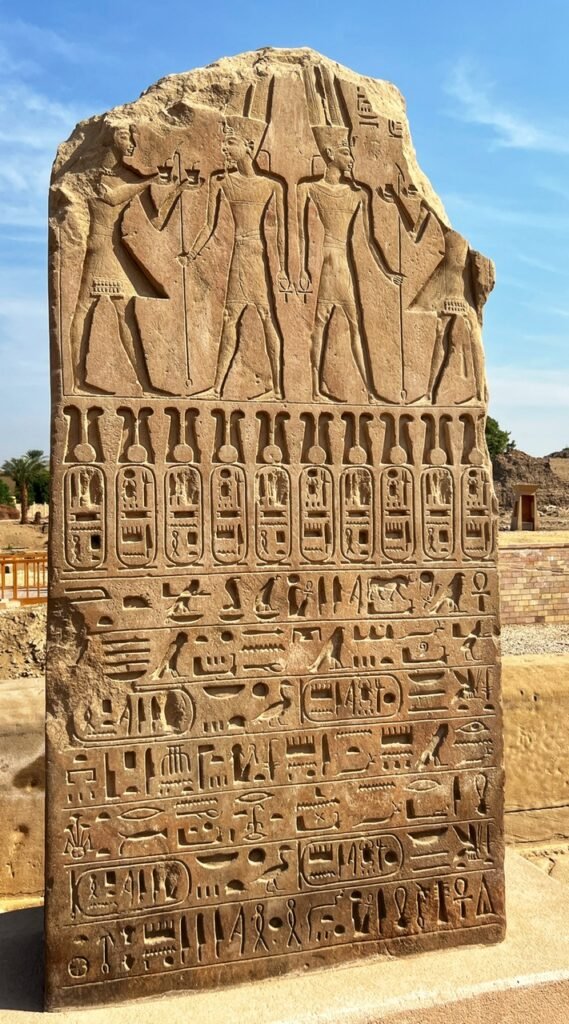
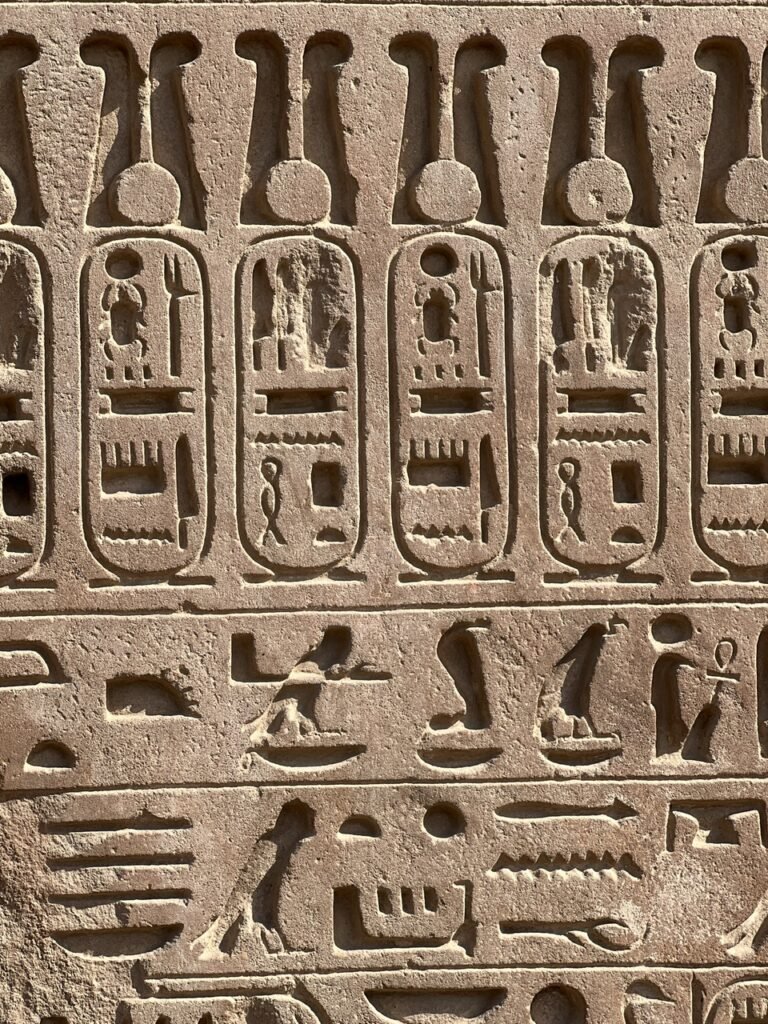
Encountering emojis of yesteryear…our first hieroglyphics (4th-grade art class aside.)
A few facts about hieroglyphics:
-the name comes from the Greek word meaning “sacred carving.”
-Hieroglyphics uses pictures, but it isn’t picture writing, which is a common misconception. For example, a bird doesn’t mean bird. Instead some hieroglyphs signify sounds (like the Roman alphabet) and some concepts.
-Ancient Egyptians also had a less complicated alphabet.
-Hieroglyphics could be written either from left to right, or right to left, and vertically as well as horizontally. Crazy!
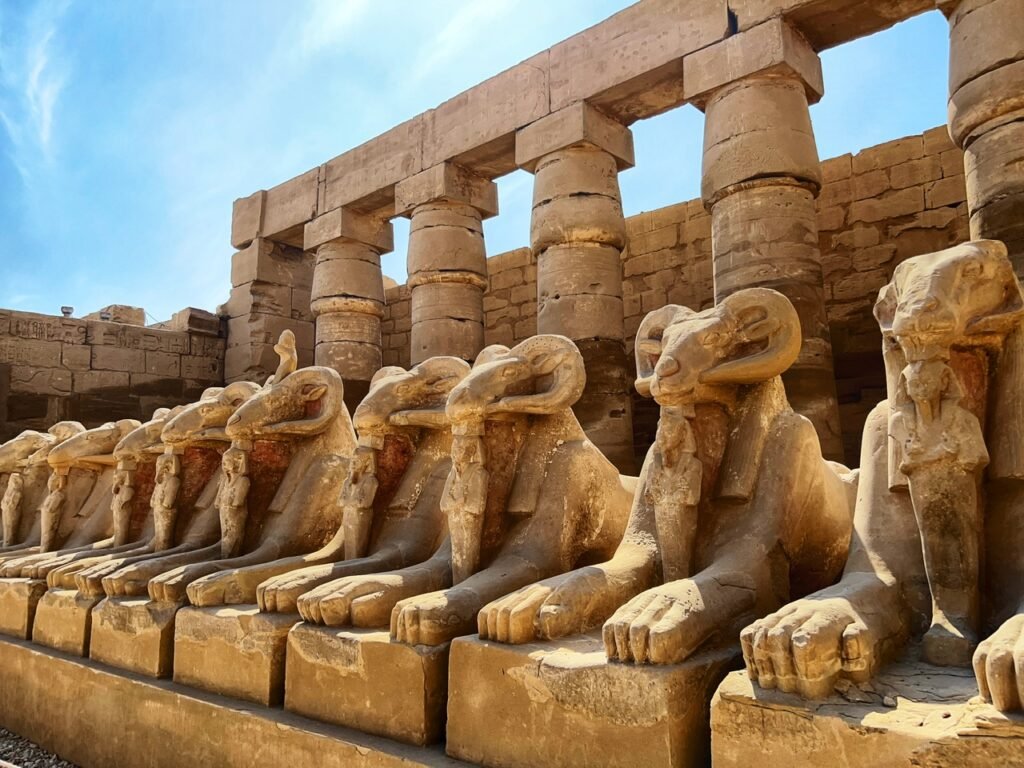
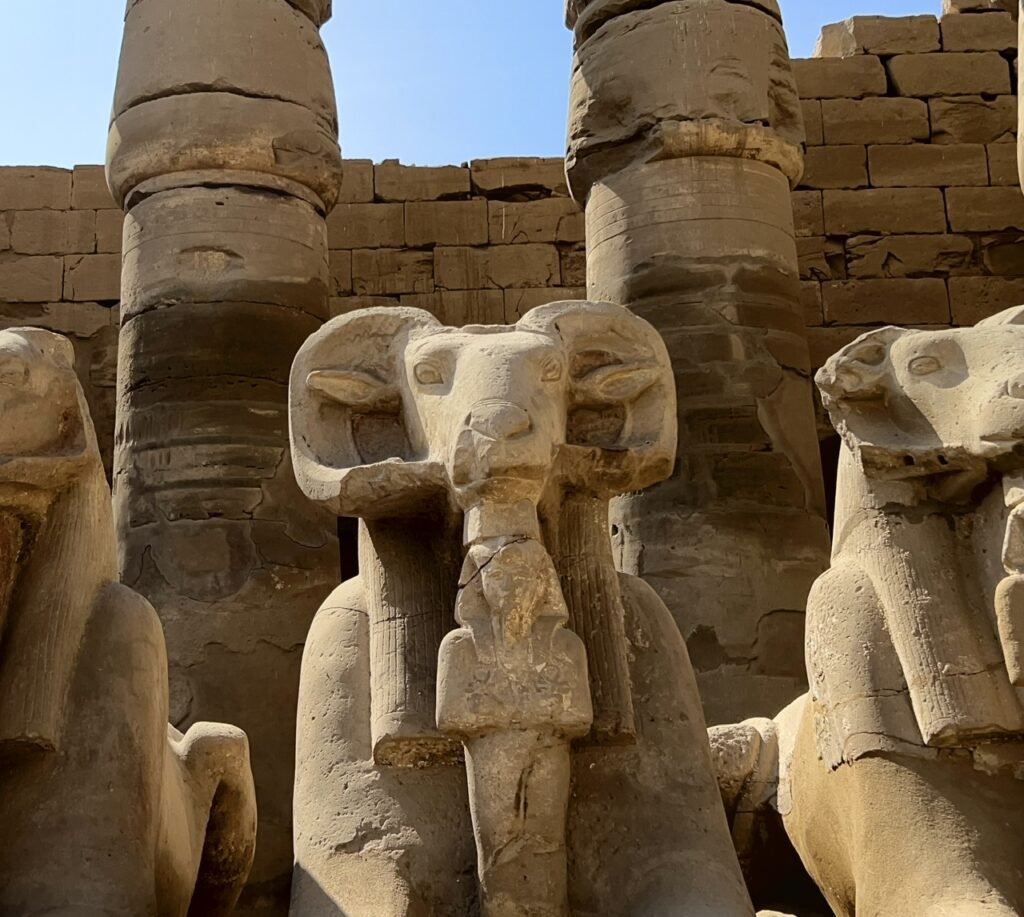
Rams, seen as a symbol of fertility, were identified with various gods, including Amun, the great god of the city of Thebes (now Luxor). Ram-headed sphinxes fringe the entrance to the Amun Temple within Karnak. Rams were so revered that the bodies of some were mummified and equipped with gilded masks and even jewelry.

Mandy standing in front of her college mascot. And something a little more historical than UNC-Chapel Hill.

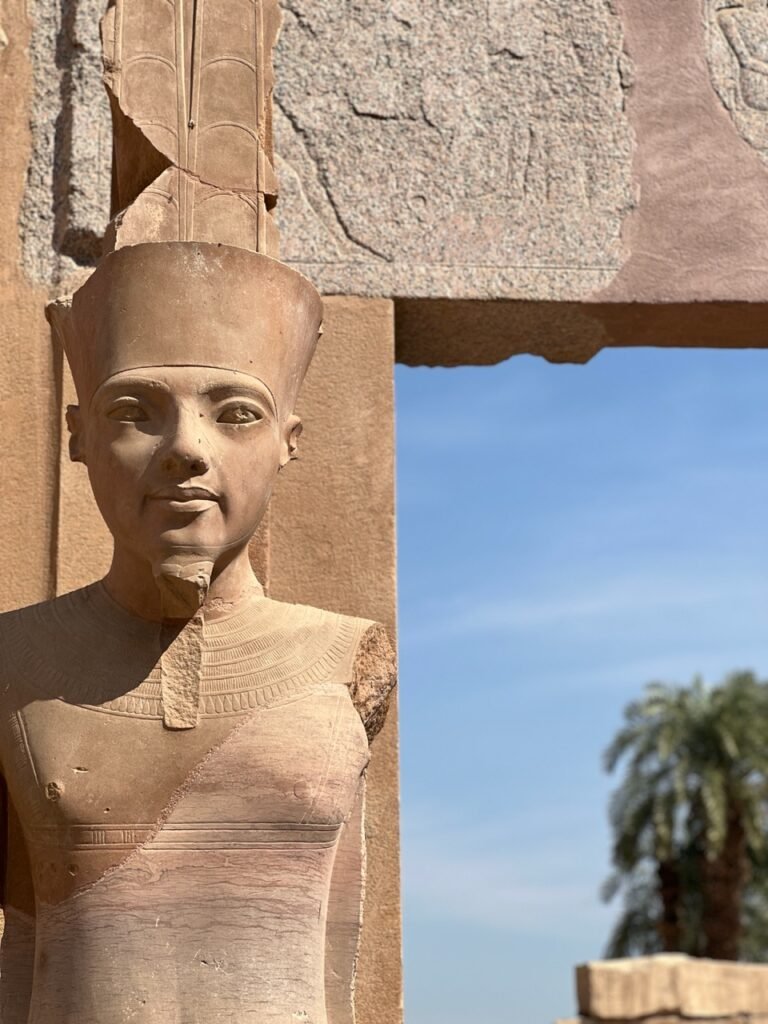
The Statue of Amun within the Temple of Amun. This temple was built by Ramesses III, a king who reigned from 1186 to 1155 B.C.
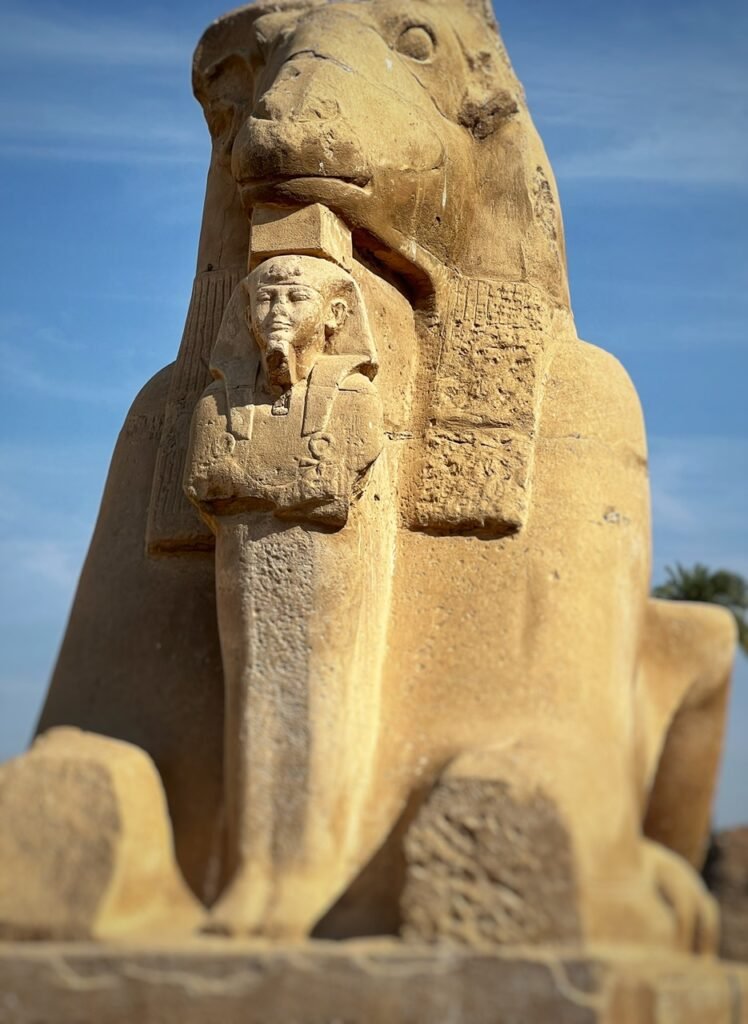
Nice head rest.
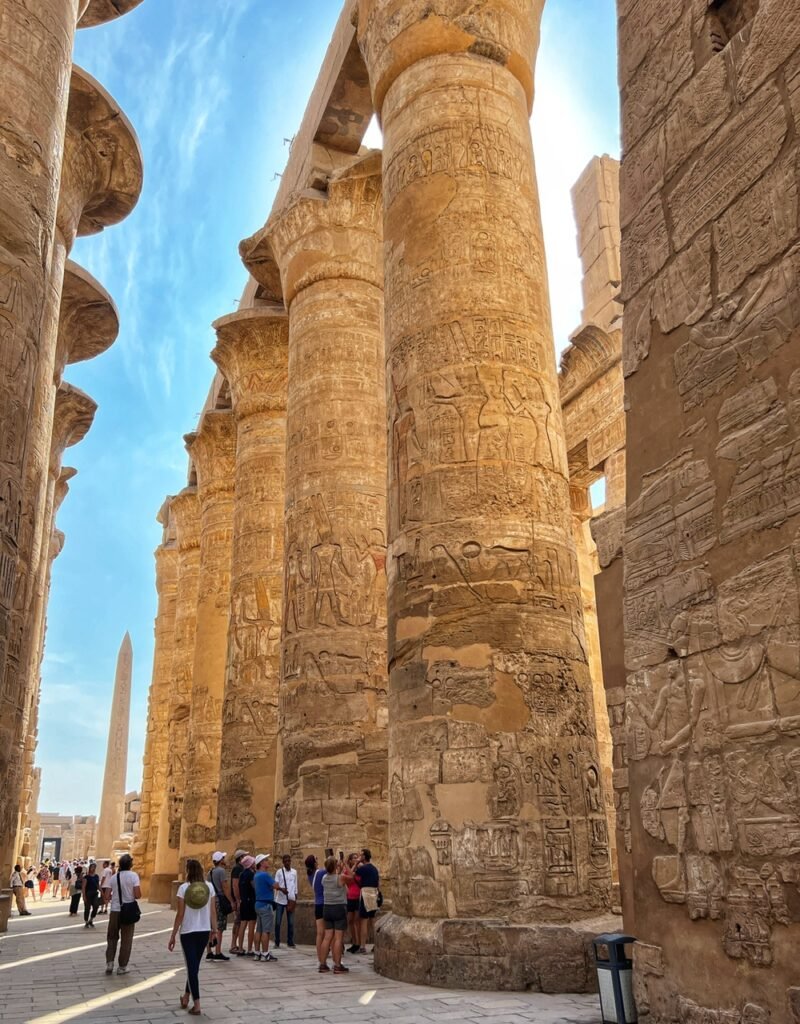

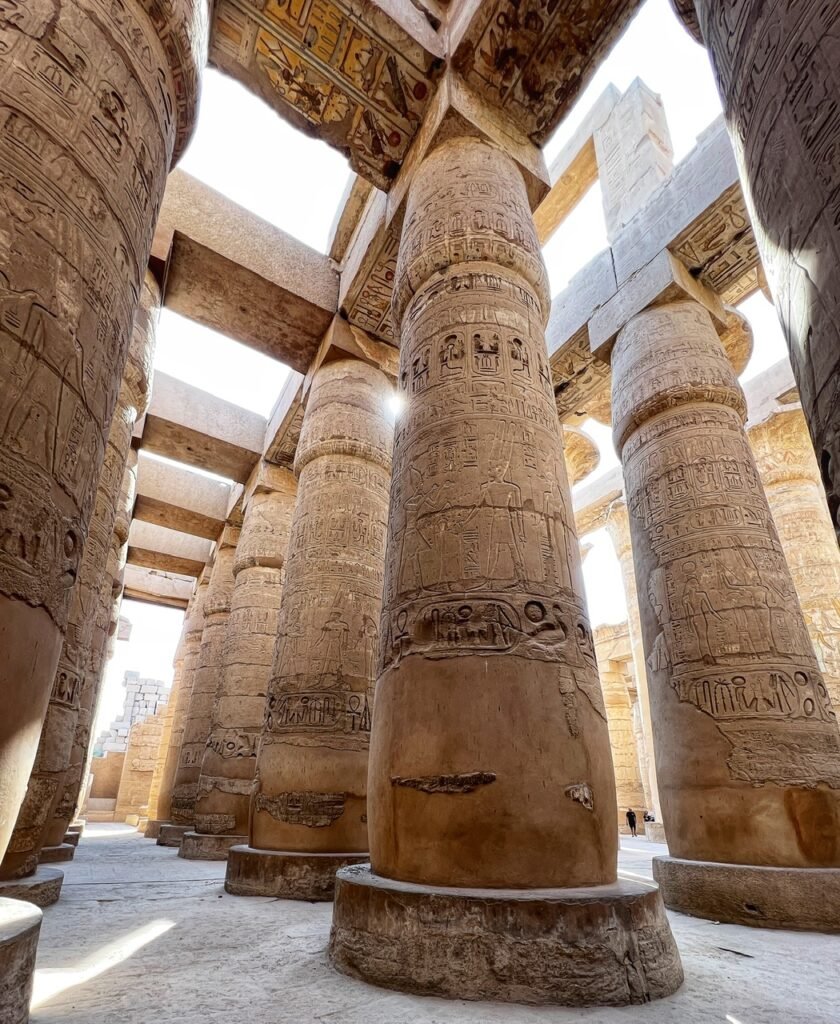
The Great Hypostyle Hall with its towering 134 columns at a height of 15-21 meters leaves you utterly awestruck.

The walls to enter Karnak Temple.
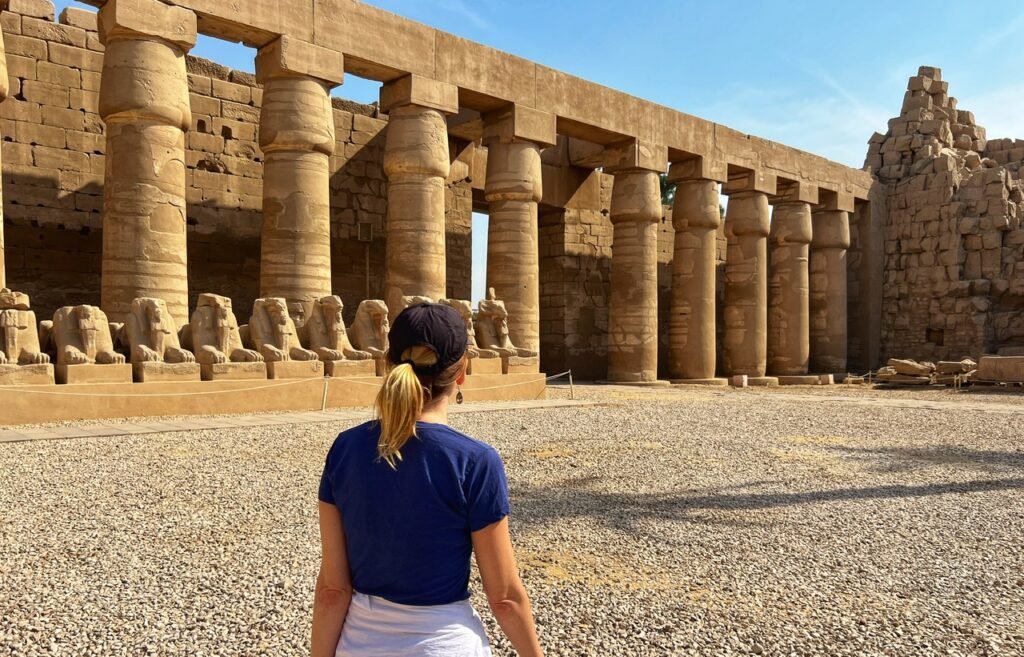
Mandy takes it all in away from the crowds. We arrived at about 9 am.
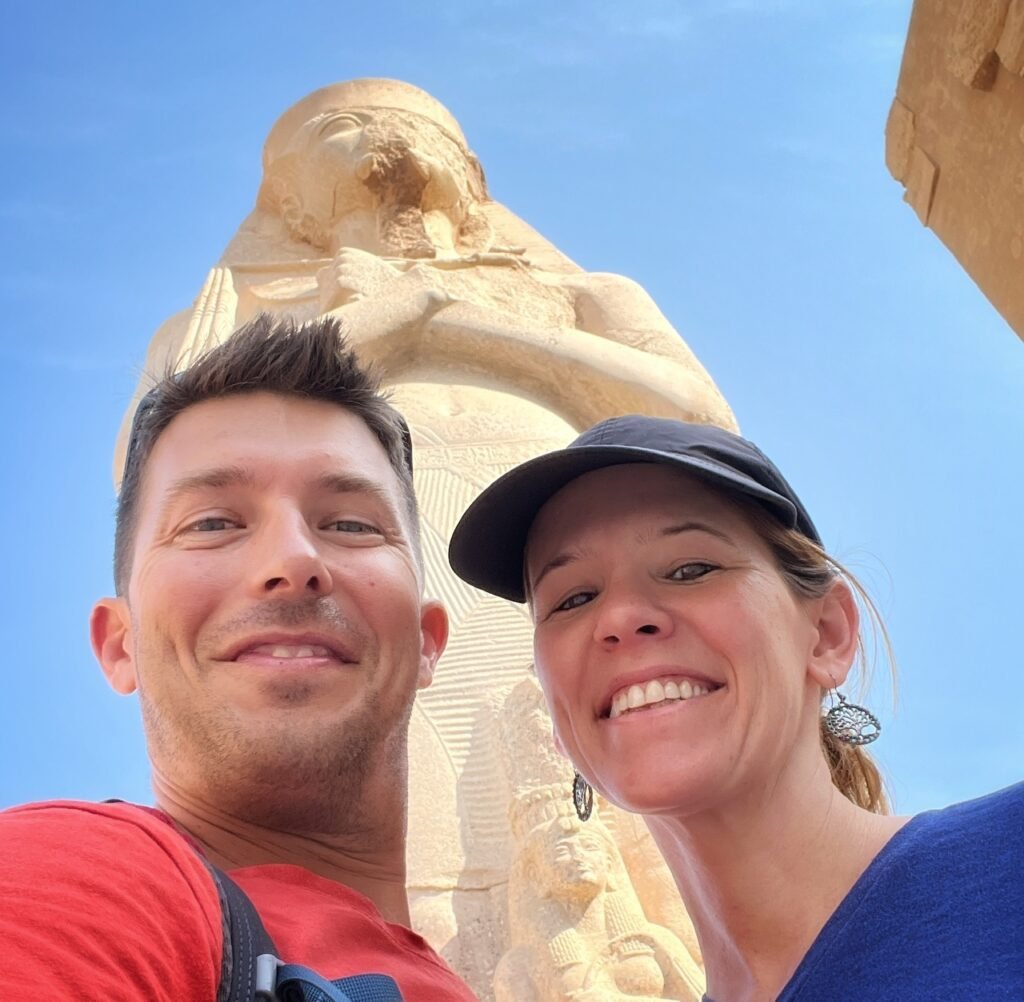
Oh yes! We’re in Egypt!
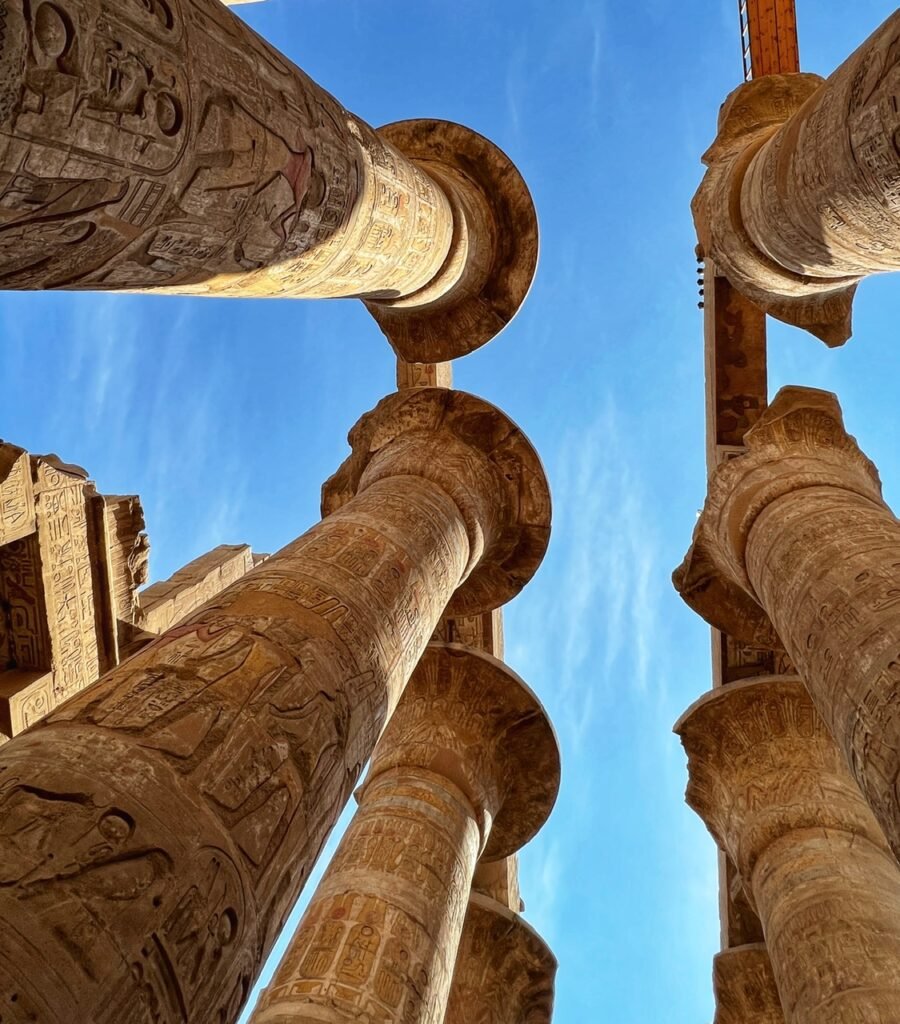
Trying to capture how colossal the columns are in these rows of grandeur.
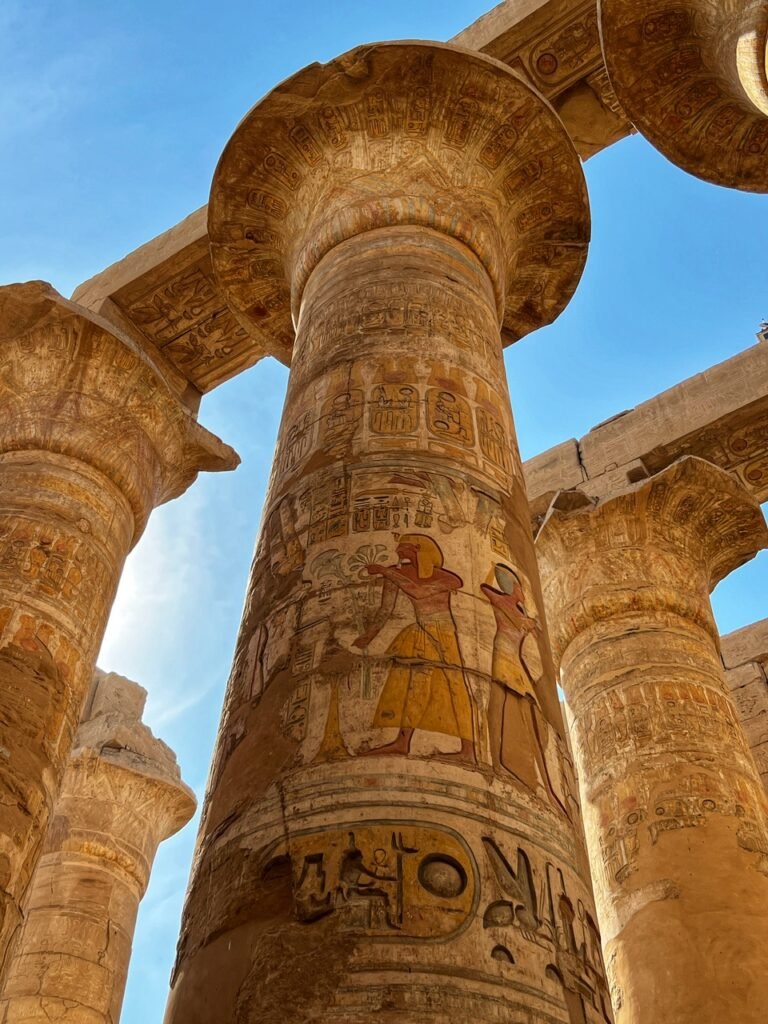

We expected big. But what we didn’t expect was all the color.
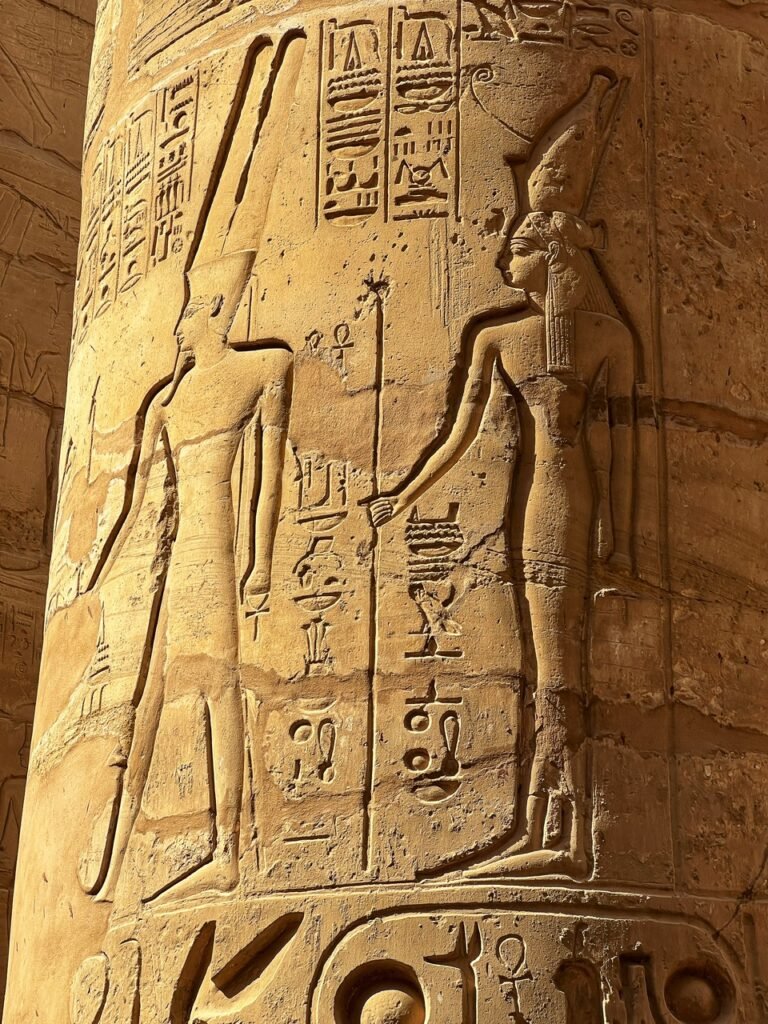
These pharaohs were very lean! 😂
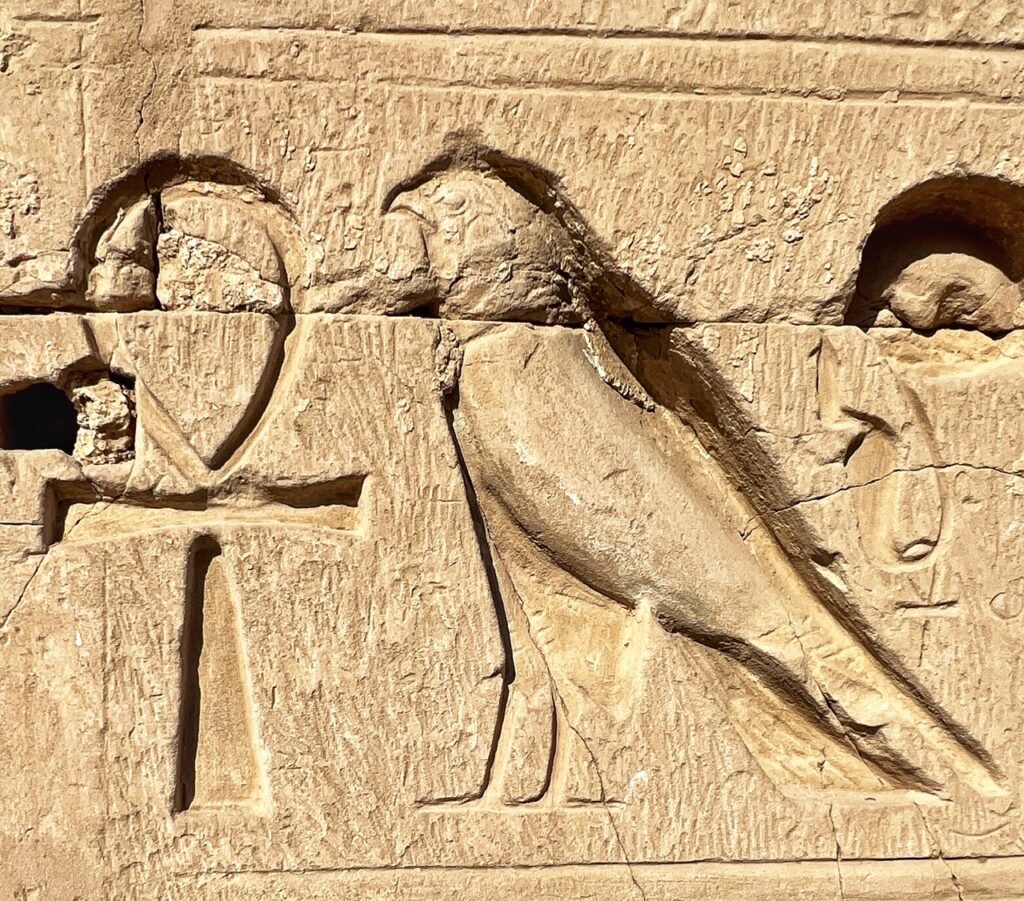
The ankh or key of life at left is an ancient Egyptian hieroglyphic symbol used in Egyptian art and writing to represent the word for “life” and, by extension, as a symbol of life itself. It does not mean you’re an atheist, which is what Mandy learned as a child. 🤣
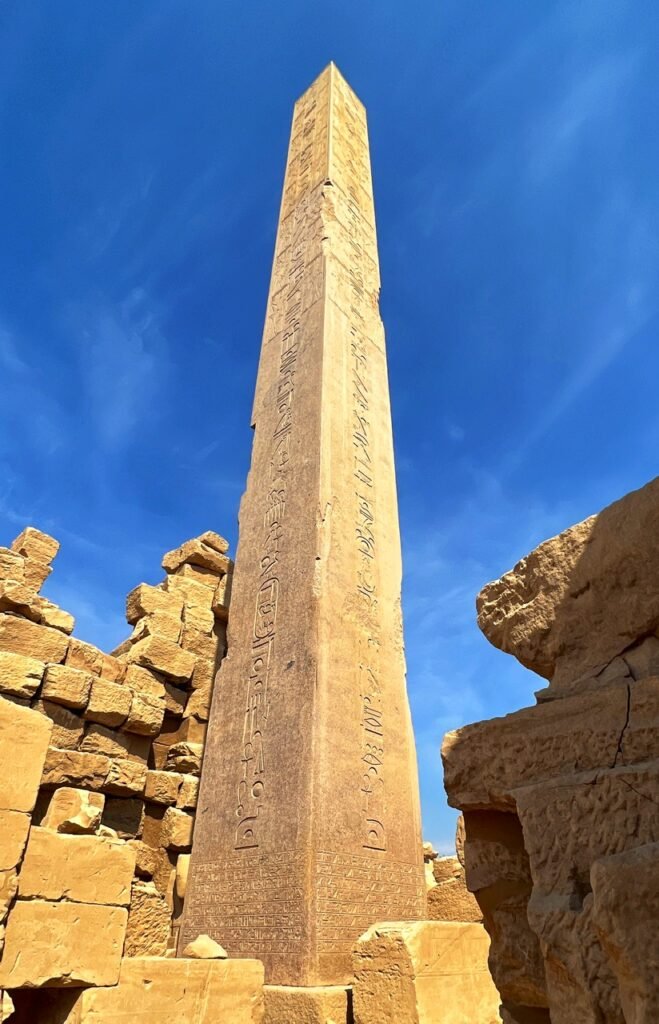
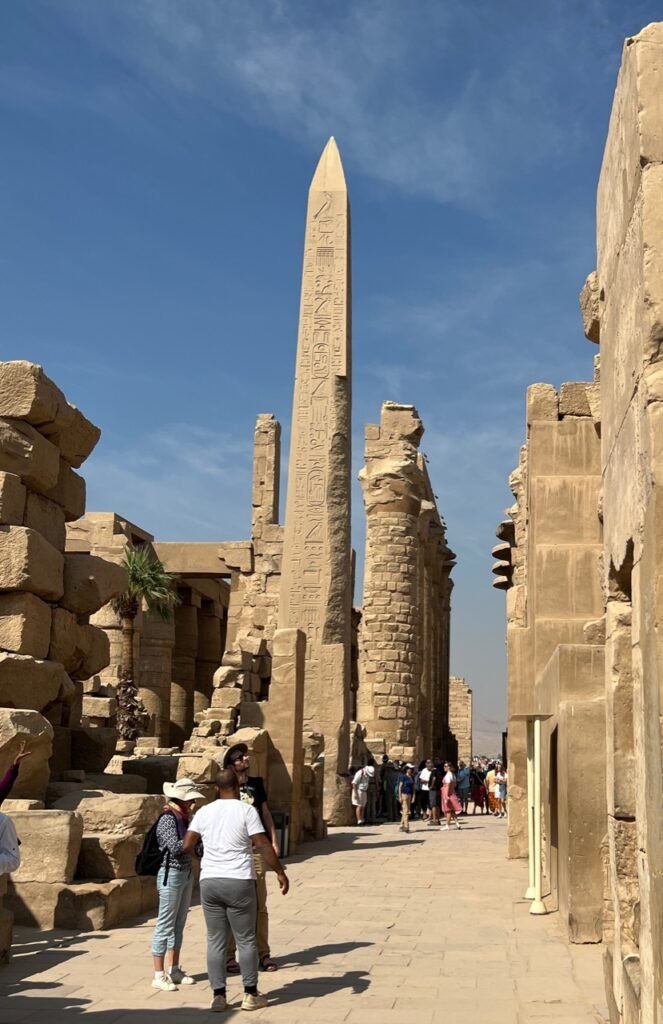
One of the two obelisks of Thutmose I (c. 1504-1492 BC) still stands near the towering obelisk of Hatshepsut, standing nearly 30 m tall.
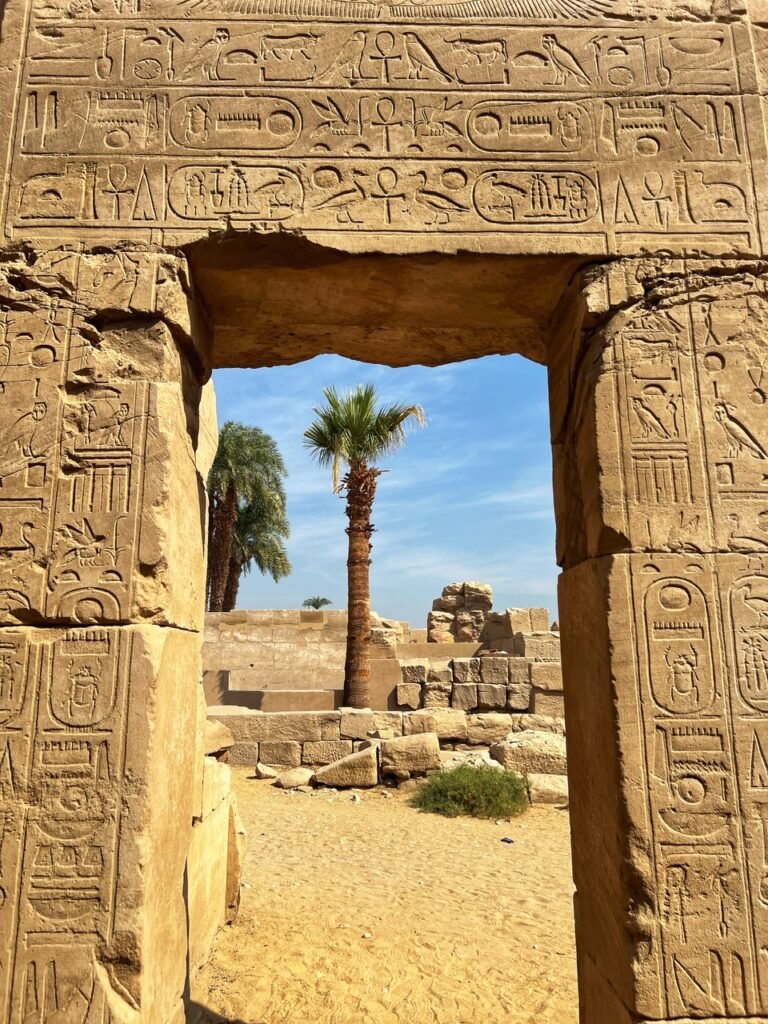
Loved the picture-encouraging doorways everywhere!
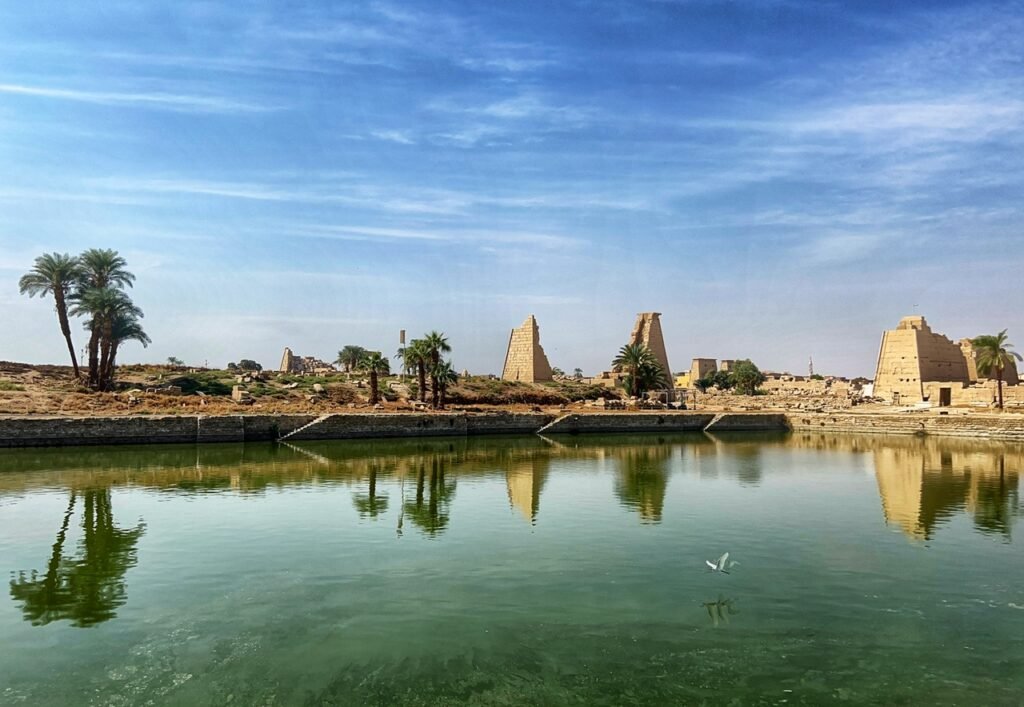
The glistening Sacred Lake from which priests purified themselves before performing rituals.
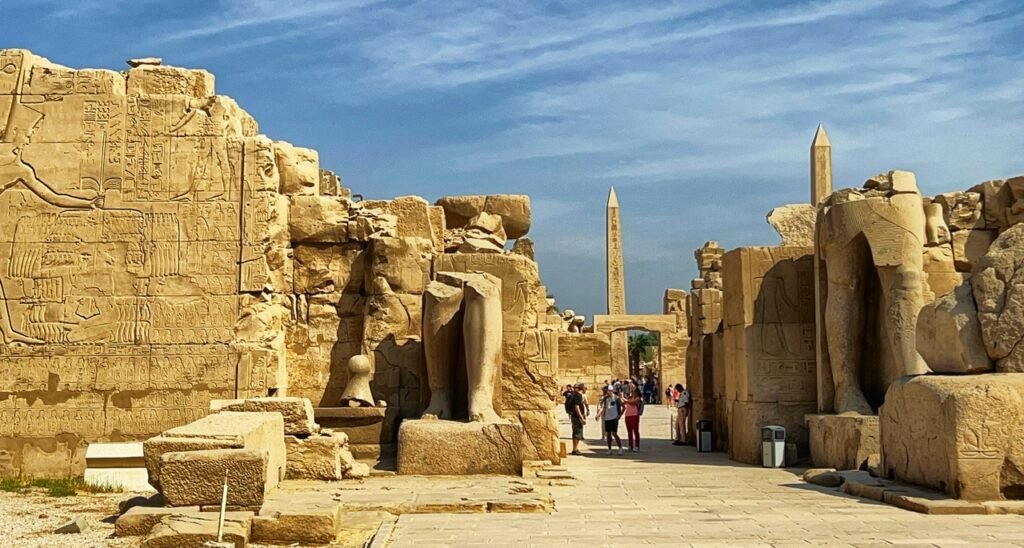
Damn! Check out those legs 😮
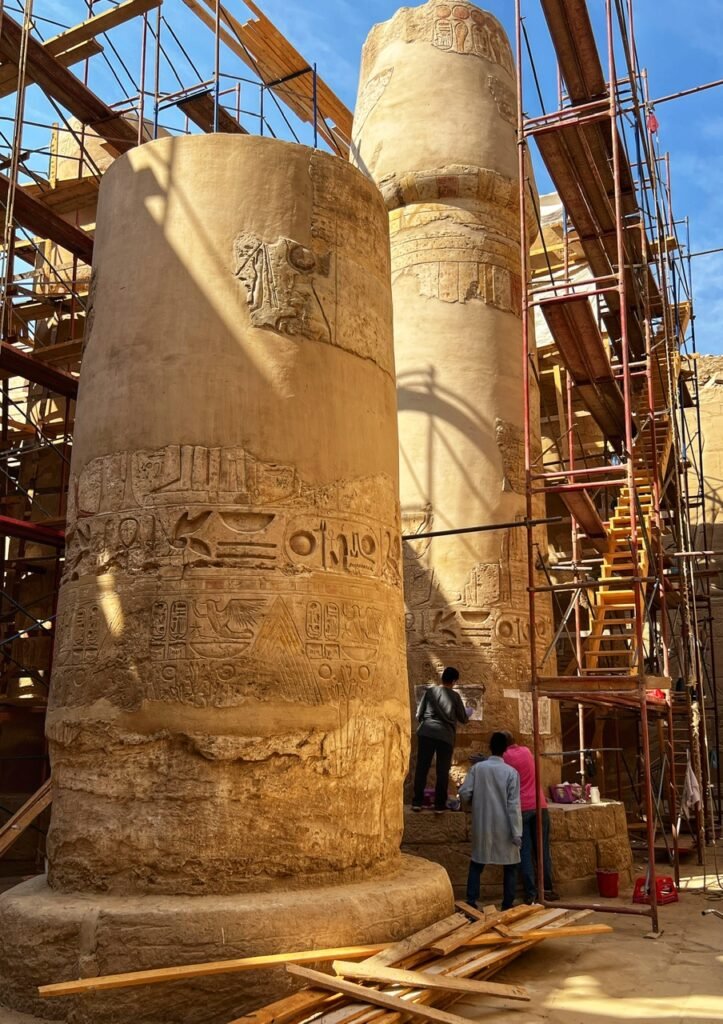

It was fascinating to see the preservation workers in action. One woman appeared to be taking an imprint.
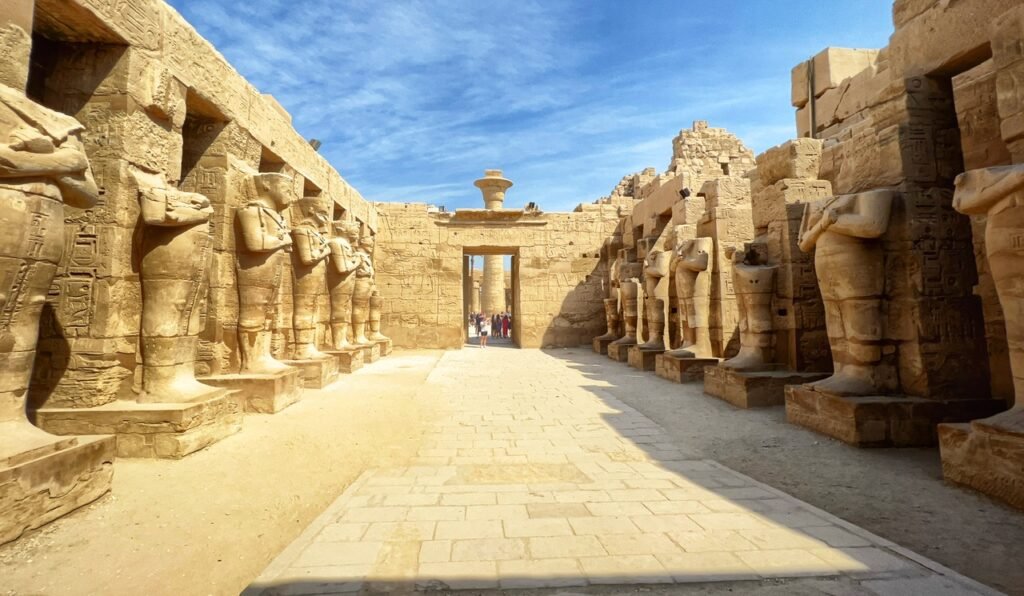
From this angle the column peeping over the door almost appears Jetson-esque.

A good perspective of the scene.
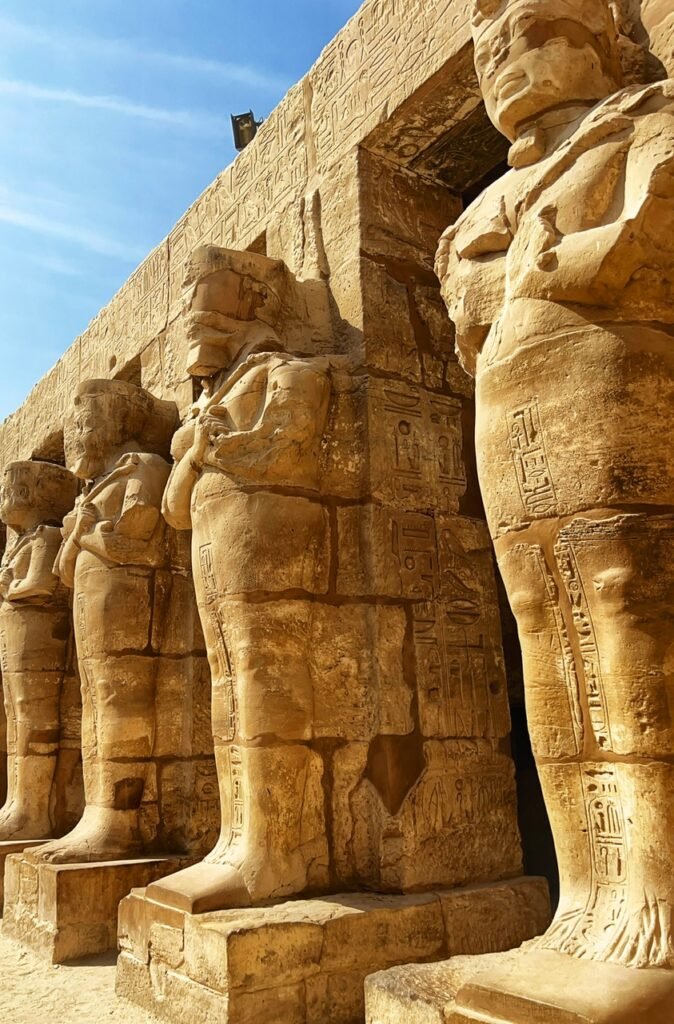
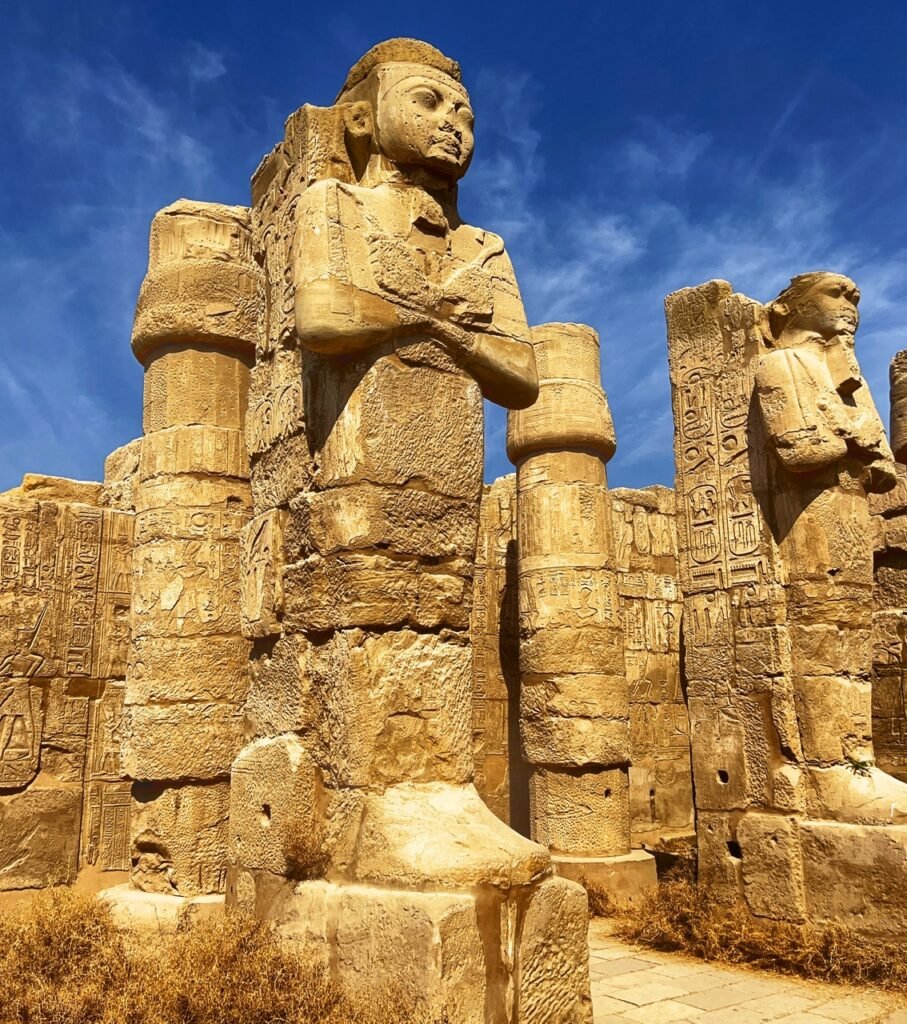

Final pictures of Karnak…Of all the main tourist sites, (including Luxor Temple, Valley of Kings and Karnak), Karnak was by far the most impressive, so if you only have one day, we’d recommend it most.
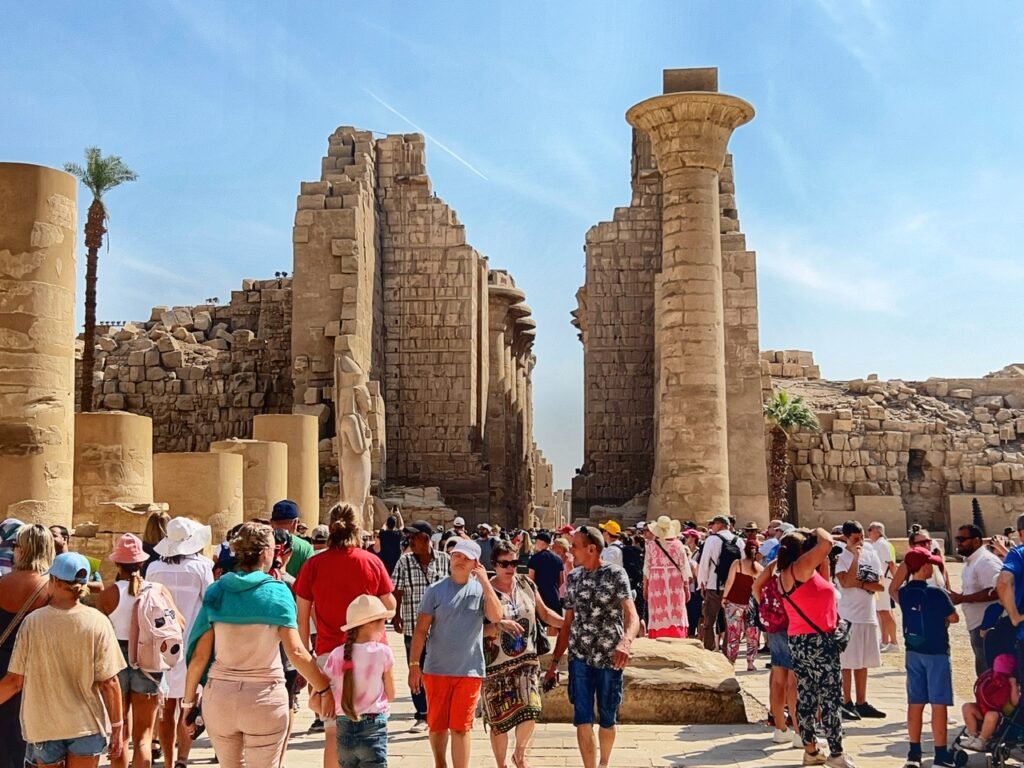
The tour buses arrived at 10 am. It was time to make our escape!!
Valley of the Kings
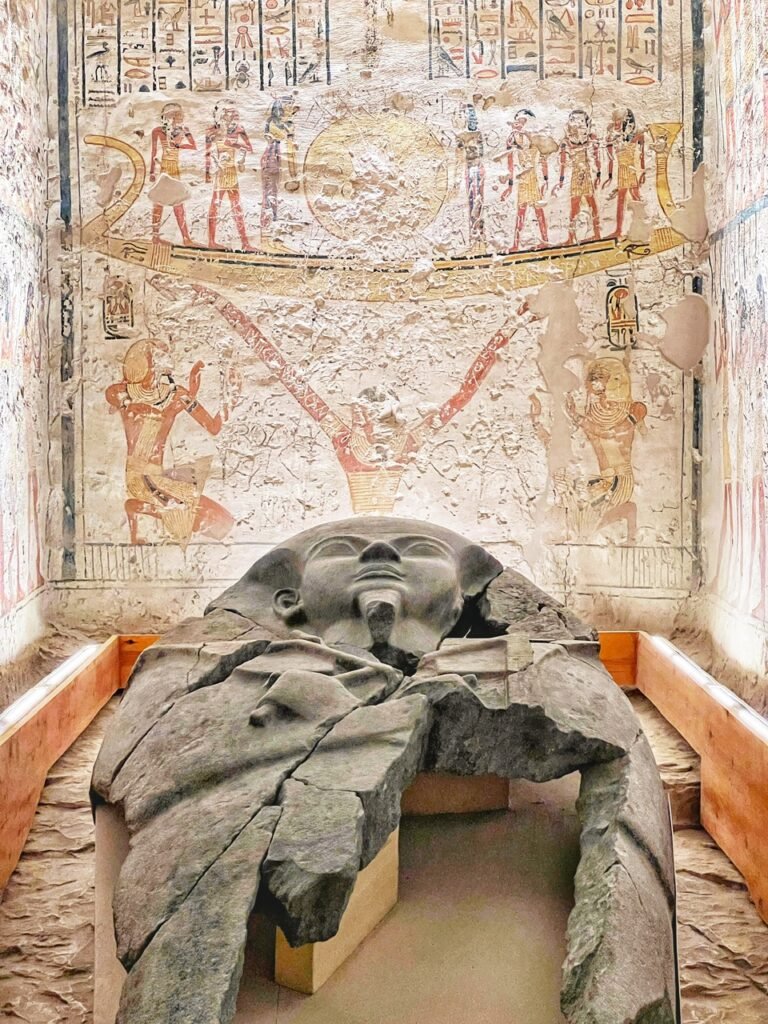
After the Pyramids, the Valley of the Kings is arguably one of the most legendary sites from the Ancient Egyptian Empire and was used for 500 years (16th-11th Century BC) as burial grounds for Egyptian royals. They were buried here in readiness for afterlife, which included all their possessions. So, evidently, the Egyptian Queens (and Kings) must have been some of the first “Material Girls.” (And Boys)🤣
There are 63 tombs in total and 18 are open to the public. Of these, only three are included with your entrance fee of 220 Egyptian pounds ($9). Do you want bonus, far-less-stenchy and crowded tombs? Those will be around $5/ticket each. But you must research in advance which ones you want to see or it’s a bit overwhelming.
To visit the site, as well as others, we did decide to hire an Egyptologist guide for the day for $30/each. While it was definitely informative, it was probably not necessary. We could have easily done it on our own. However, it is always helpful to have an educated guide (or bodyguard depends on how you look at it.)
For our “bonus” tomb, we chose the tomb of Ramses V & VI. Why two kings? Well, it was originally constructed by Pharaoh Ramesses V who was interred here, but his uncle, Ramesses VI, later reused the tomb as his own. Ummmm…ok. Nothing like getting kicked when you’re already down.
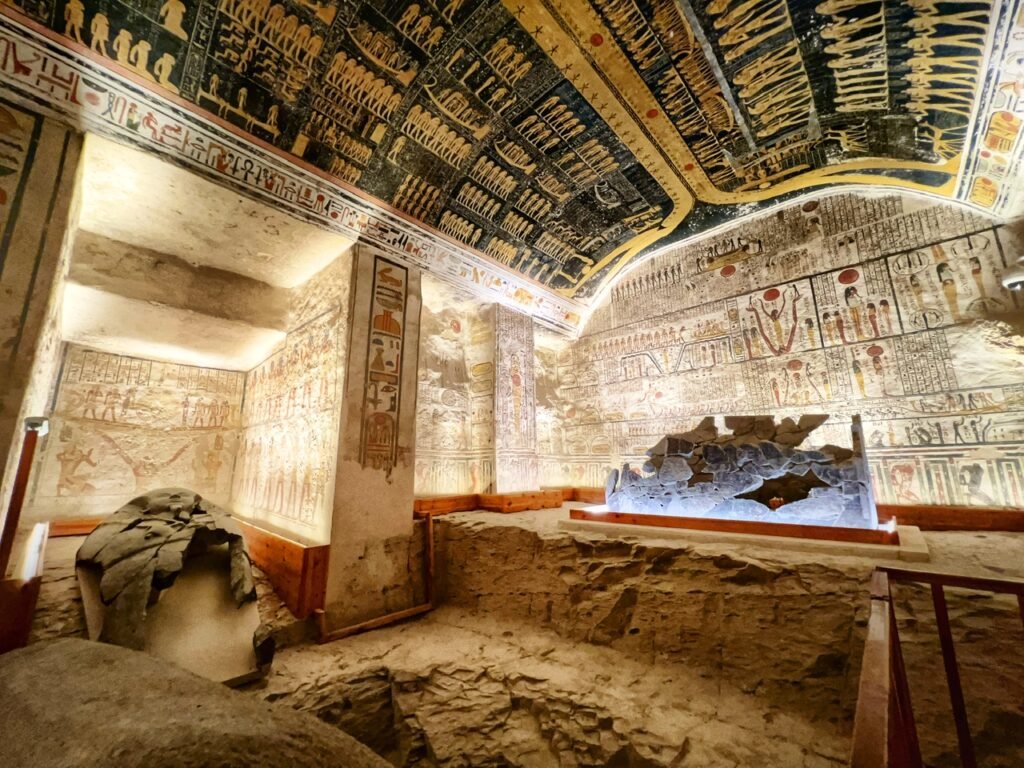
In terms of ornamentation, it’s known as one of the most spectacular tombs in the valley.
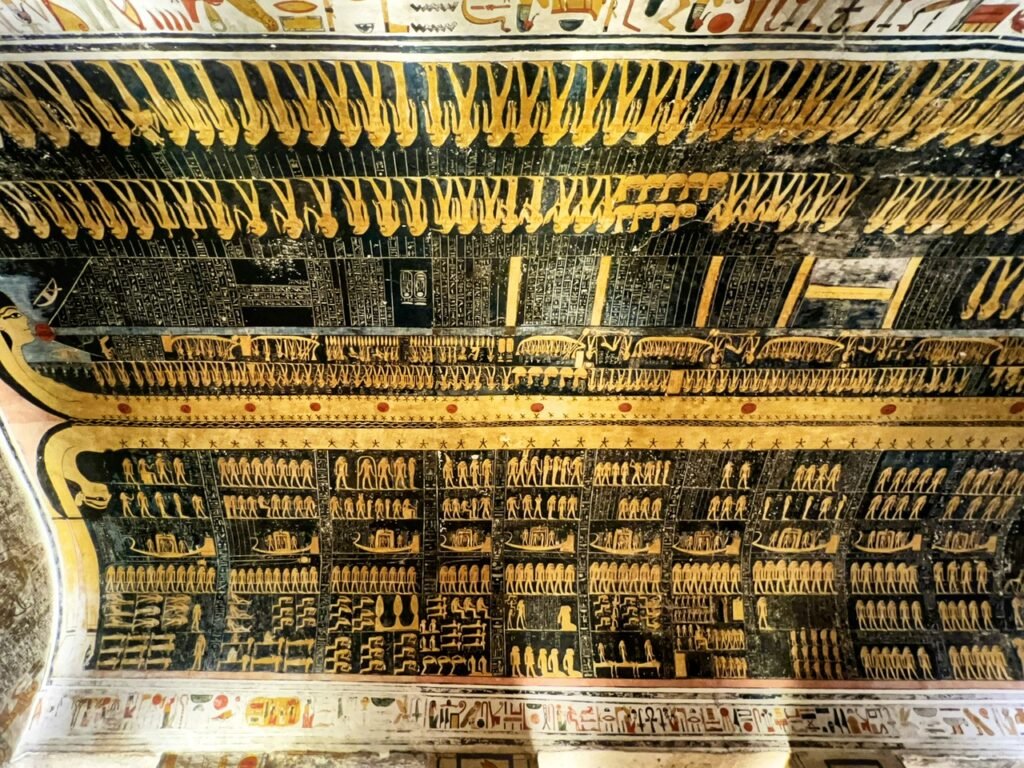
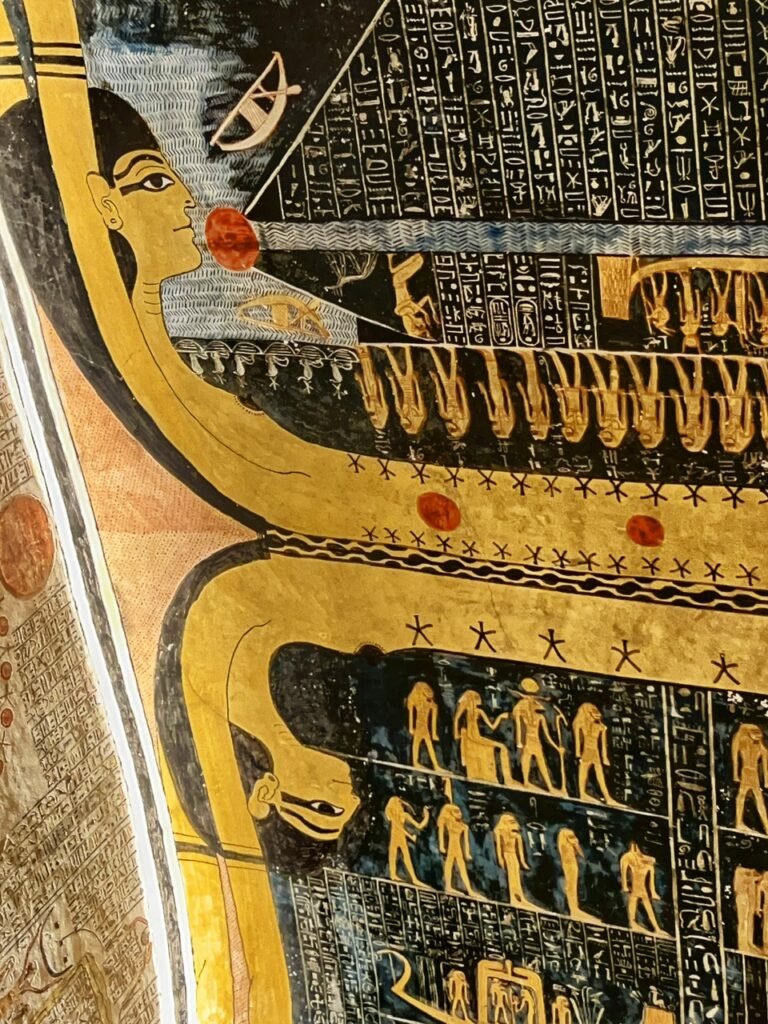
You might assume the long character in the middle is a snake, but it actually connects to a woman’s head. The lines along the snake’s body represent the calendar of the day with each circle (sun) representing an hour of daylight and the second snake woman representing the night.
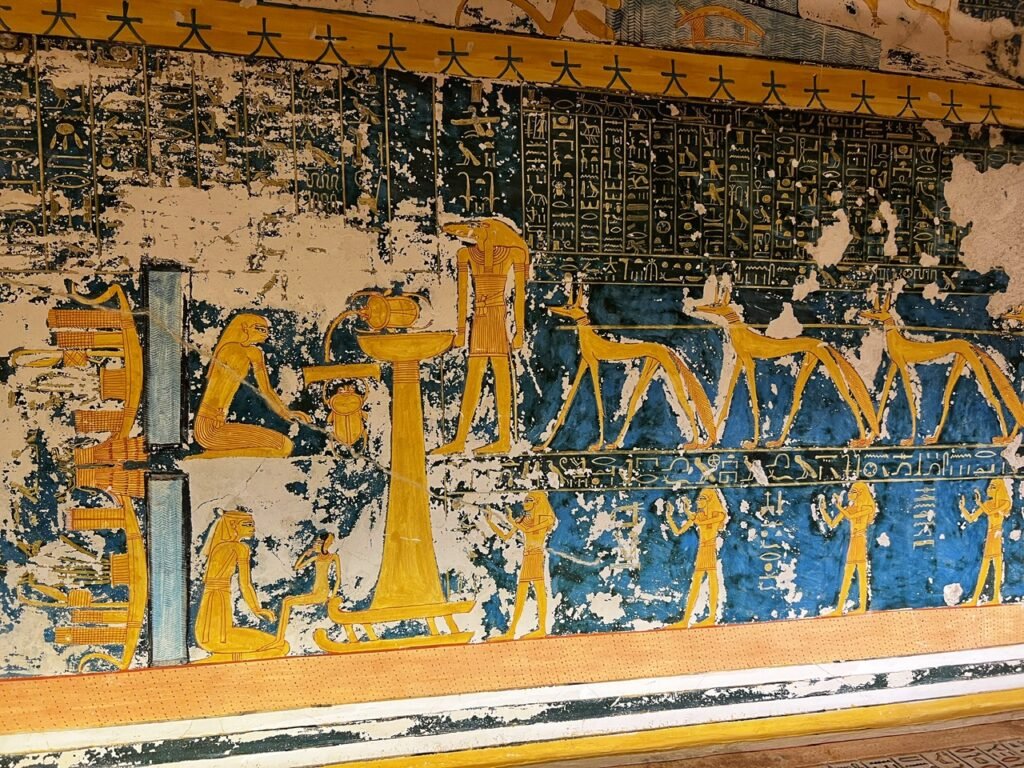
Anubis, the Egyptian dog god, was a deity who presided over mummification and the afterlife. He often has lots of similar real dogs following him around which reminds us of the flying monkeys following around the monkey people in the Wizard of Oz.
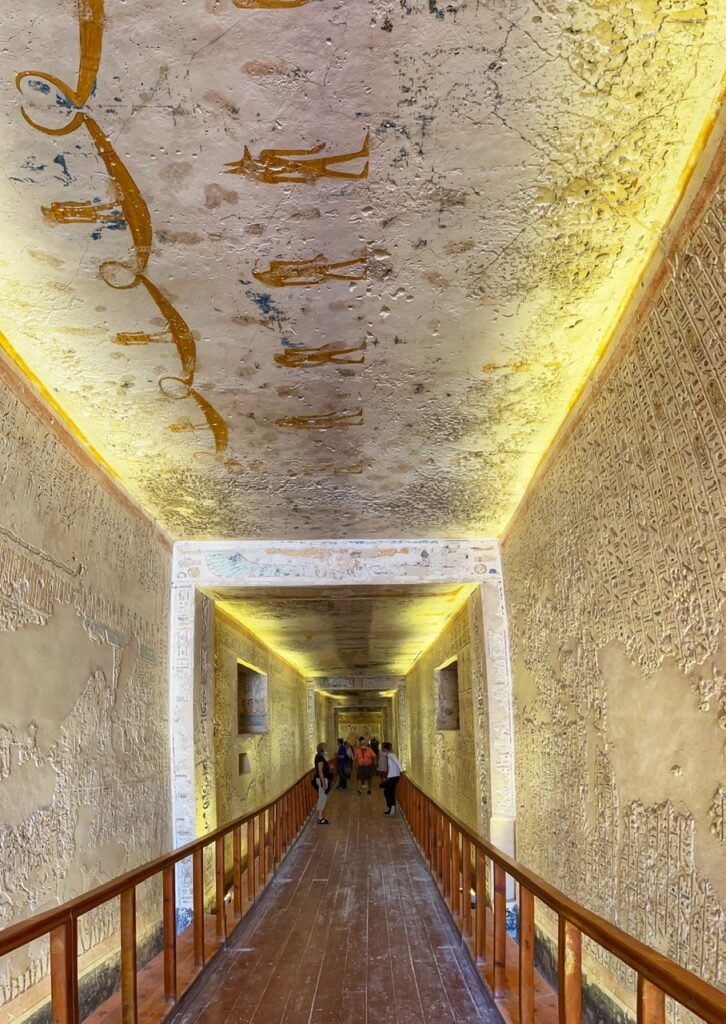
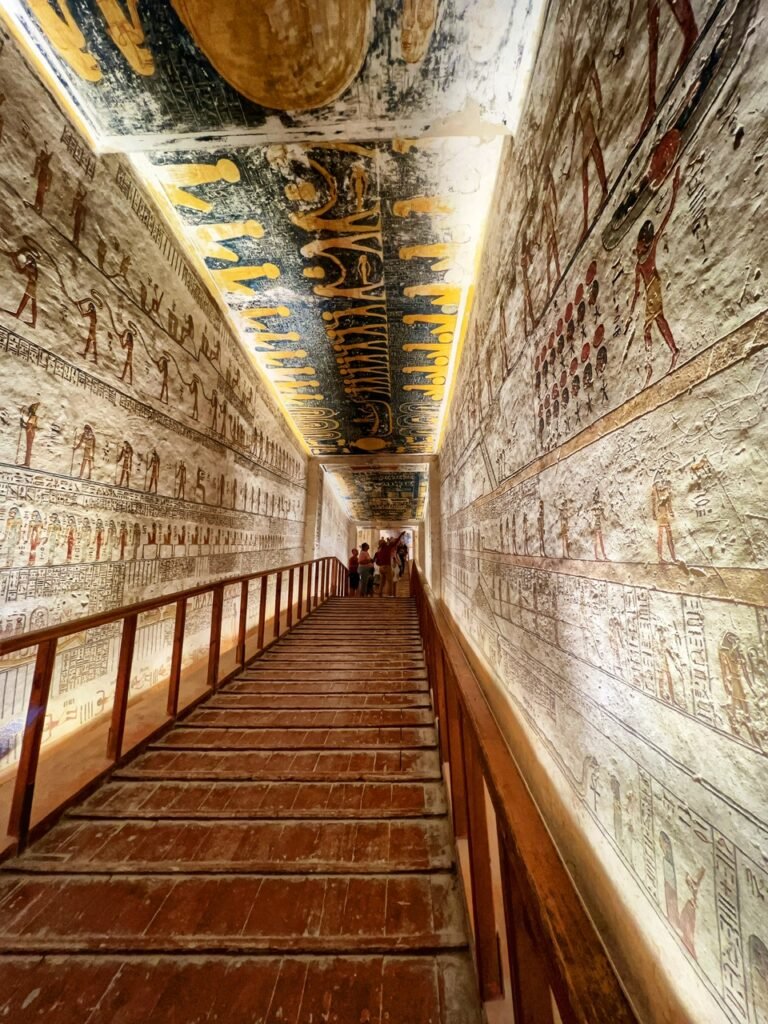
The long corridors to enter the tombs. This one, because it was an extra-cost tomb, was much less crowded than the others. It was also our favorite.
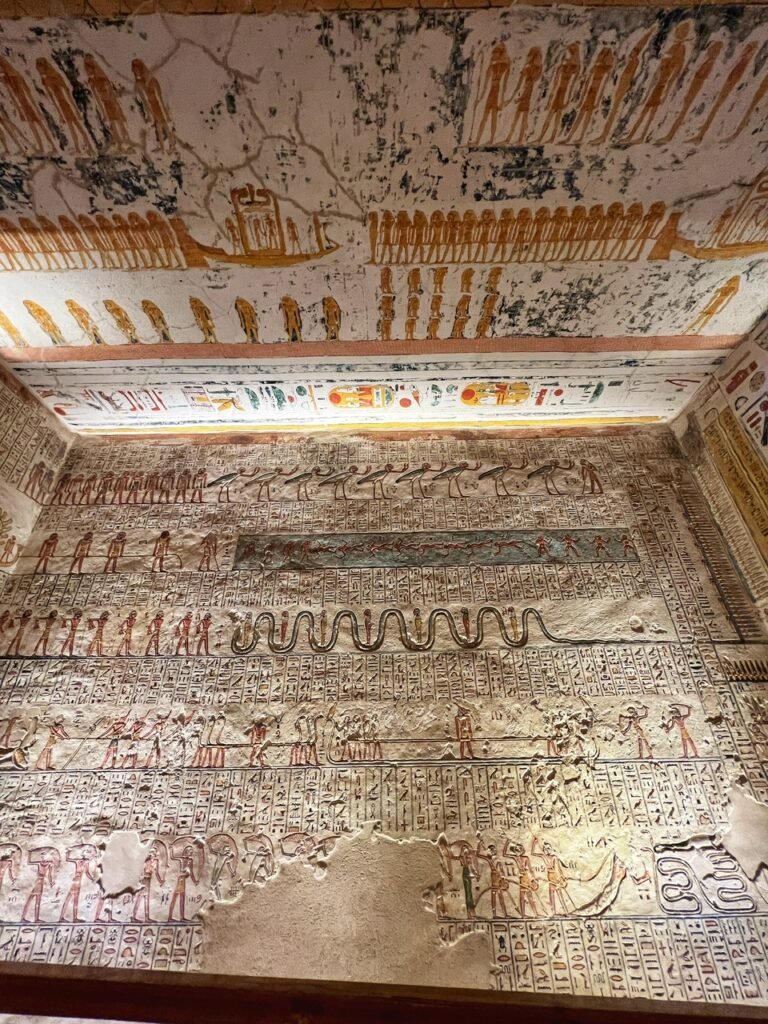
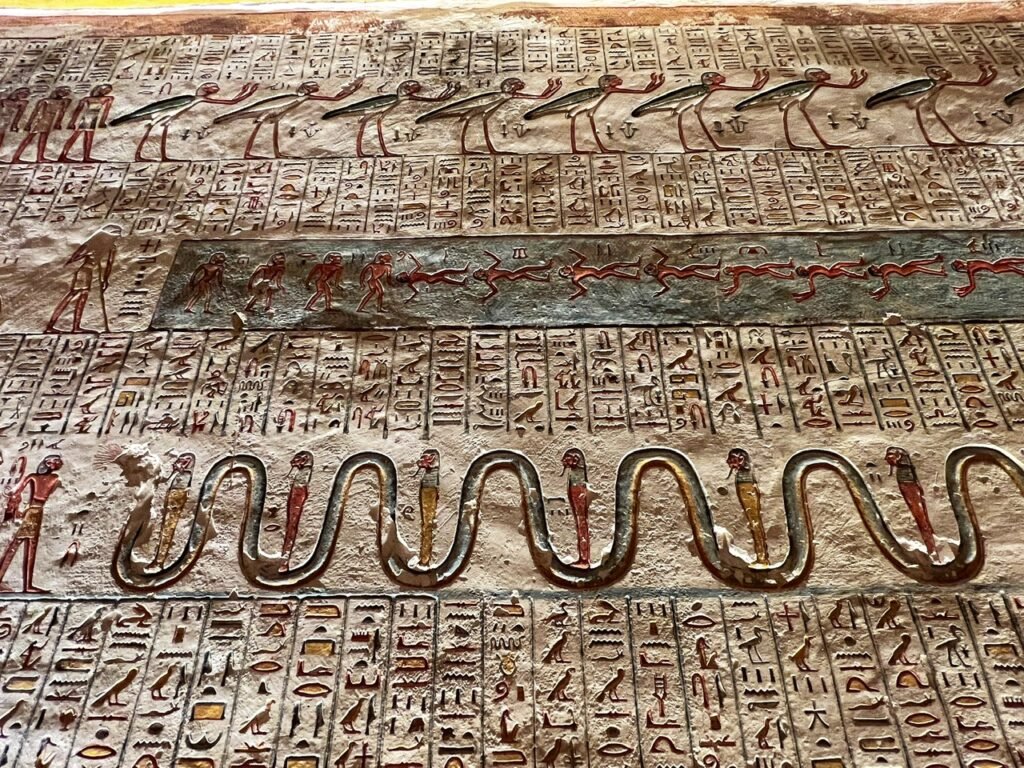
The tombs were used in a much more recent time than the pyramids. I guess the Ancient Egyptians finally realized those pyramids were far too much work 😅
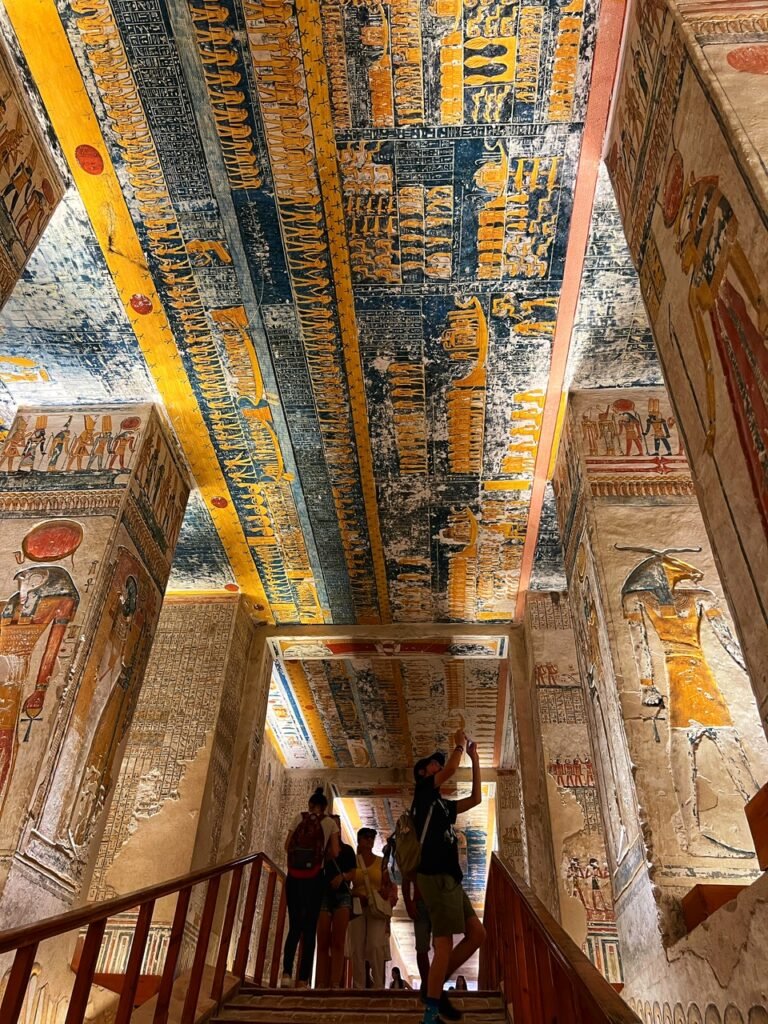
We couldn’t believe how vivid the colors still were!! Since the tombs were made for royalty, they had to be exquisitely beautiful. They included gorgeous imagery, and hieroglyphics which directed them into the afterlife. (So, basically they are probably loaded with inspirational memes and positive psychology one-liners!) Lonely Planet accurately claimed the burial chamber of Rameses the VI is a feast for the eyes.
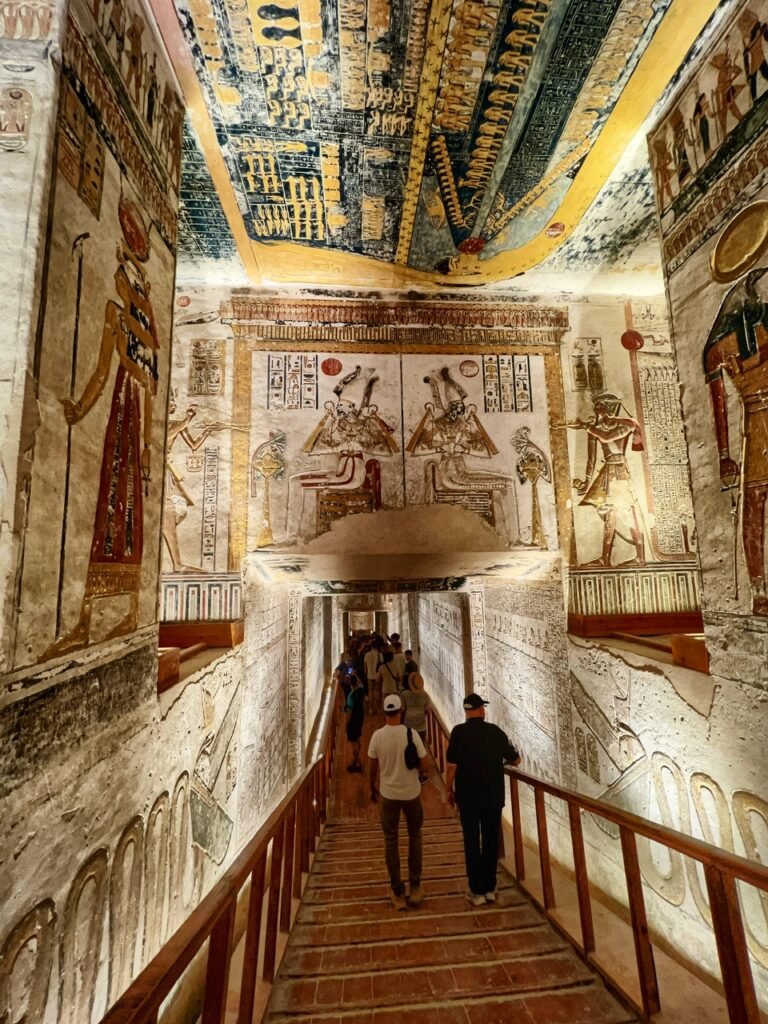
Dazzling images at everywhere you turn!
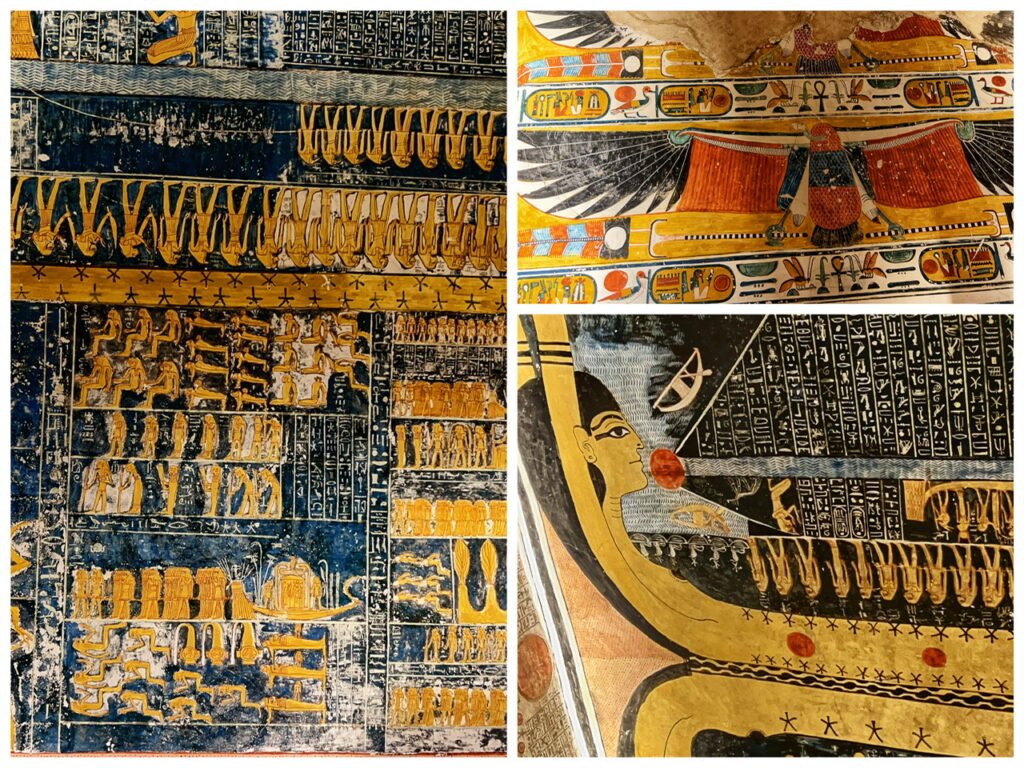
What a giant decoder puzzle. Thank goodness they found the Rosetta Stone. 😅
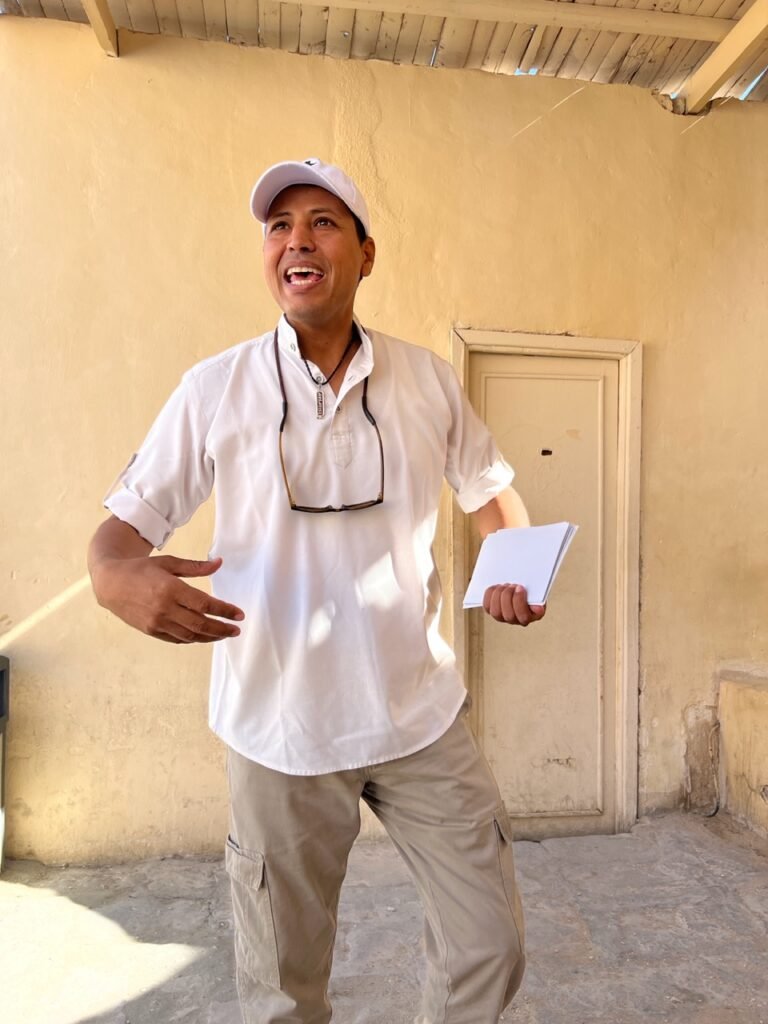
Our guide, Aladdin, made sure to tell us that our wishes were at his command. He had a bachelor’s in archeology and master’s degree from Cairo in Egyptology. Not to mention, he came from a long line of archeologists as well.
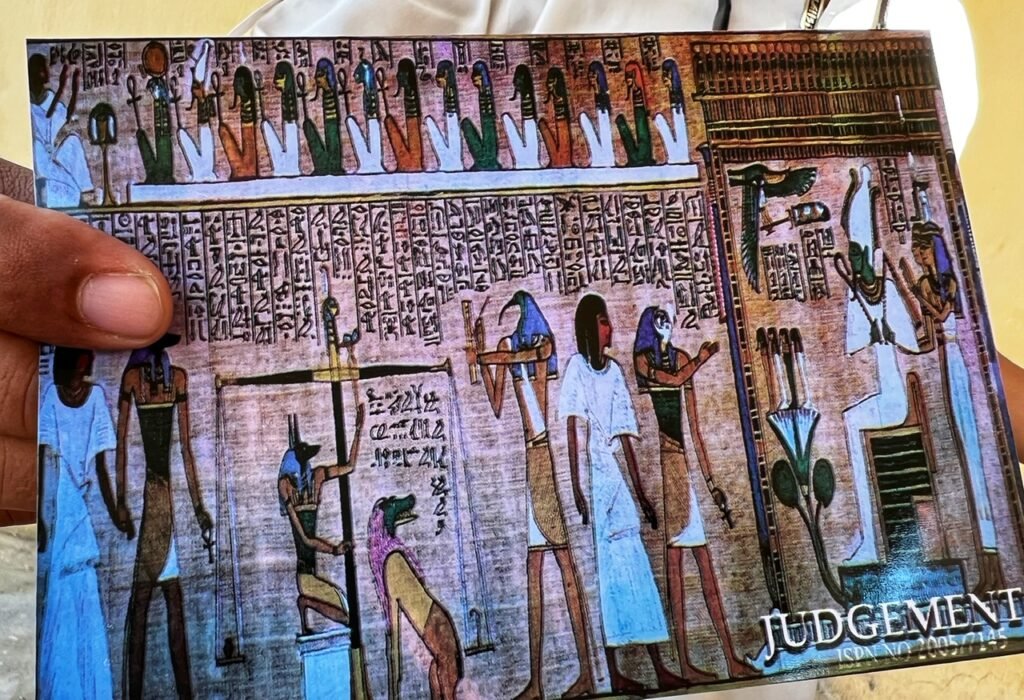
The Ancient Egyptians were some of the first believers in the justice system. Both real and in the afterlife. When you died, there was a “jury” of gods and you were escorted by your lawyer who made your case, and in the end they weighed your heart versus a feather. If your heart was heavier than the feather, you were not permitted to the afterlife and the dog god ate your heart. Dang. Bad day. If your heart was lighter than the feather, then paradise awaits. For the pharaohs, this meant with all their golden booty in tow.
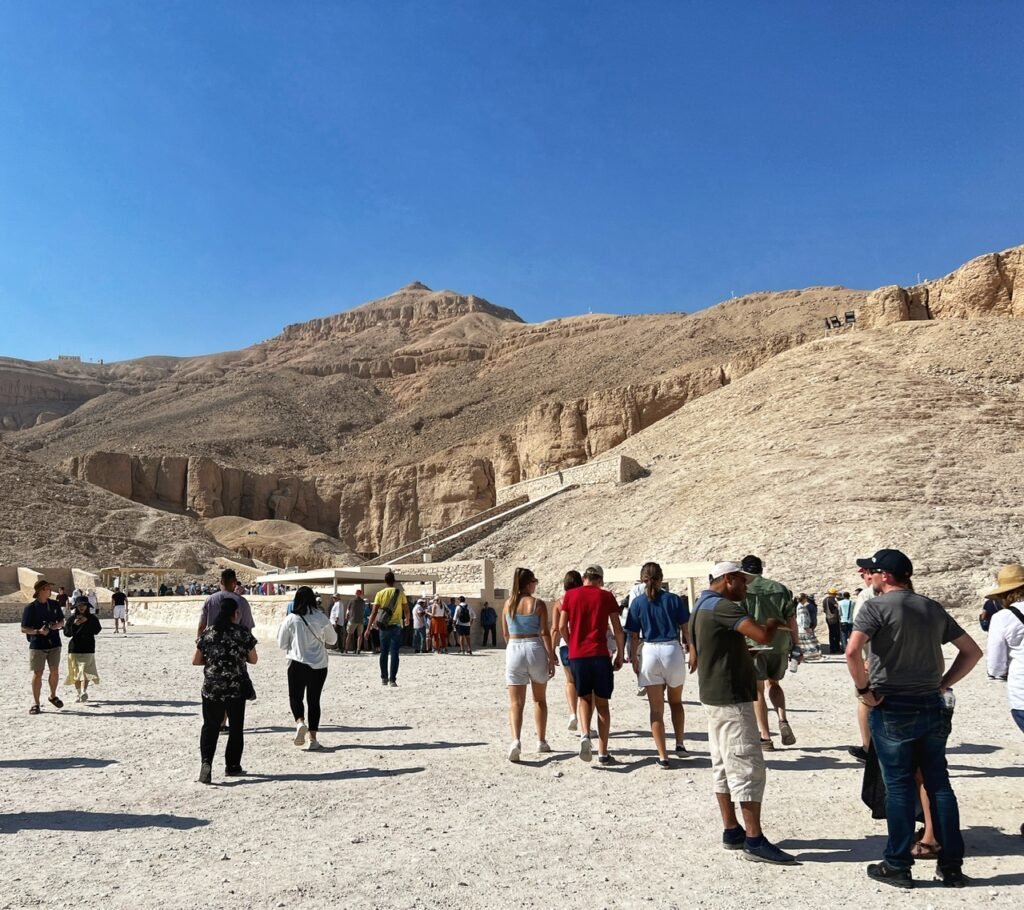
Visitors have unbelievably been coming to see the Valley of the Kings since Roman times! The outside of the tombs is not too exciting.

Next we crammed ourselves with a thousand other people into the tomb of Ramses III, also known as the longest tomb in the valley. Not so fun. They were sweltering and odorific. Can’t imagine how hot this excursion would be just a month ago!
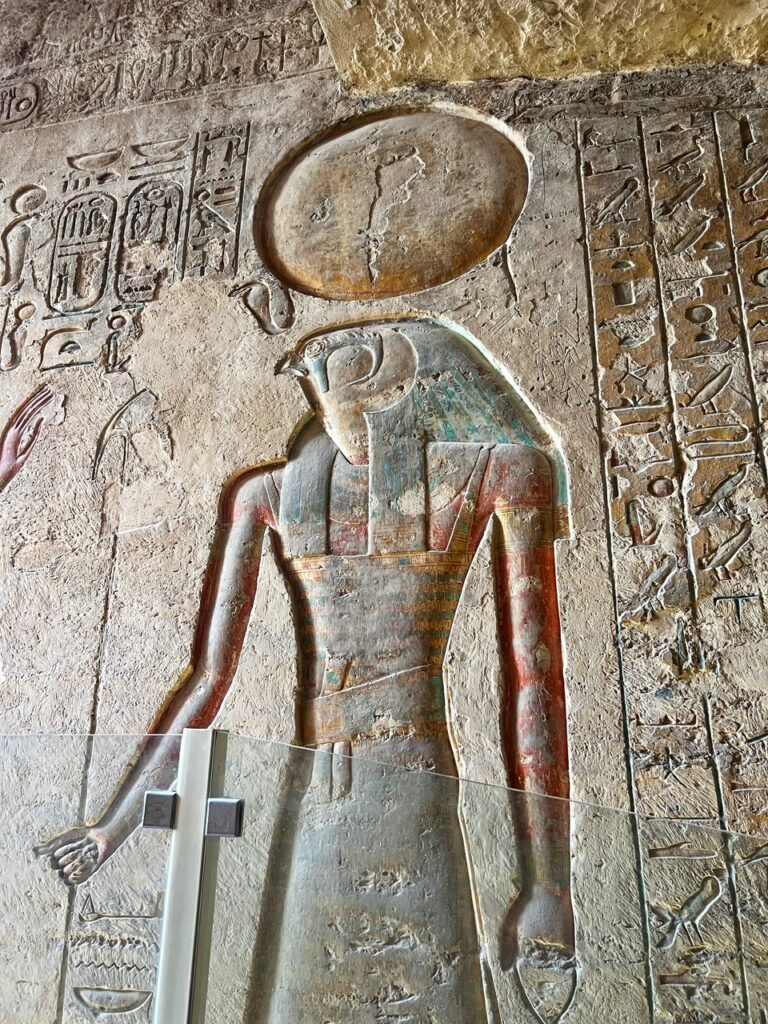
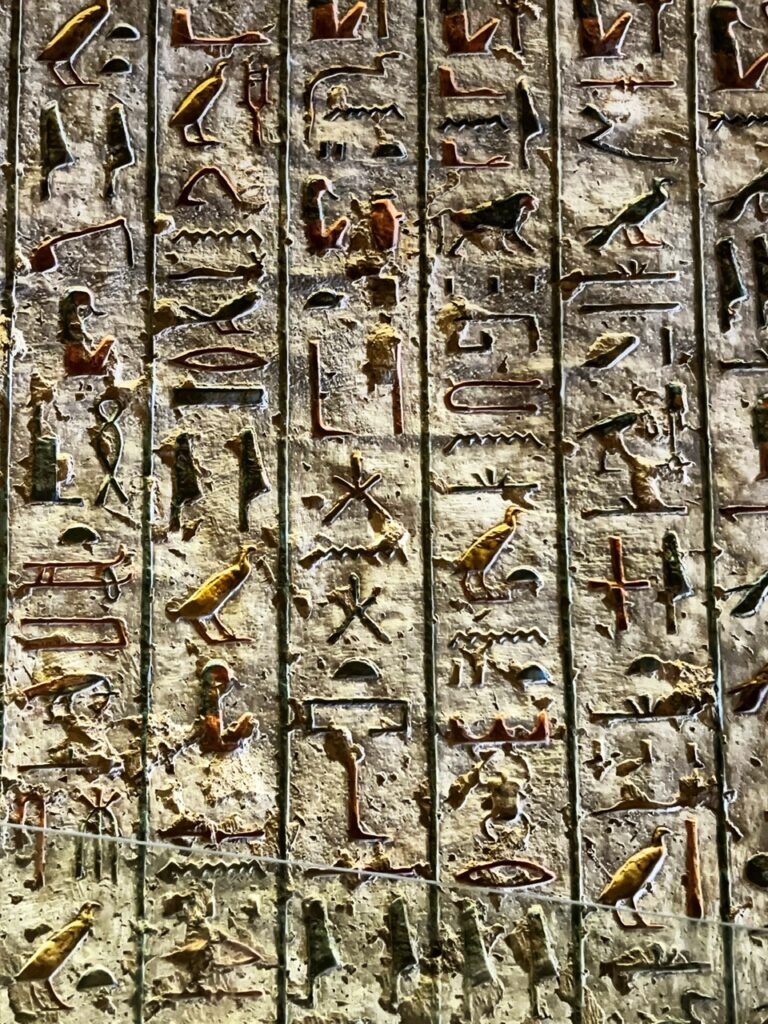
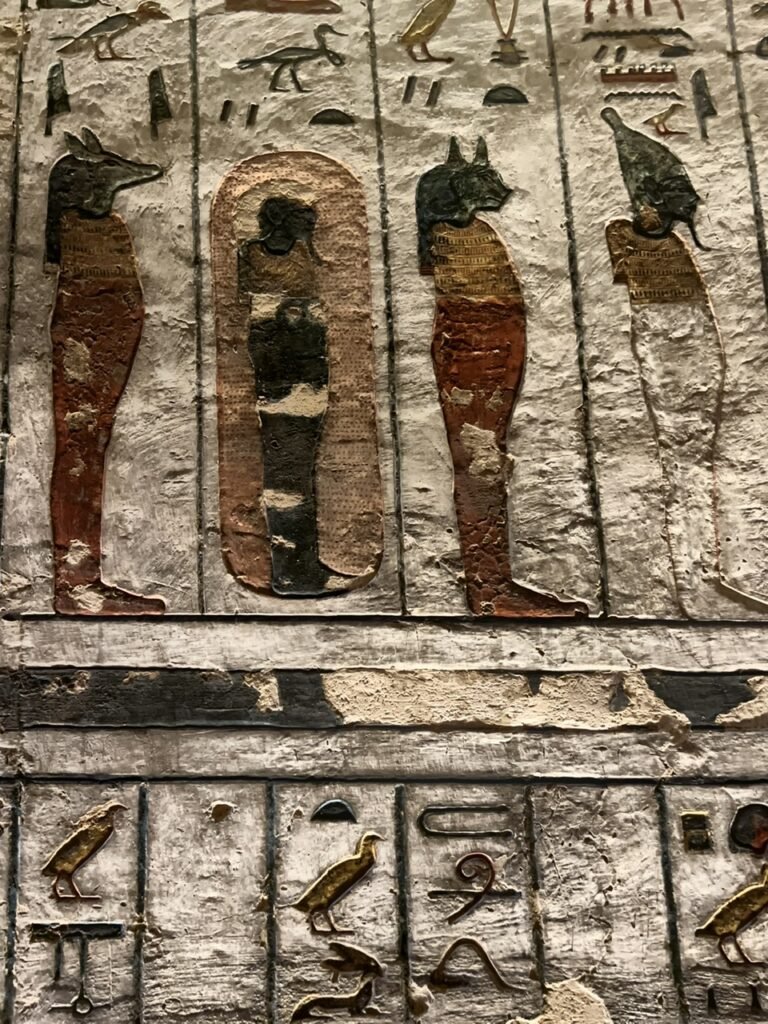
The bird man, Horus was half falcon and half man and represented a sun god.
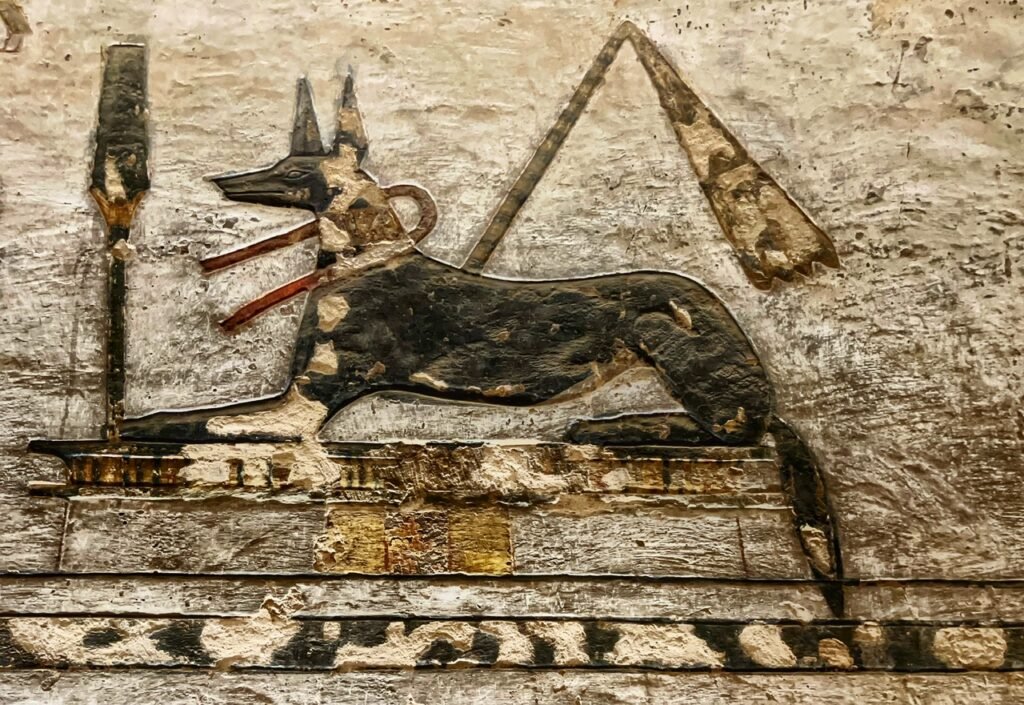
Dogs were loved and praised in ancient Egypt.
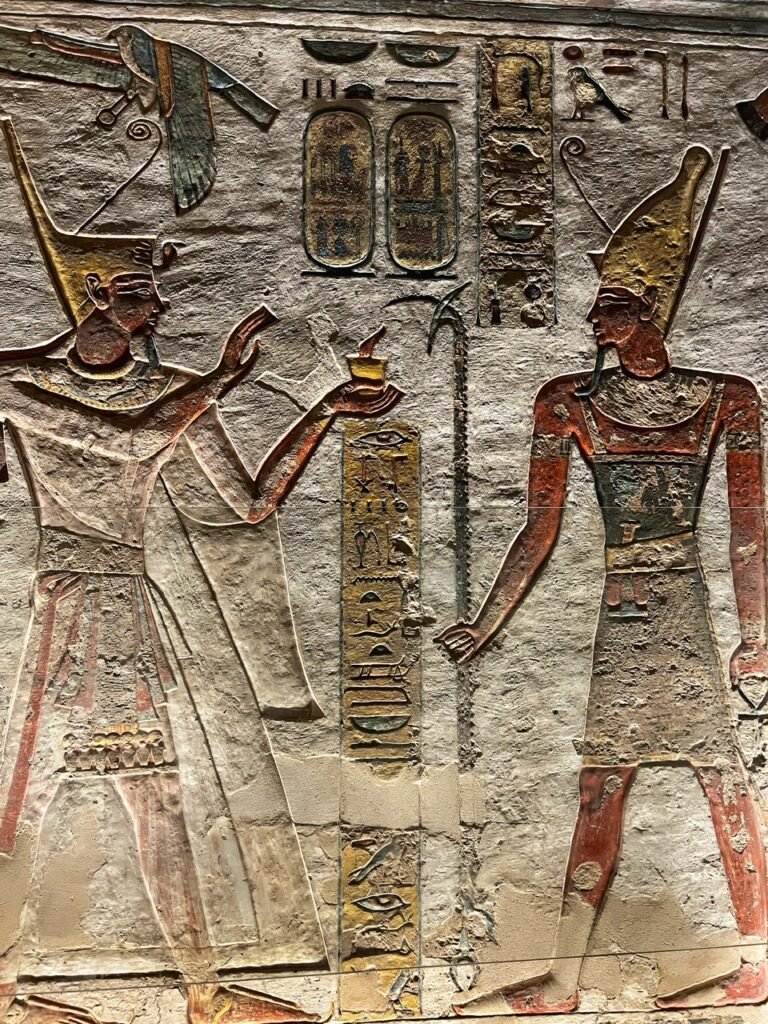
The Ancient Egyptians were typically well-dressed and manicured. They often shaved their heads bald to help alleviate lice, wore cosmetics and skin care and shaved their faces clean. Minus the little goatee slide on their chins…
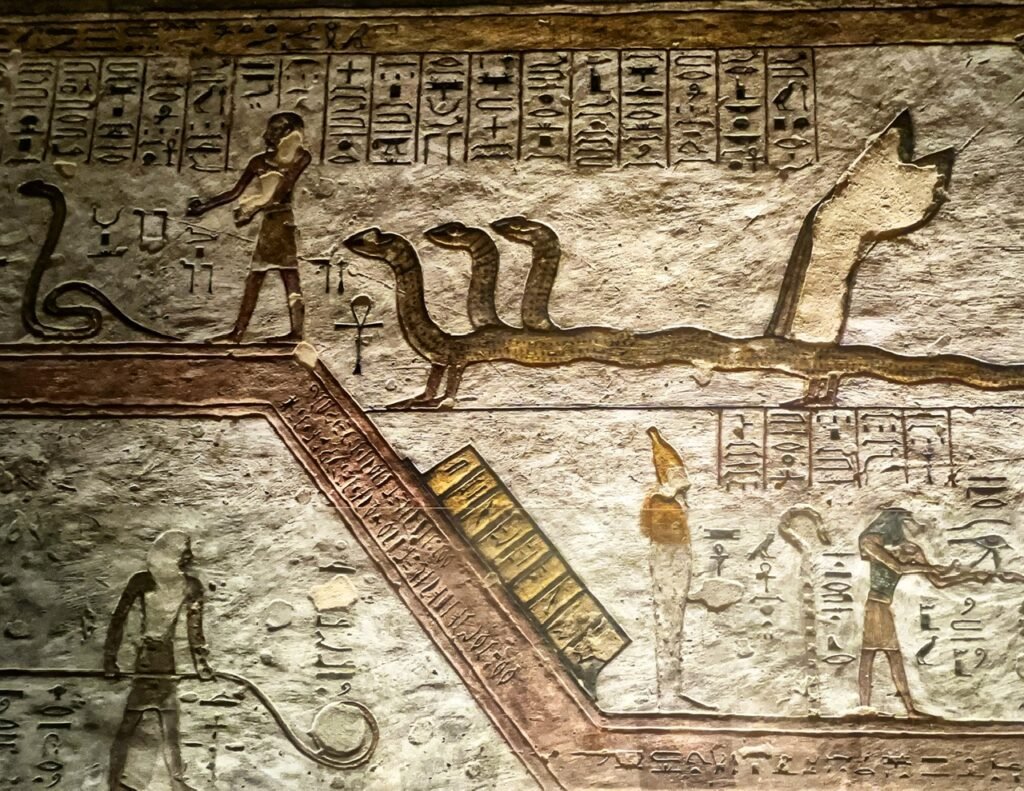
A three-headed walking snake. Cool!

More images from Ramses III.
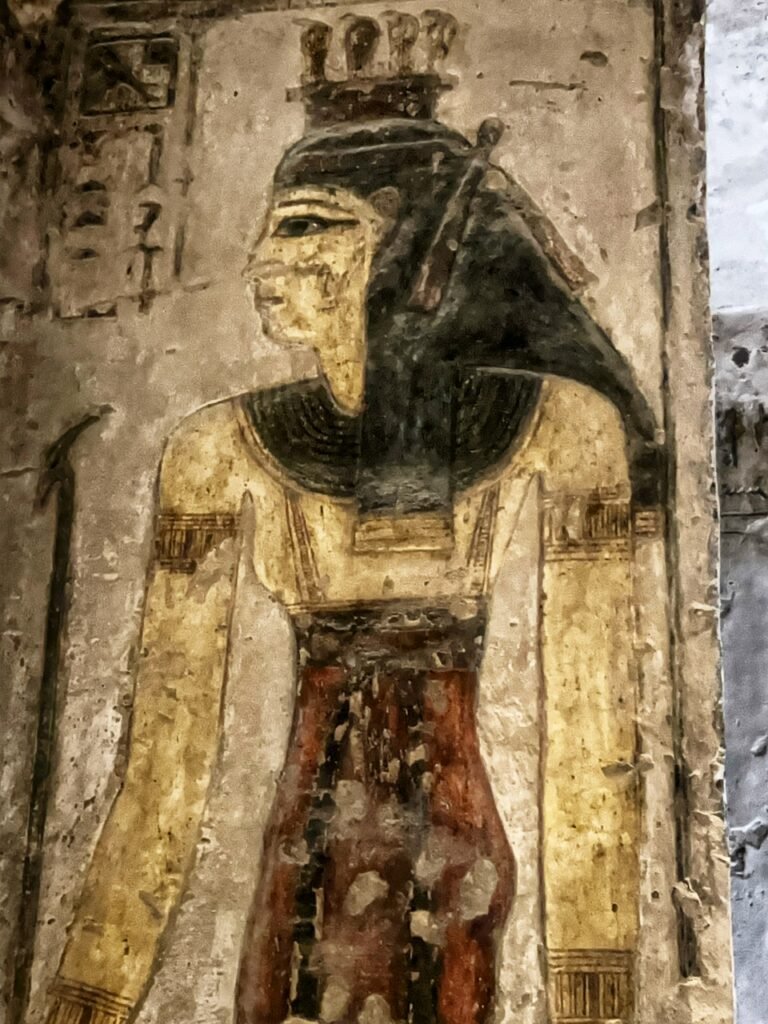
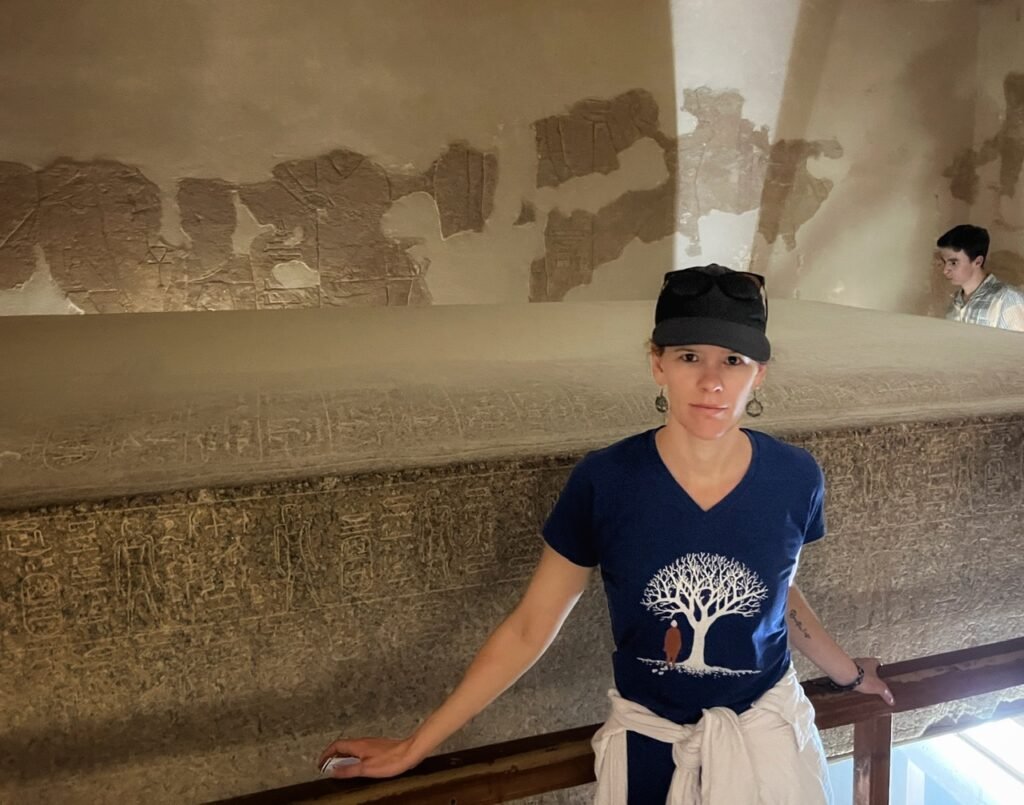
An Egyptian Queen, followed by another Egyptian queen and her one-tomb-too-many face. Plus, she has a radiant light coming out of her head.
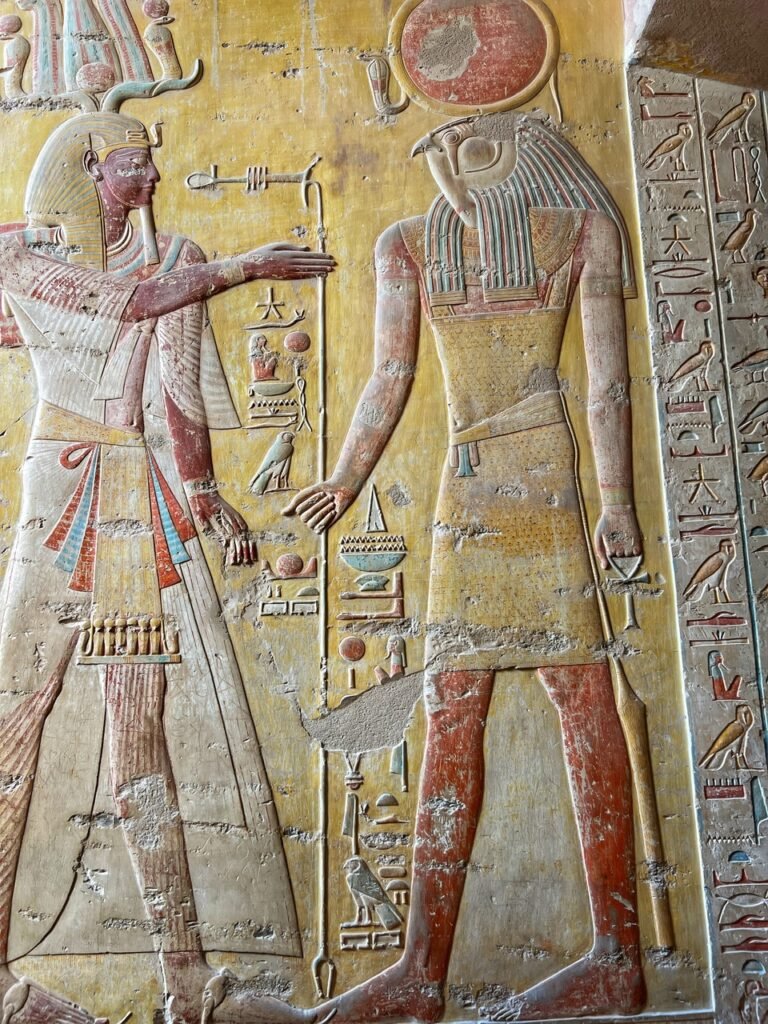
The Tomb of Merenptah was the third tomb. The images were just as striking as the others!

Ah, this is better! Time to do the inevitable pose made popular by the Bangles just for Greg’s stepmom. 🤣 So, you mind have noticed…this is the original 1920’s signage for a very famous tomb.
A few words on King Tut:
-Because they don’t do their research, or just because of his vast notoriety, a very large majority of people choose to visit the tomb of Pharaoh Tutankhamun (Aka King Tut) as their bonus tomb. This is not necessarily the best decision because it’s actually quite a barren tomb, other than his actual mummy. Although it was remarkably intact and never looted by tomb raiders like all the rest, the extravagance was stripped from it upon its finding in November 1922 by Howard Carter. These findings will soon be displayed at the shiny new Great Egyptian Museum in Cairo opening in 2023. Sadly, we missed this by months.
-King Tut became a king while still a child after the demise of his father Rameses 1 and ruled for nine years until his death at the age of 18. There is much speculation about how he died.
-According to discoverwalks.com, (and many other sources) the tomb is also believed to be cursed. Locals believe that anyone who gets close or touches the boy king’s tomb will be cursed. This was after the team led by Carter died mysteriously. The popular belief is said to have been cast by the pharaohs to anyone who disturbed the mummies (which implies that visitors just taking selfies in said tomb are a-ok!) 🤣 In other sources, it says Carter died in 1939 of Lymphoma. Clearly, there is still a bit of controversy on this subject…lol.
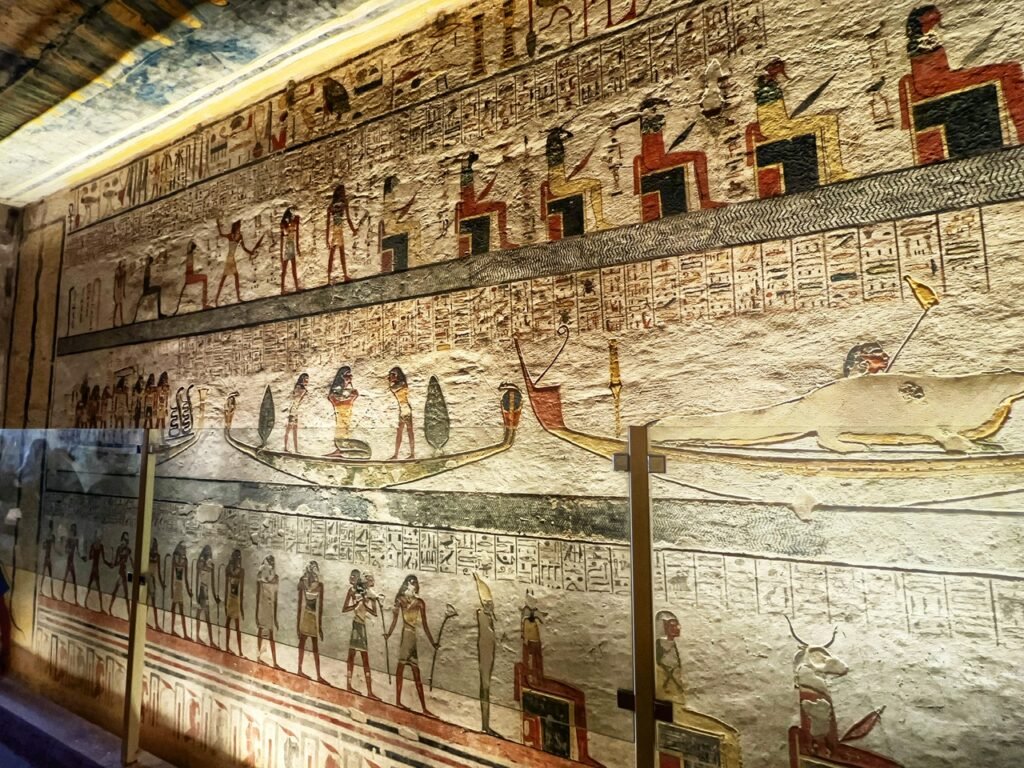
The final tomb in the valley was King Rameses the IX.
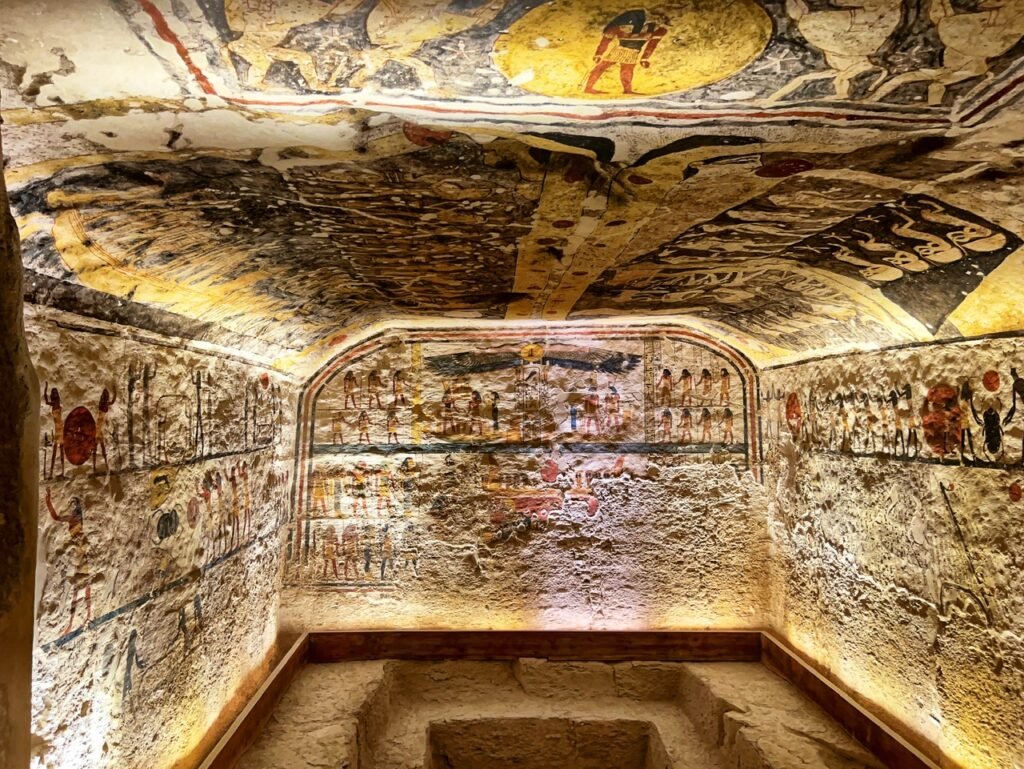
It featured a large pit in the floor of the burial chamber. Hmmm…wonder what kind of goodies were found in here. A Play Station? iPhone 15?
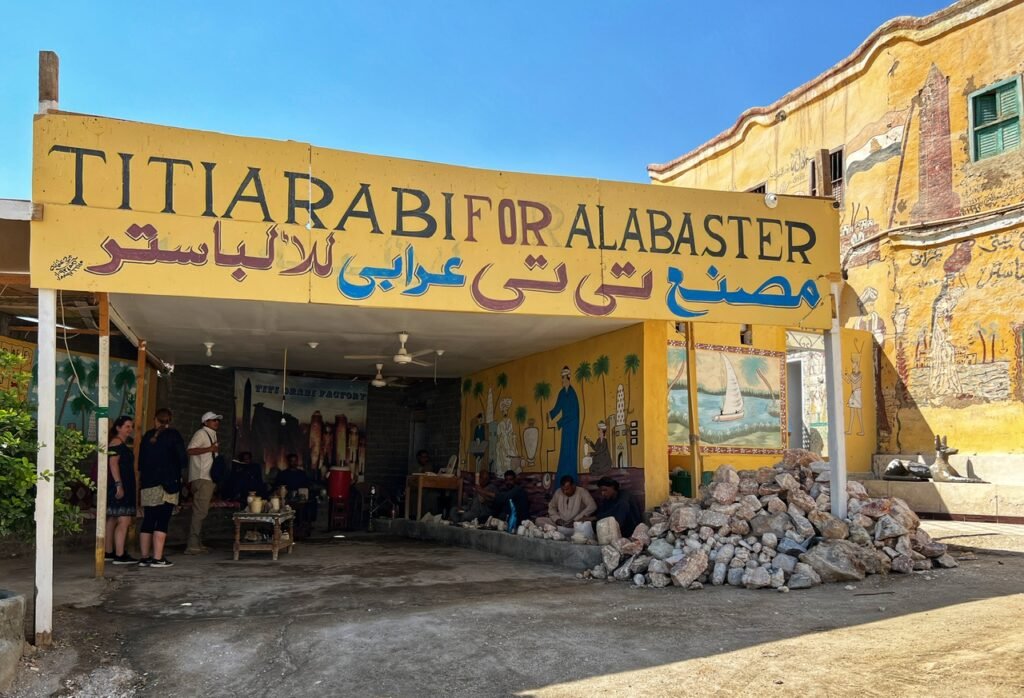

After leaving the Valley of the Kings, we made a stopover on our tour at one of the Alabaster shops, which was in a 600-year-old traditional house.
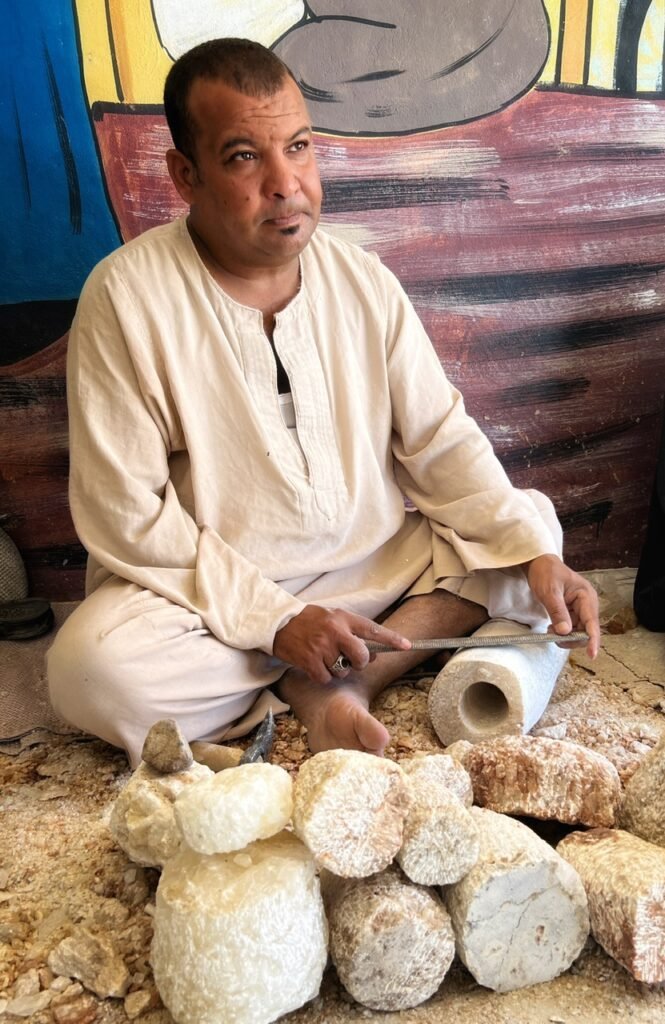
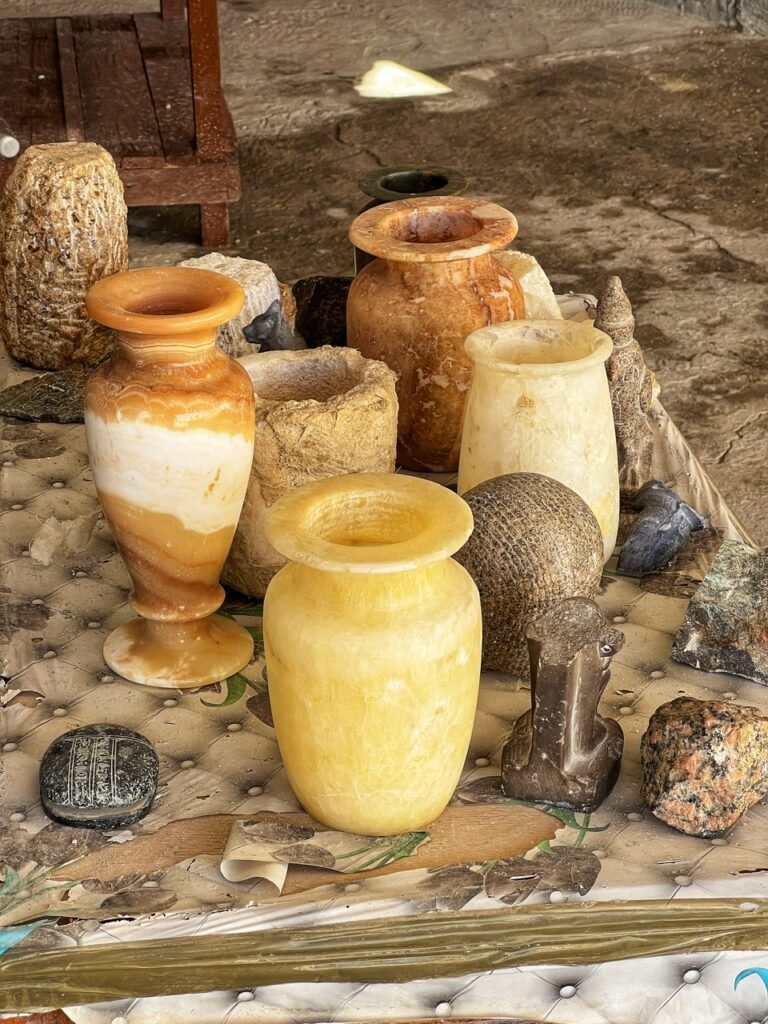
We got to see the local men chiseling away making lamps and candle shades out of this luminescent and smooth stone.
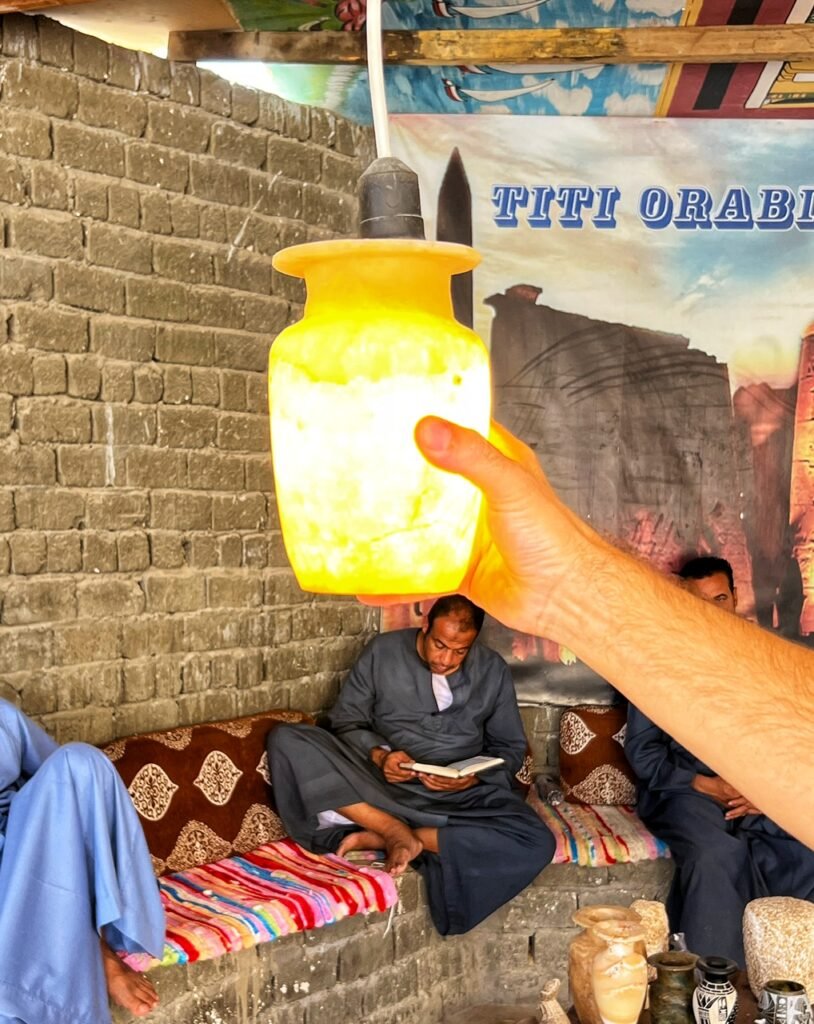
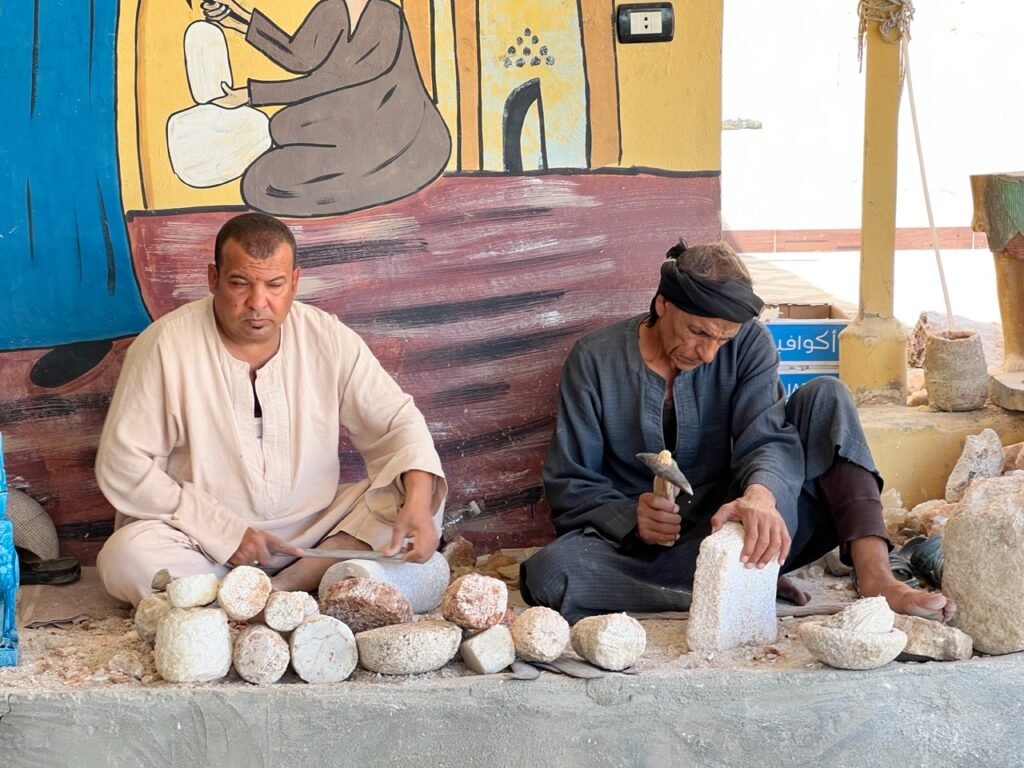
When you held a lamp next to the light, the entire cluster of men had been trained to “Ooooo and ahhhh!” Quite the marketing team.😂
Then they put Greg to work…
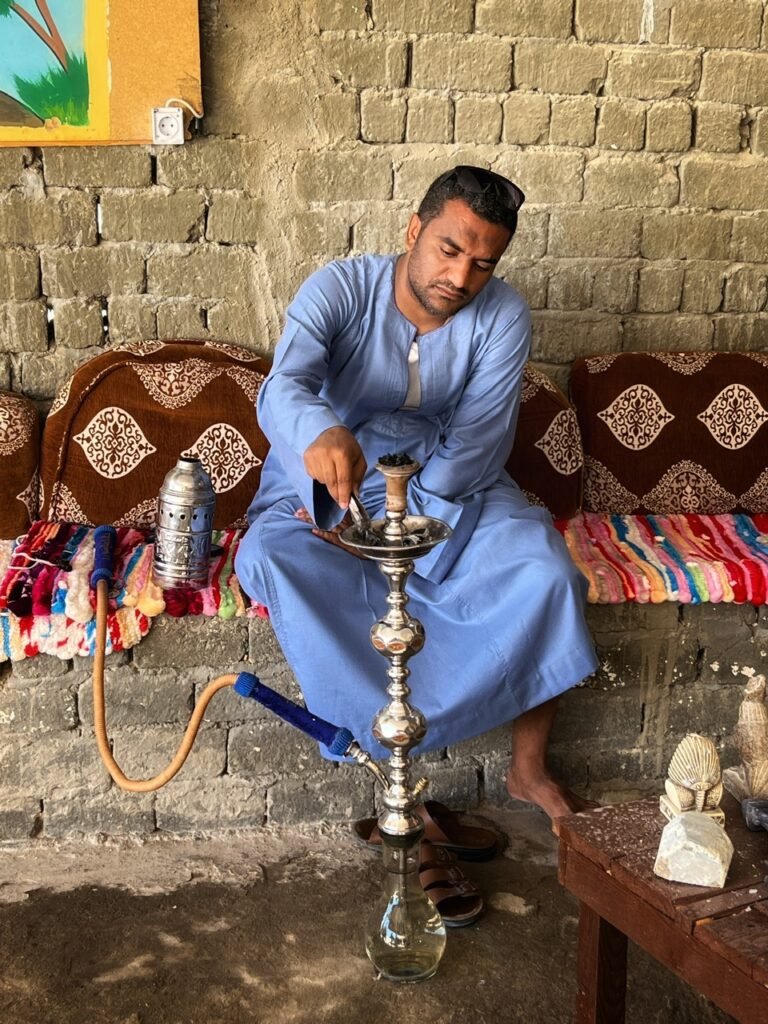
….while they take a break with his shisha water pipe. Apparently, during COVID the use of shishas was banned in public places. We read in a Washington Post article the fines were up to 4,000 Egyptian pounds — around $255. I’m sure this all went over well…

The next visit was to the Temple of Hatshepsut, which Aladdin referred to as hot chicken soup to help us remember it 🤣 Hatshepsut was a bit of a controversial figure in her time. She was born the only child of the previous pharaoh and queen and was not given the right to succession because she was not a male. Her father took a second wife, who then produced a son. Sometime later, the pharaoh and queen died and in order to guarantee her ascension to the throne Hatshepsut married her half-brother, so there was no question of rightfulness to the throne. Hatshepsut had ambitions to be THE ruler, however, so she sent her teenage husband away to military school so she could rule alone. When her king husband/half-brother came back to Thebes (Luxor), he was furious at Hatshepsut for assuming the throne and sending him away. After some years, she died and was buried in this temple.
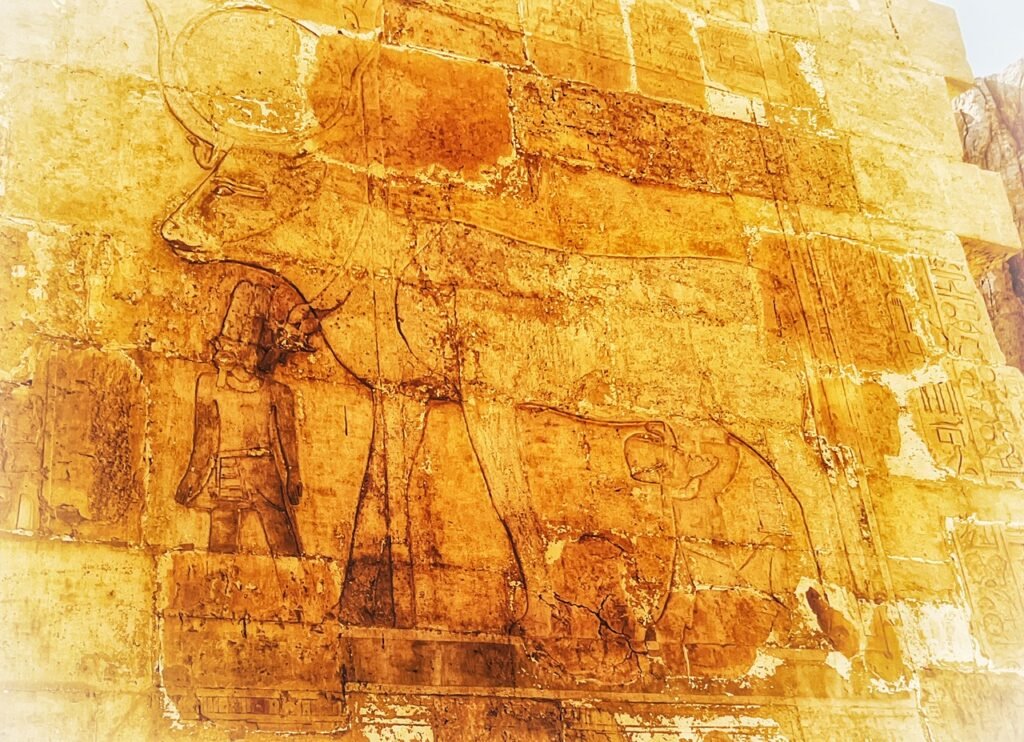
In his fury, the new ruler after Hatshepsut’s demise had every image and every mention of her removed from her burial temple. All except for this picture of a relief which has the only image of Hatshepsut as she suckles under the belly of a cow. It is unknown why this image was left.
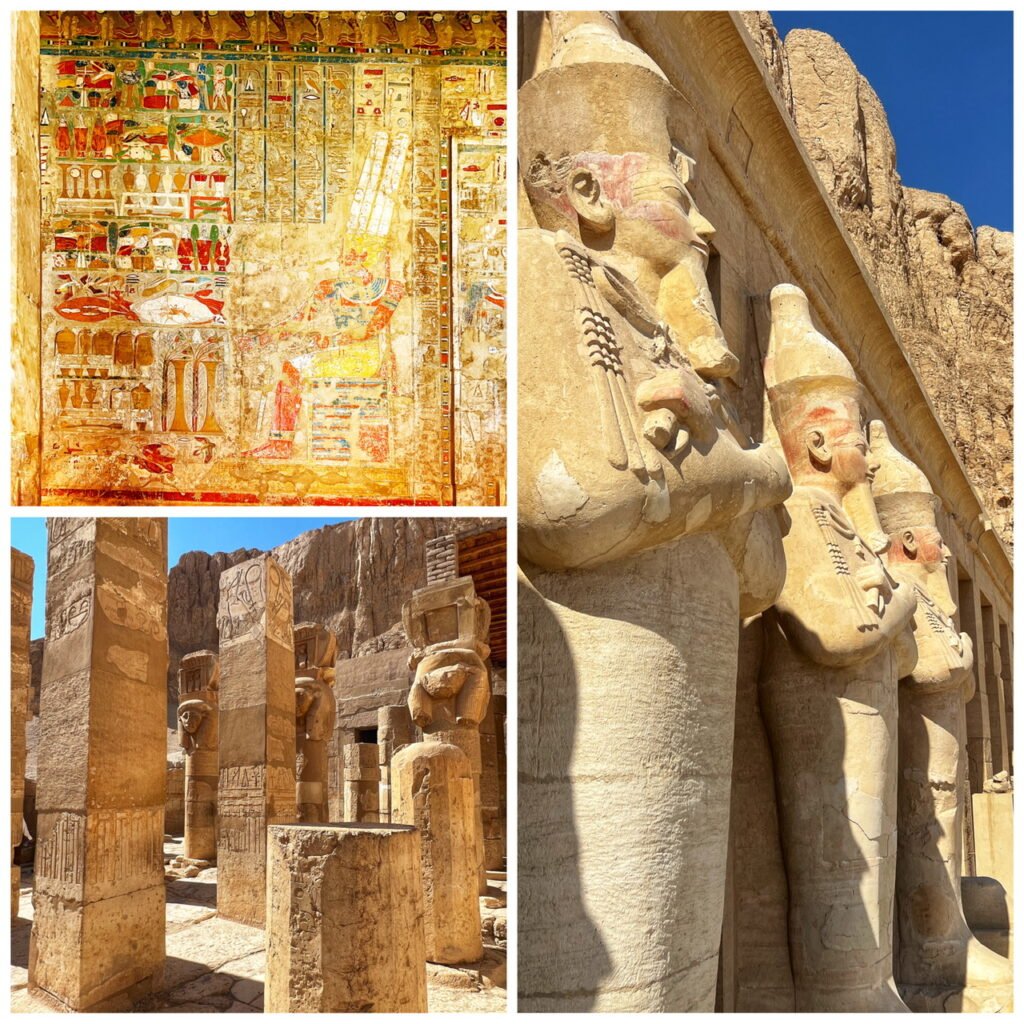
The new ruler placed images of himself on her temple. Wow…🙄
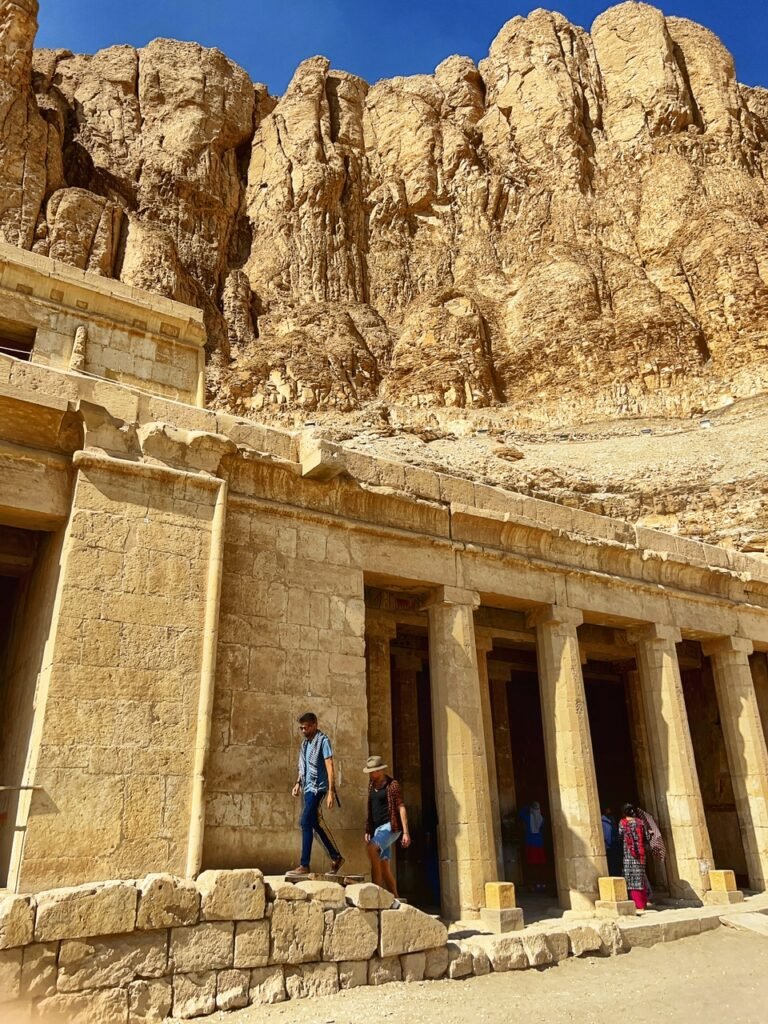
Heading into the temple with a beautiful backdrop.
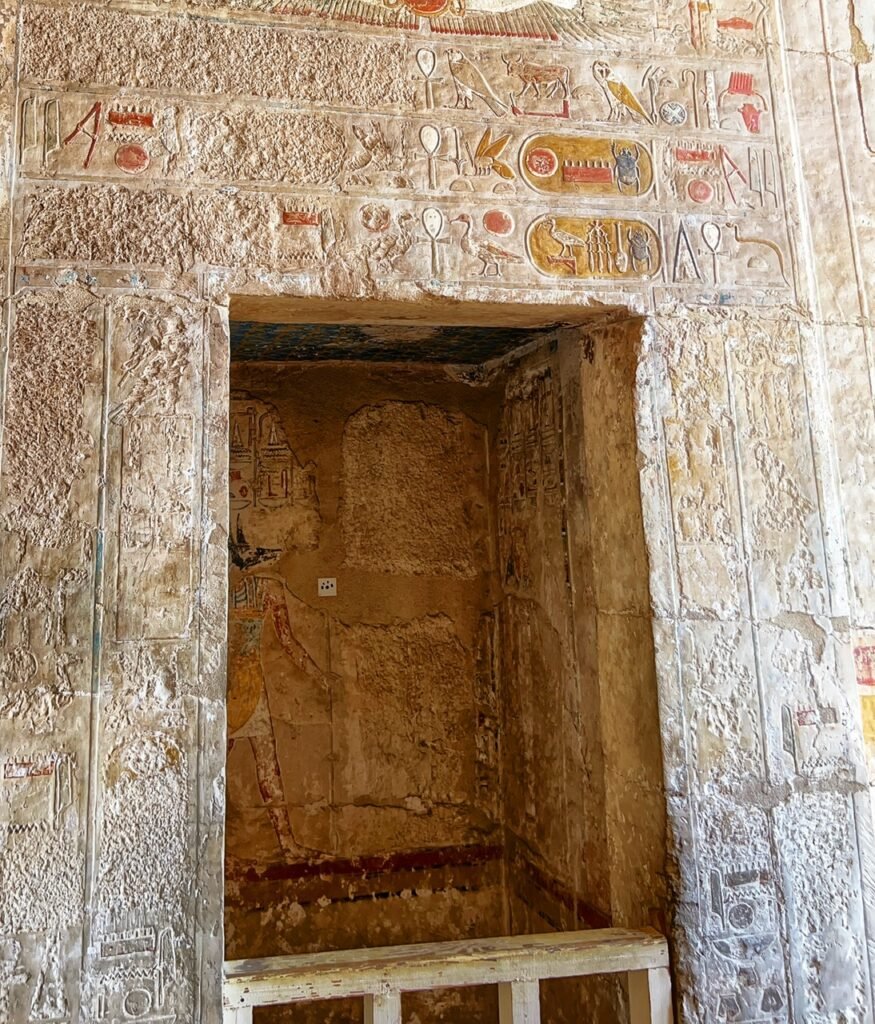
This plain-looking frame used to have Hatshepsut’s story written around it in hieroglyphics, but every mention of her was erased and chiseled off. However, archeologists found that if you look closely at the chisel marks, apparently you can still see her name underneath. Dum-dums!
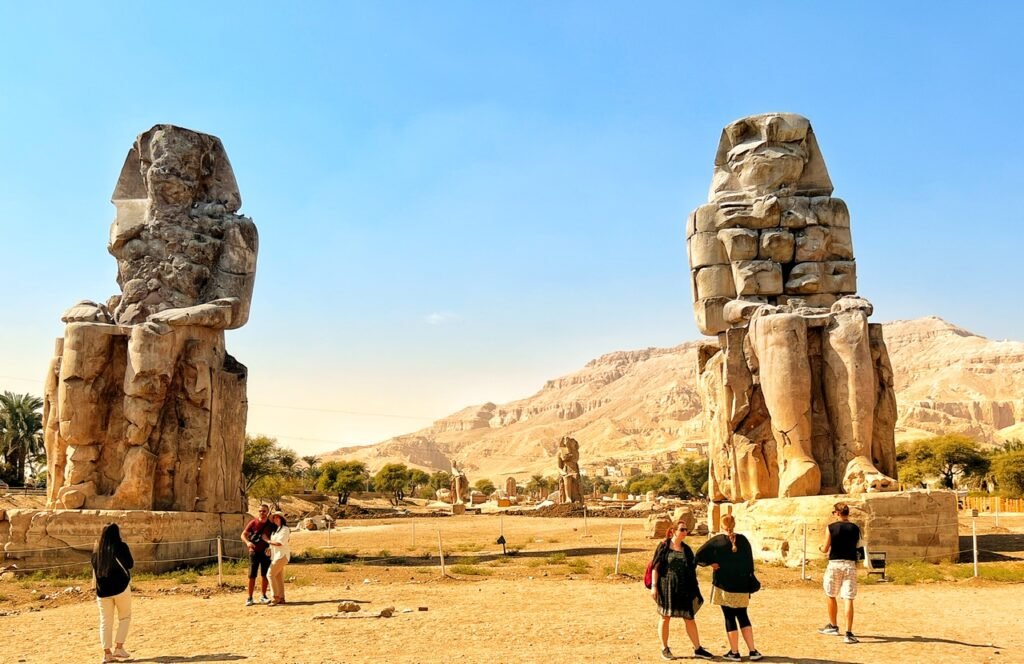
The gargantuan 60 feet Colossi of Memnon statues have survived an astounding 3400 years and depict Pharaoh Amenhotep III with his little women at his feet said to be his mother and wife. The Colossi are said to be an “acoustic wonder of the ancient world.” They. When the Romans lived in this part of the world a crack made by an earthquake in one of them caused it to “sing” an hour or two before sunrise, but only if you were lucky would you hear this voice.
Luxor Temple
The scale, magnificence and sheer number of monuments in Luxor (formerly Thebes) reflect this city’s importance throughout Egyptian history. The city consists of an east and west bank. The east bank is quite chaotic and modern other than the strikingly graceful temples that the Ancient Egyptians left behind. One notable temple we’ve mentioned is Karnak and the other is Luxor Temple.
Considering we spent a lot of time staring at Luxor from our apartment across the Nile, we were eager to check it out. We chose to head in at about 4 pm, which ended up being a perfect window when hardly anyone else was inside. We stayed until the sunset at 5 so we could appreciate it by eerie evening light as well, but by this hour it was slam-packed. Regardless, it was an experience to see it by light and by night and by solitude and by crowds.
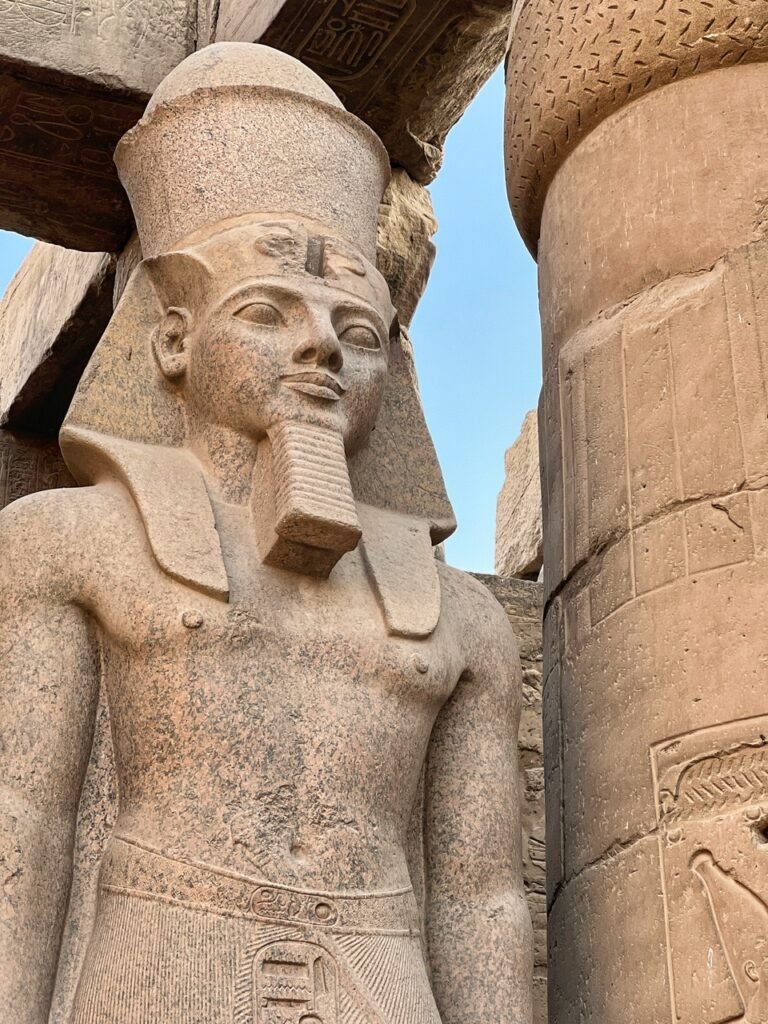

Rameses II

The Colonnade of Amenhotep III
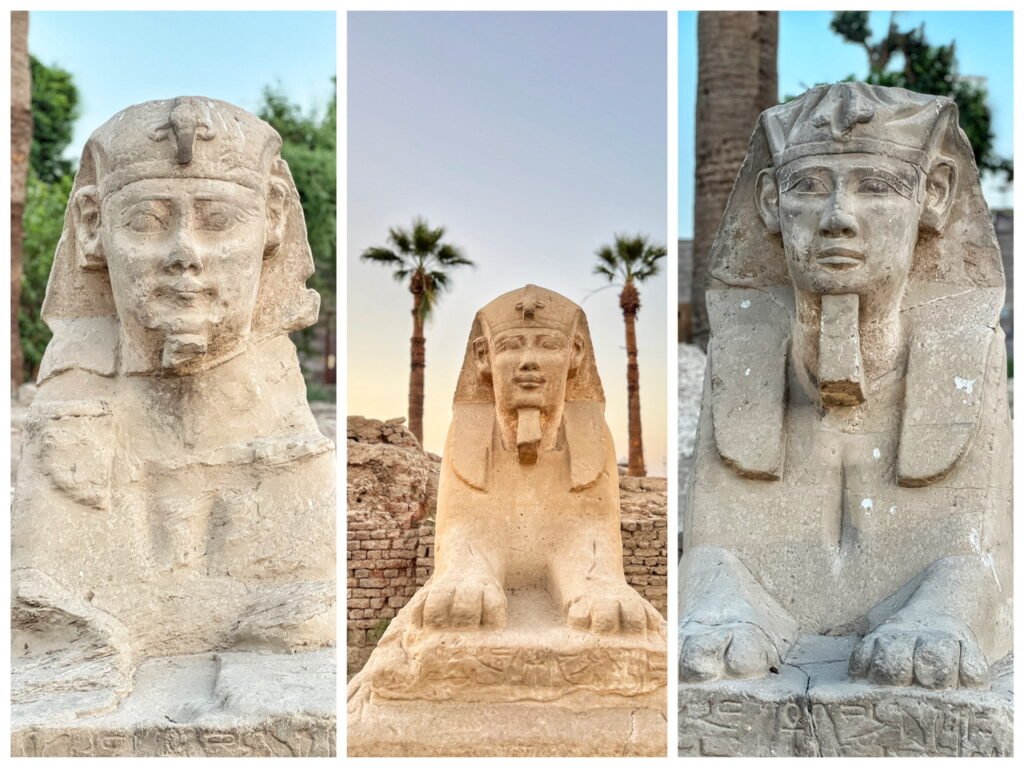
Three remarkably different faces from the Avenue of the Sphinxes
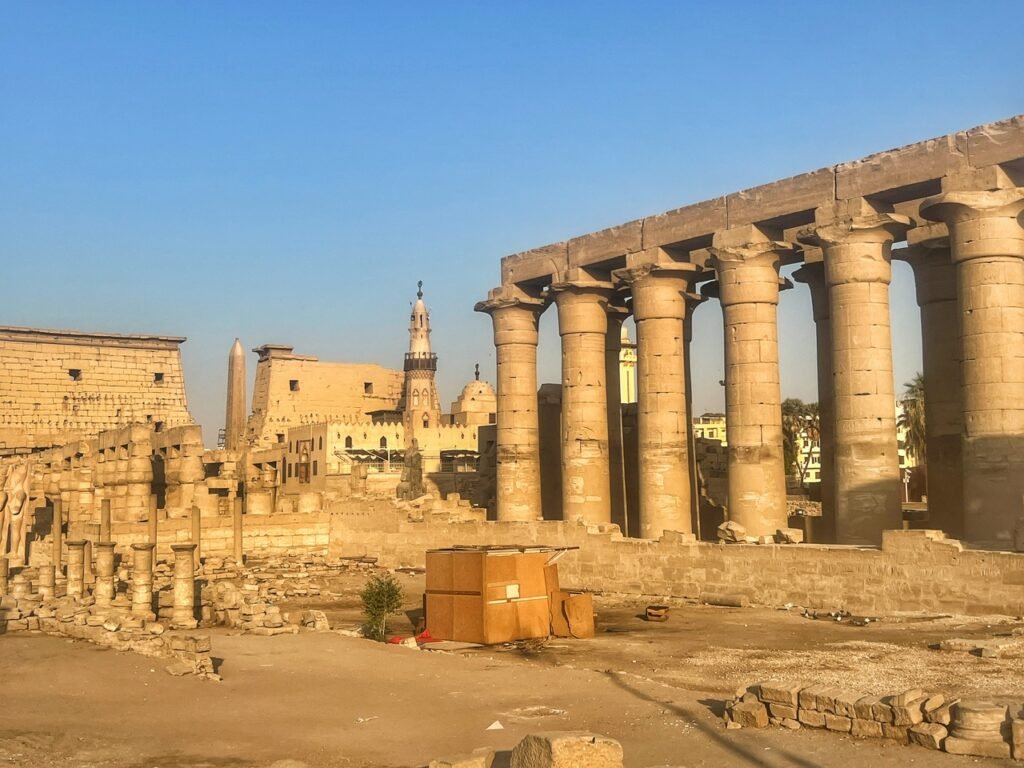
A large-scale view of the complex. You might notice that a mosque was dropped in the middle of this ancient masterpiece in the 14th Century.
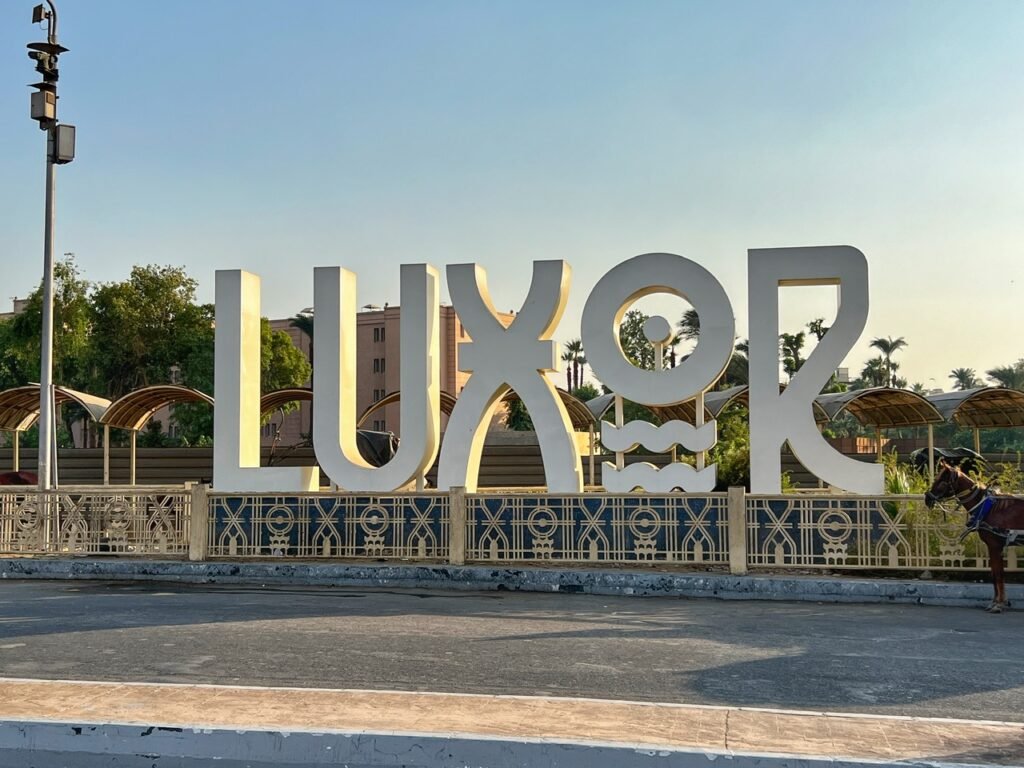
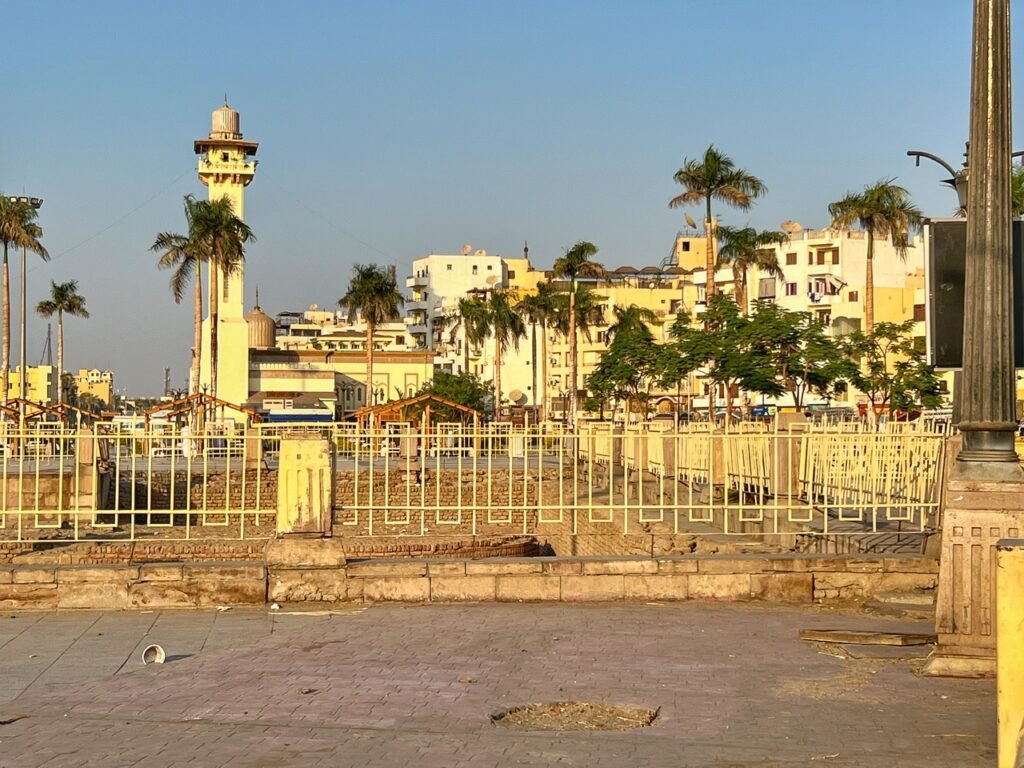
The town of Luxor leading to the temple. This was ground zero for getting harassed in Luxor, usually by carriage drivers who were carting around very sad-looking horses. Some of them were pretty feisty, using their pitiful horses as guilt bait, but only one continuously followed us and wouldn’t take Greg’s calm no thank you’s for an answer until Mandy snapped a “La Shukran” at him.
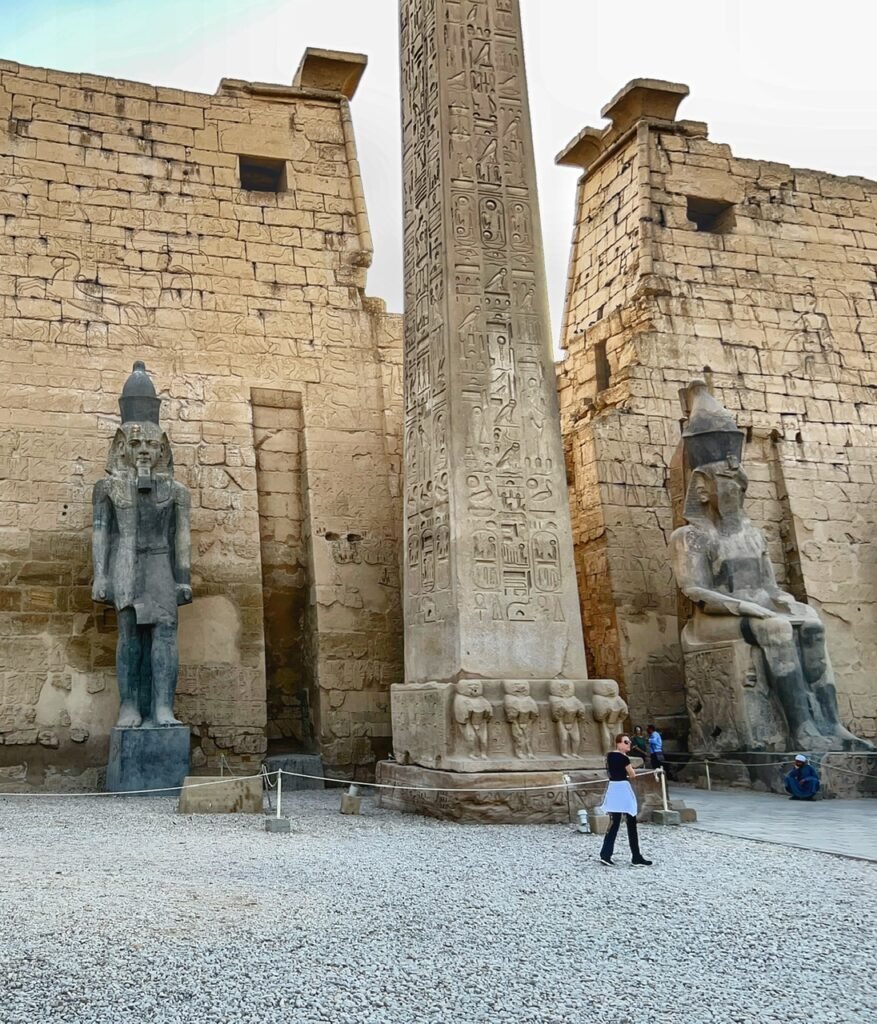
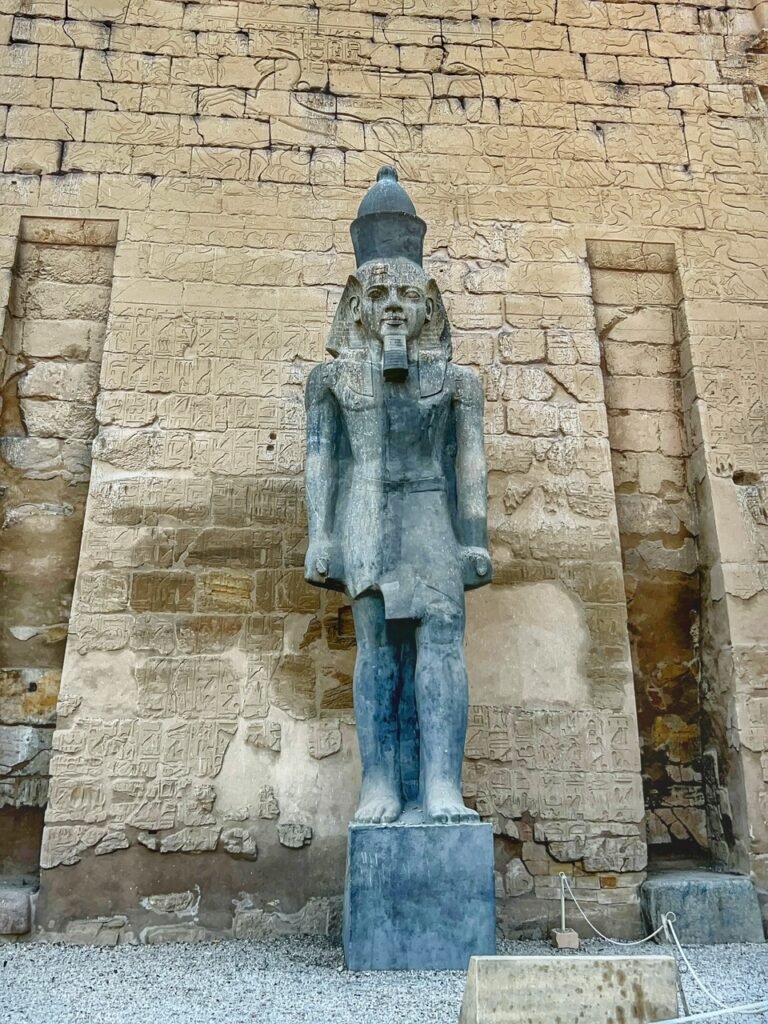
The entrance pylons were raised by Rameses II and decorated with six colossal statues of…himself naturally. Only three remain, which he probably wouldn’t be very happy about.
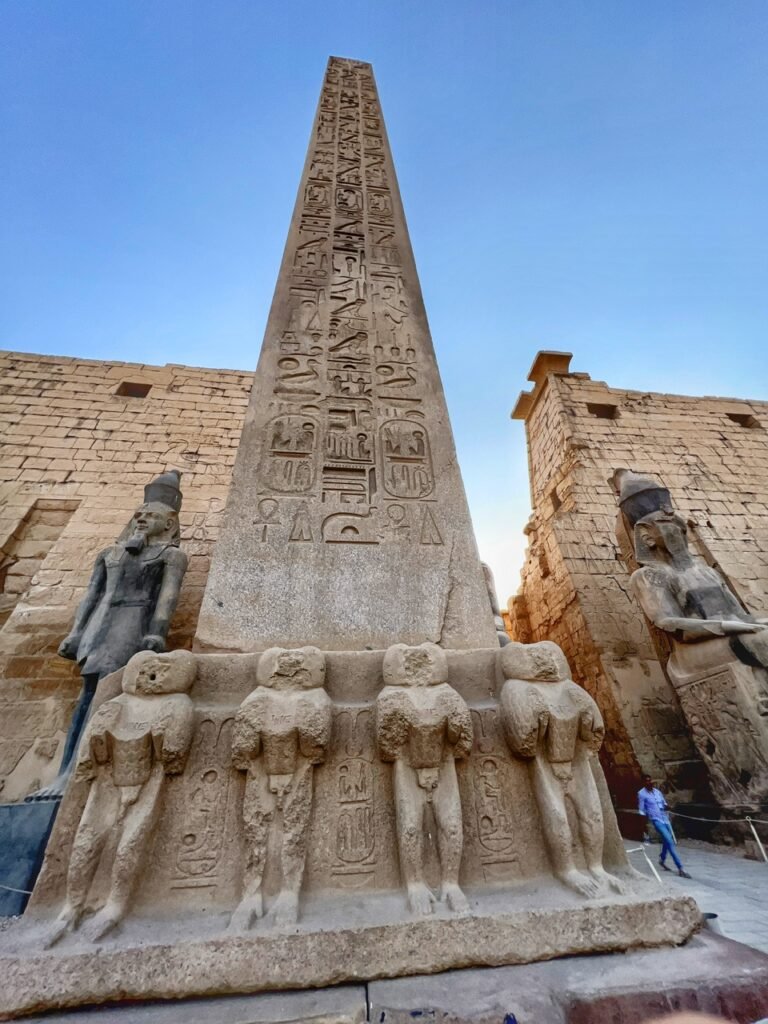
There is a pink granite obelisk that frames the entrance to the temple. There used to be two, but I guess Paris decided to ship one to themselves for use at La Place de la Concorde.

Another Rameses. This one sitting flanked by standing ones. If we had to guess their height, we’d probably guess 30 feet.
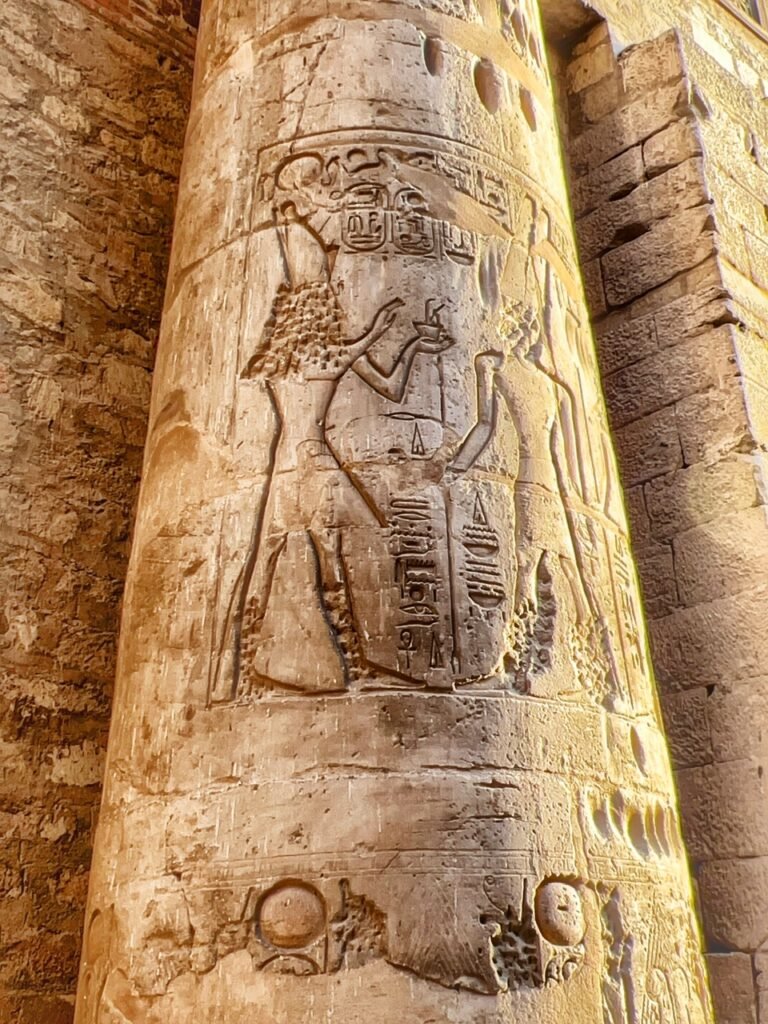
Columns covering the life story of…you guessed it…Rameses II.
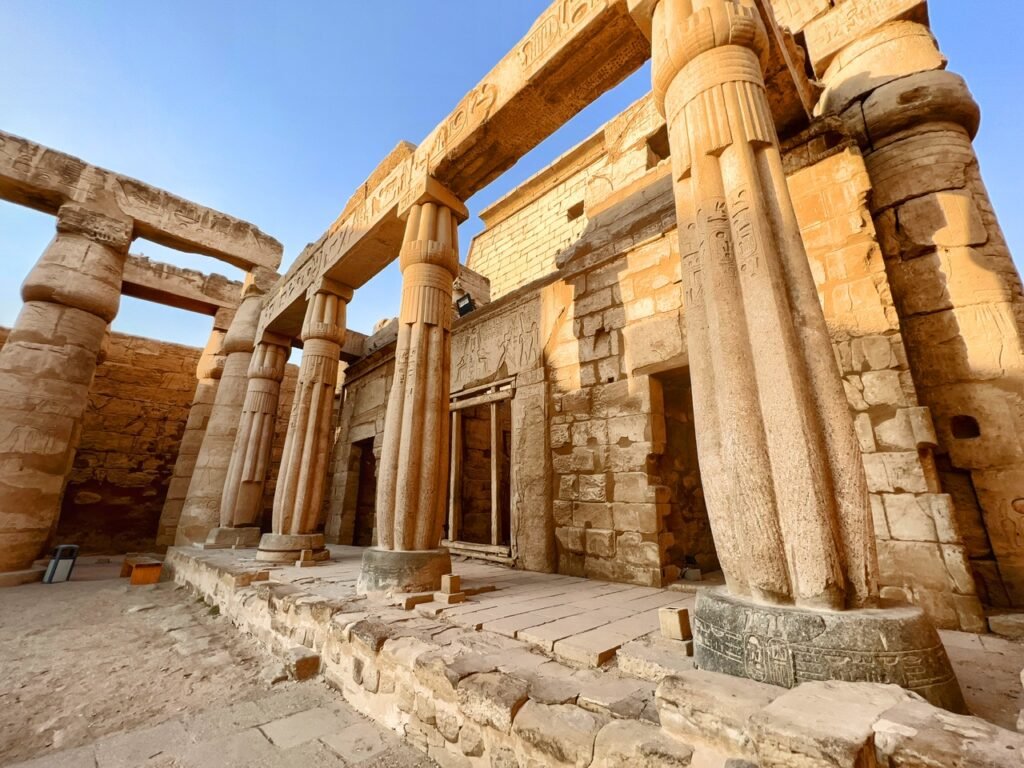
Bundled Papyrus Bud Columns.
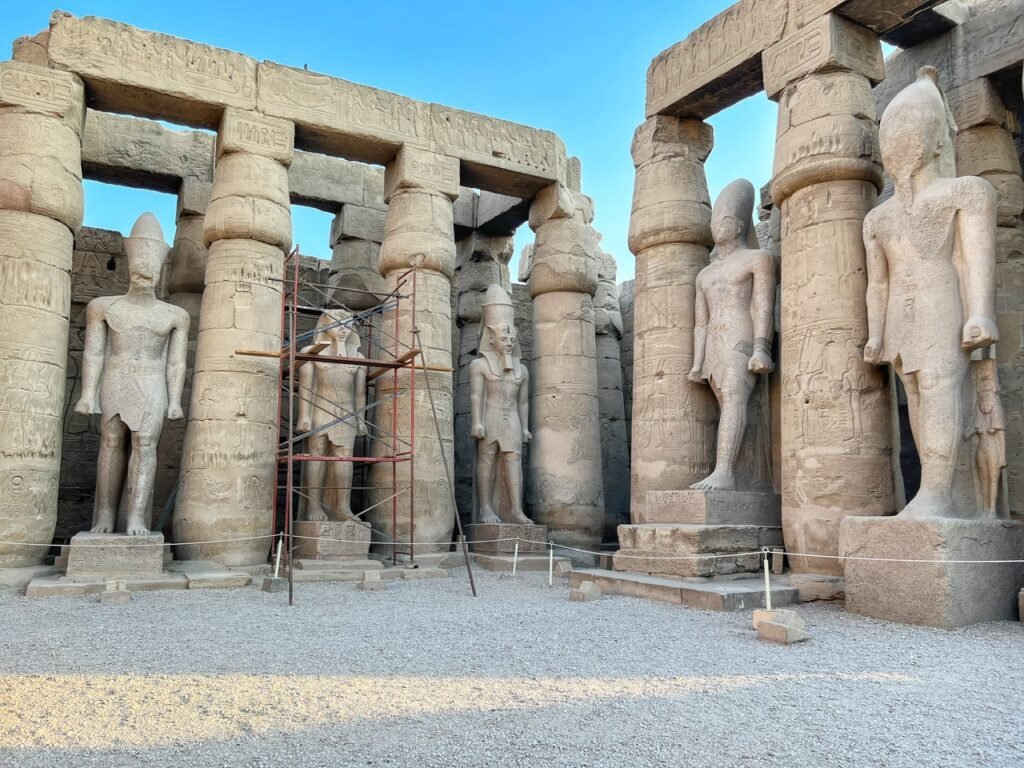
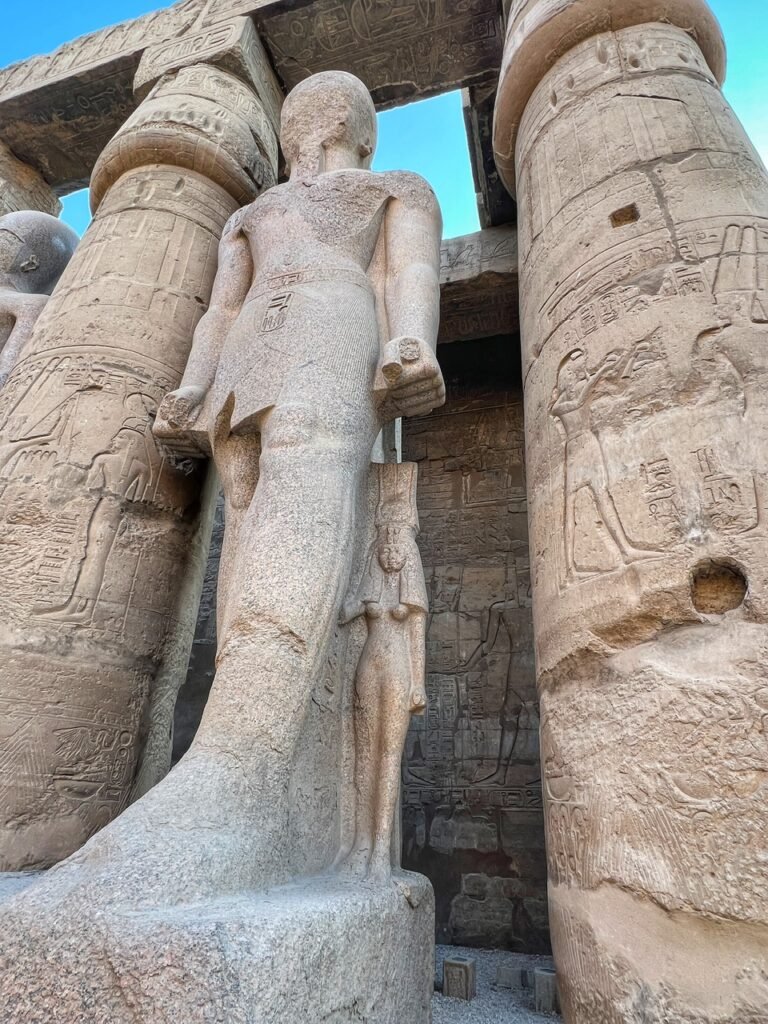
Some of the seventeen sons of Rameses II, as well as a close-up of a son with his little wife tucked under his skirt. We can’t decide if these little Thumbelina women are creepy or cute.
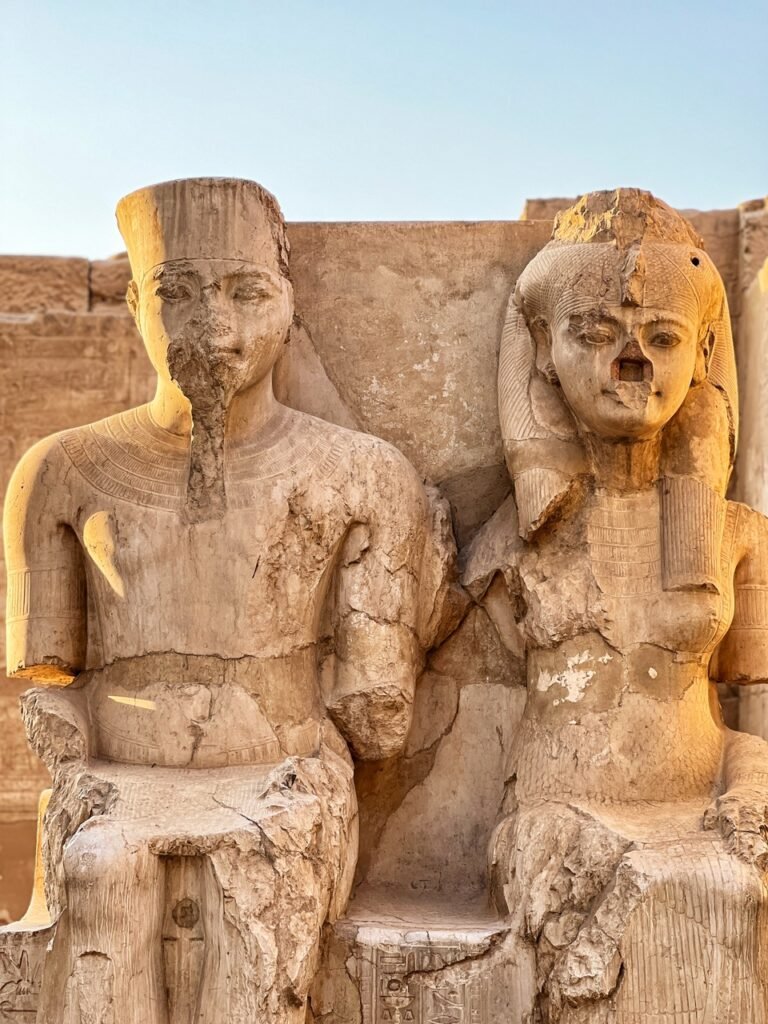
Ancient Egyptian Power Couple.


The Great Colonnade Hall of Amenhotep III and Tutankhamun, which commemorated Amenhotep Ill’s deification while alive but remained unfinished at his death. It was completed by Tutankhamun, who inscribed most of the walls, but who died before all of the decoration could be finished.

A panorama of the scene.
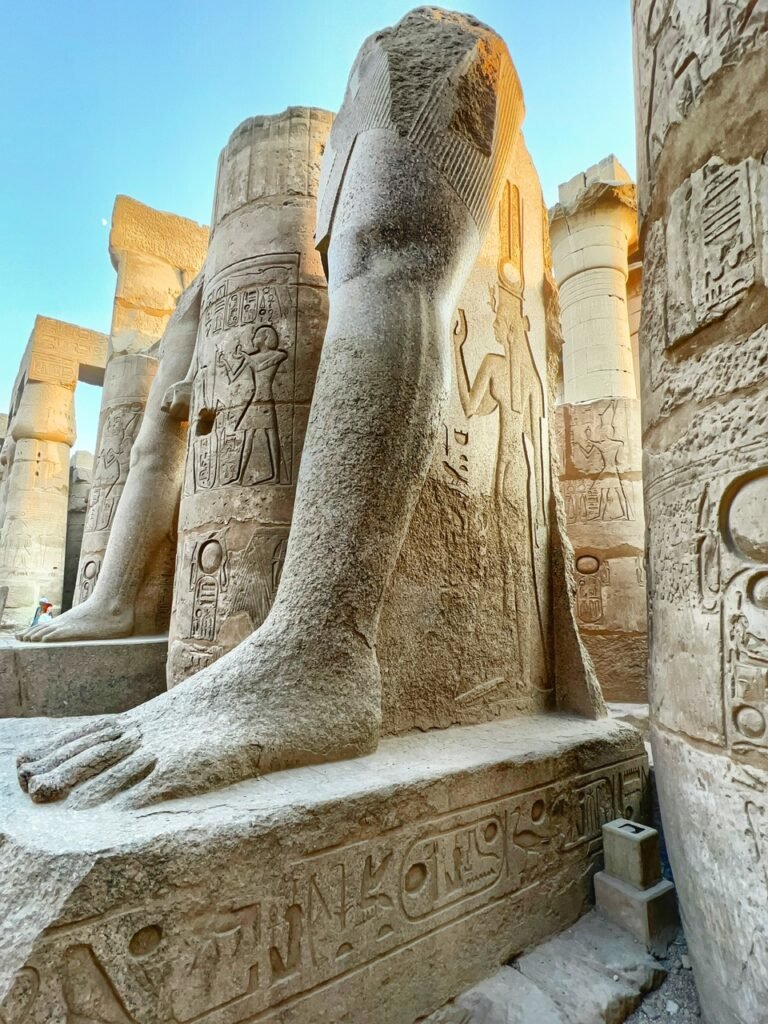
He’s got legs! And he knows how to use ’em!!
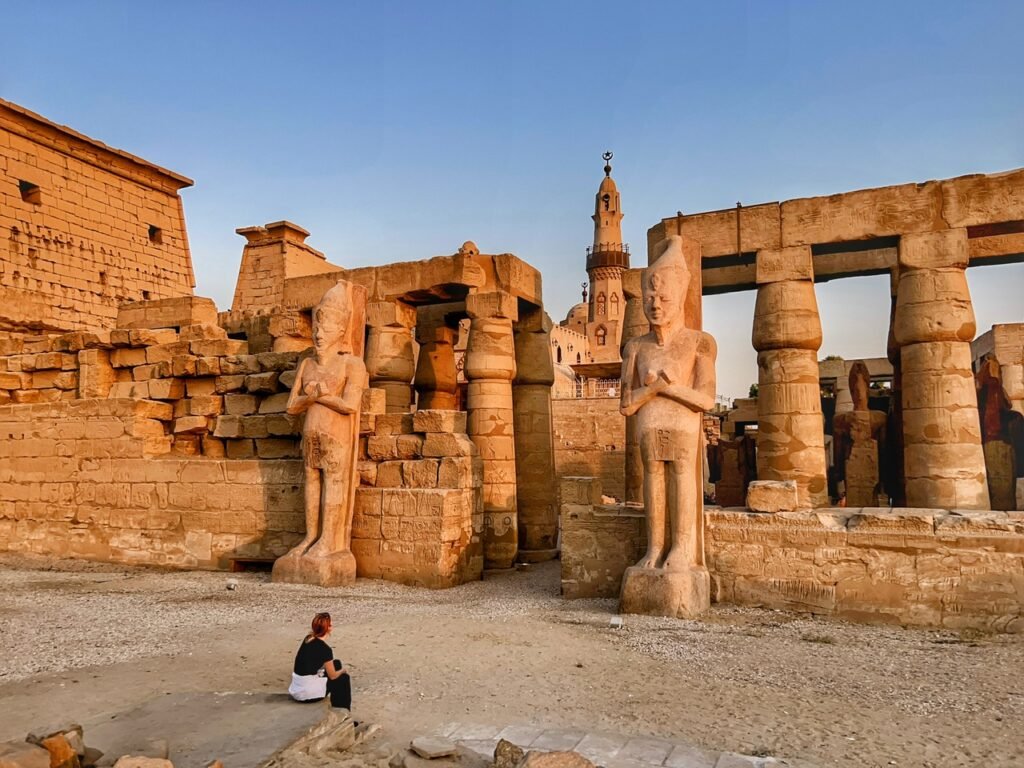
The glorious temple at sunset.
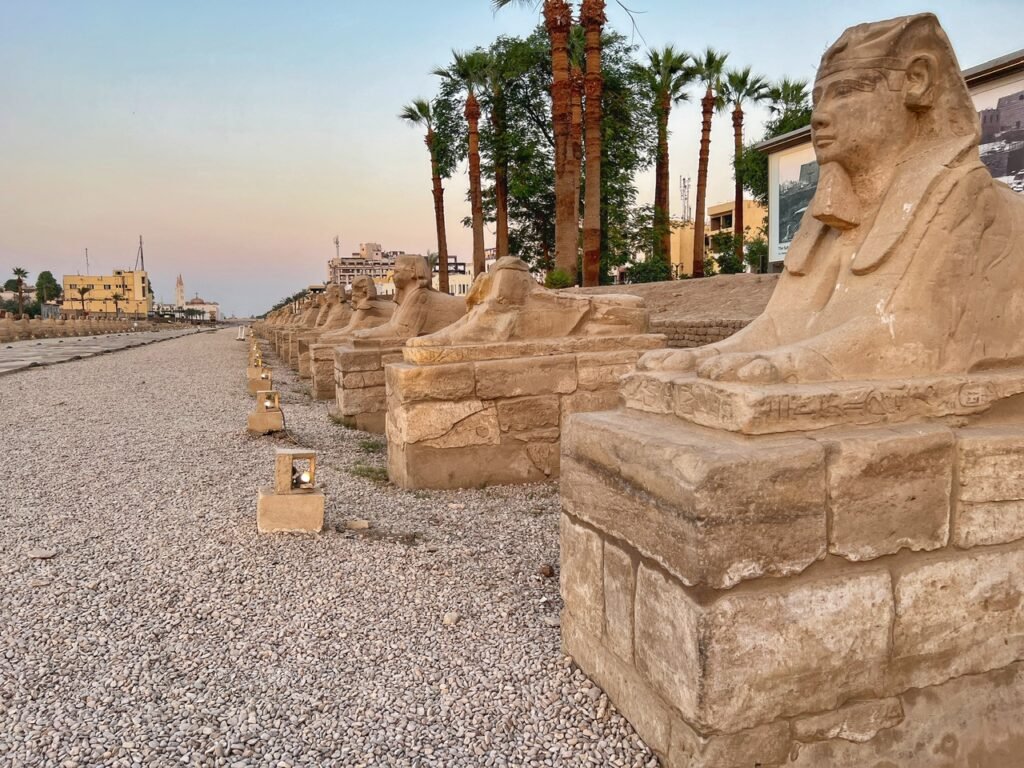

The Karnak temples are located on the eastern bank of Luxor and linked to the Luxor Temple by the processional way called the Avenue of Sphinxes. The Avenue of the Sphinxes is 3 kilometers long and still being excavated.


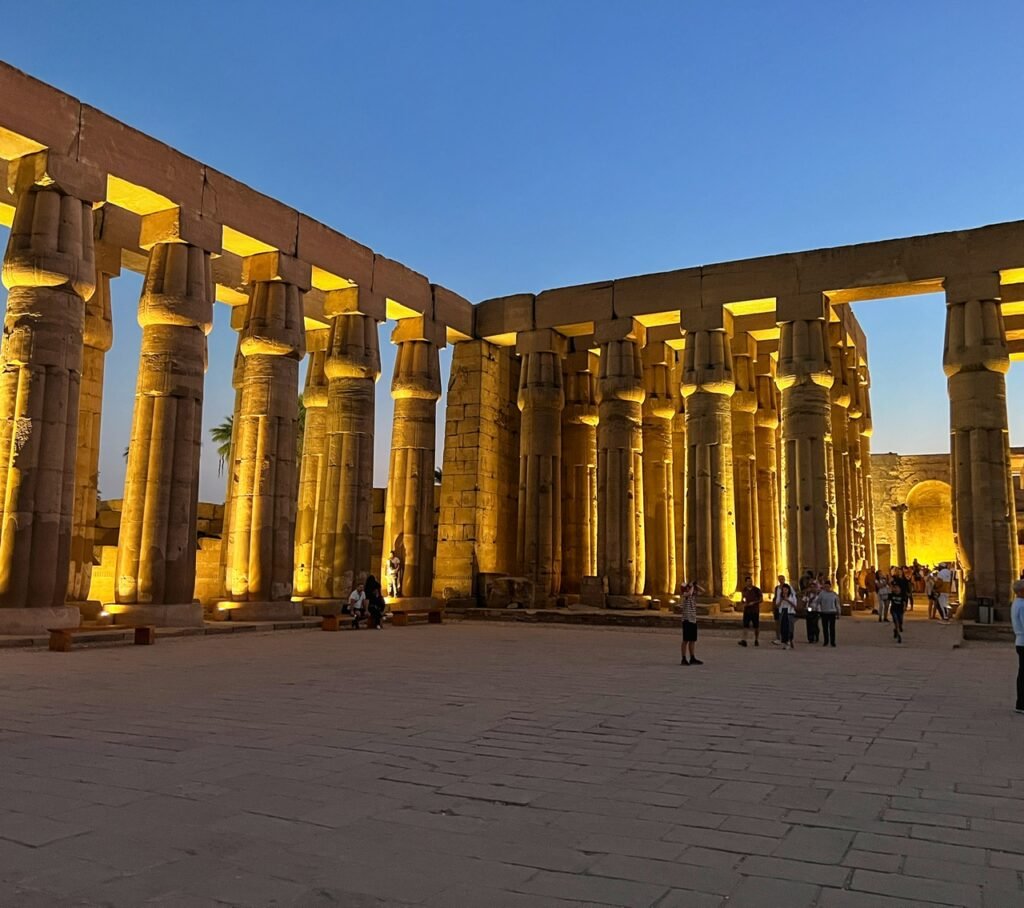

As twilight emerges, we reentered the temple, along with everyone else.
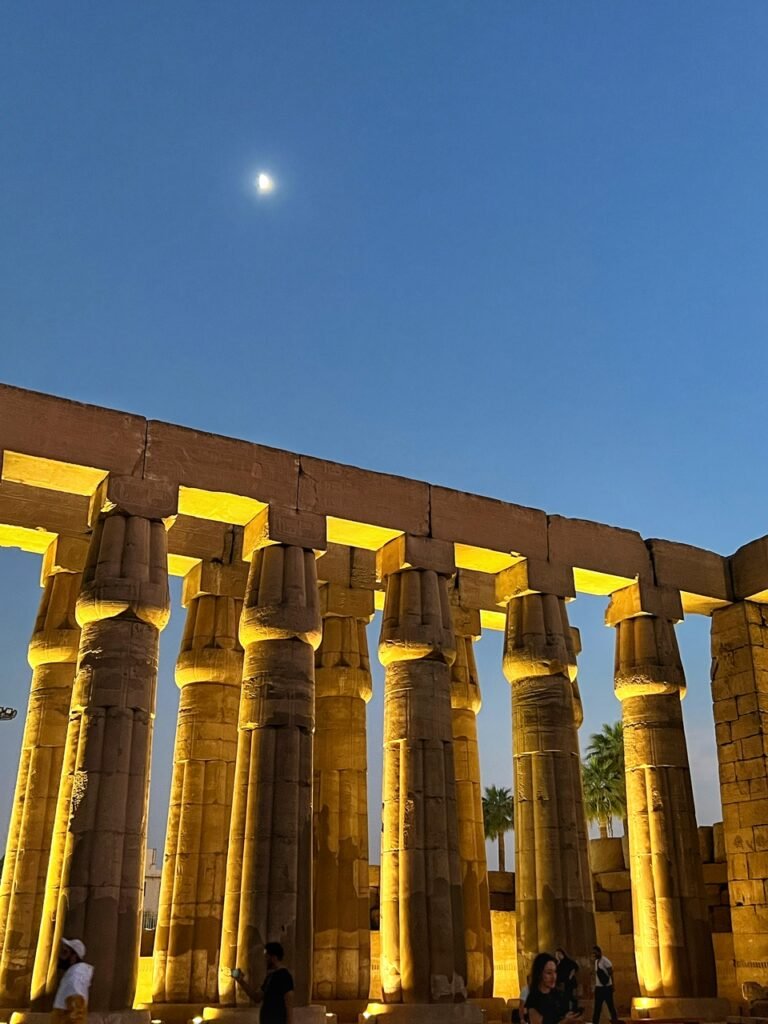
To us, it looks a bit like a box of drill bits under the moonlight.
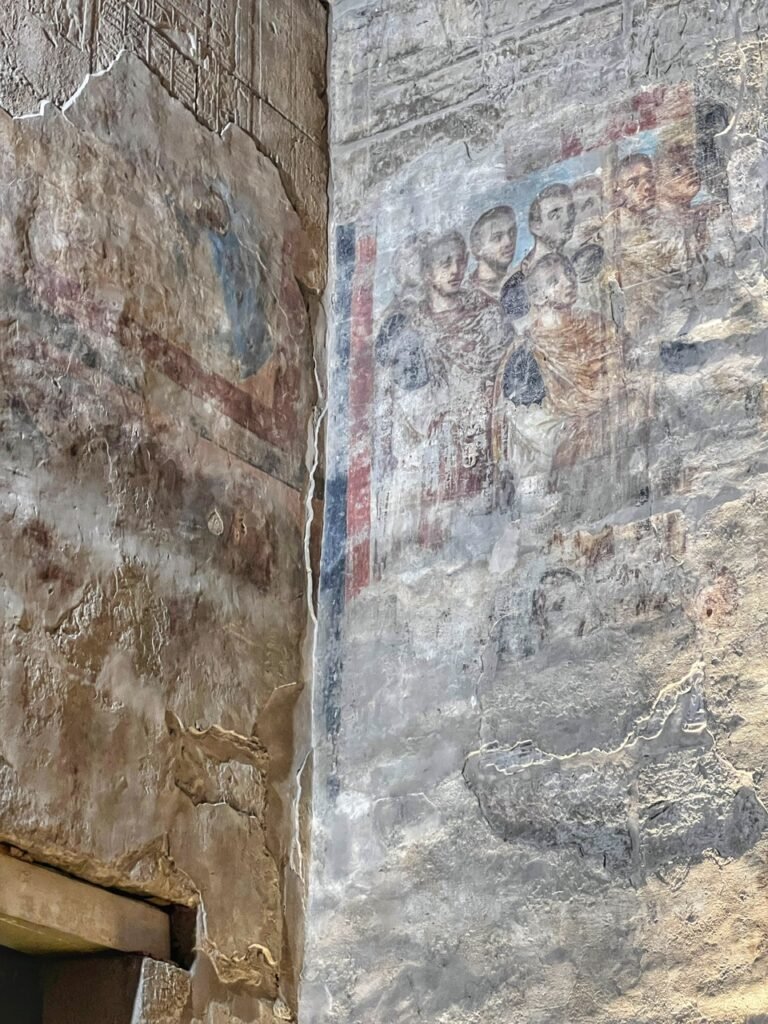
Egypt was a province of the Roman Empire from 29 BC until the Arab conquest in 641 AD. In the year 298 the emperor Diocletian came to Egypt in an impressive show of strength intended to consolidate Roman control over the country. Luxor Temple was converted in about the year 300 into a Roman monument, which is why if you look hard enough you can find little bits of Rome throughout.
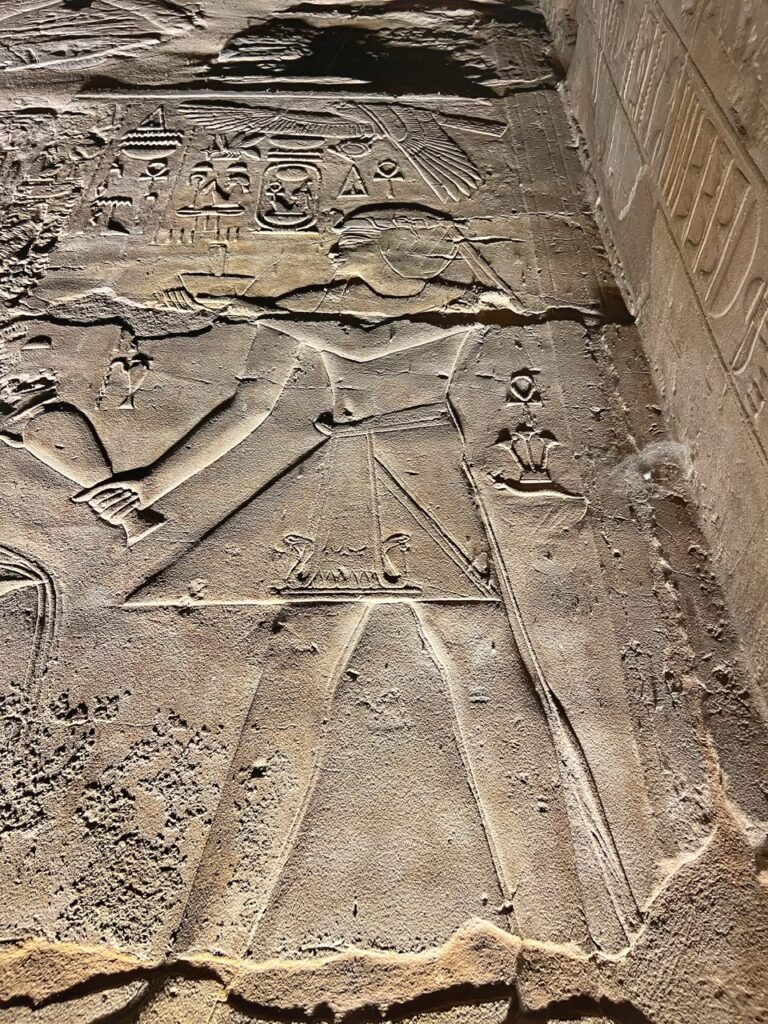
Watch out! This one might bop you with a drumstick! ![]()
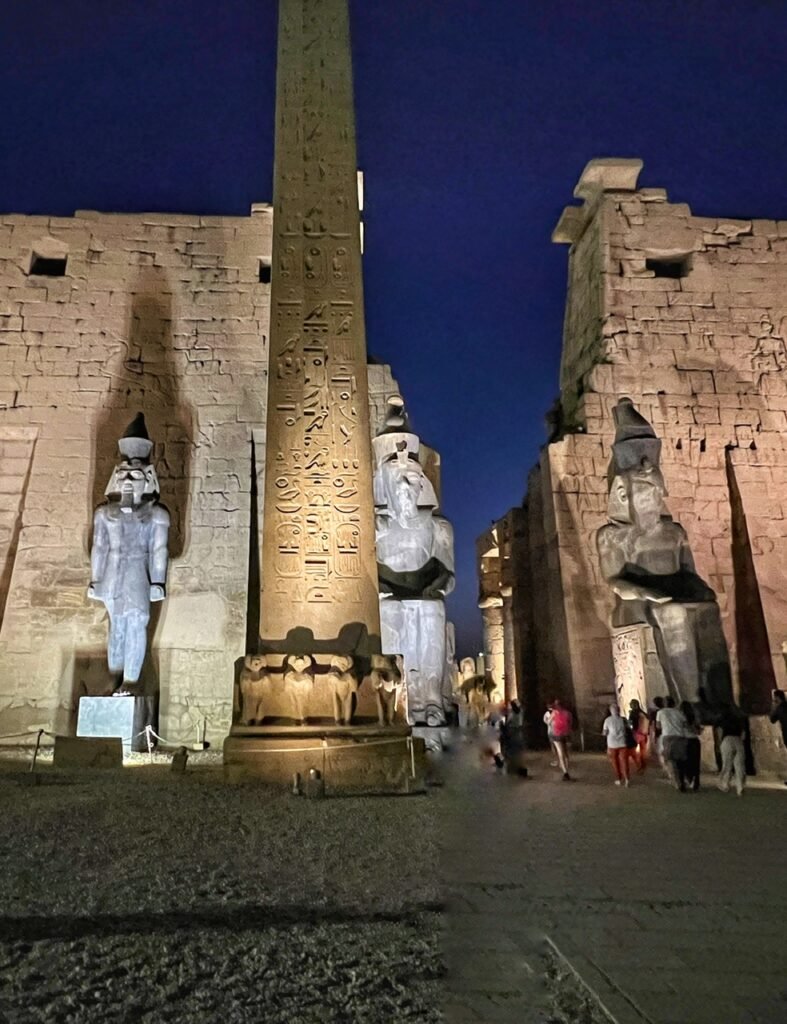
The nighttime cast an ethereal ambiance.
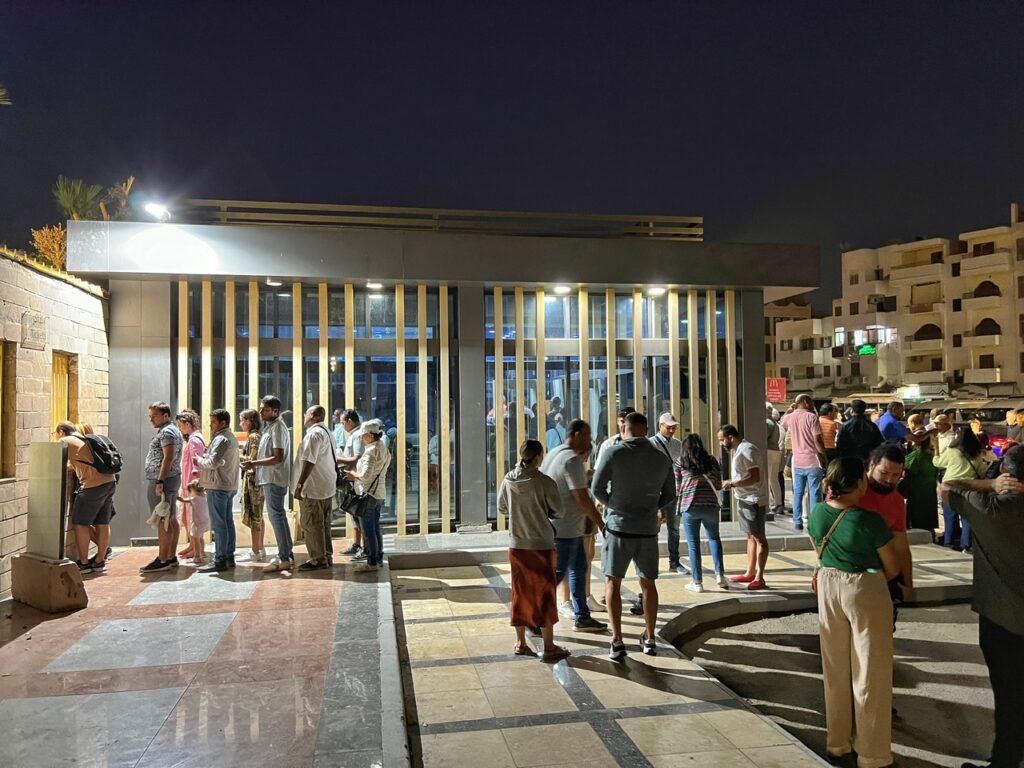
We couldn’t believe all the tour buses and people when we exited at about 6:00 who were waiting to enter.
Deir el-Medina Worker’s Site
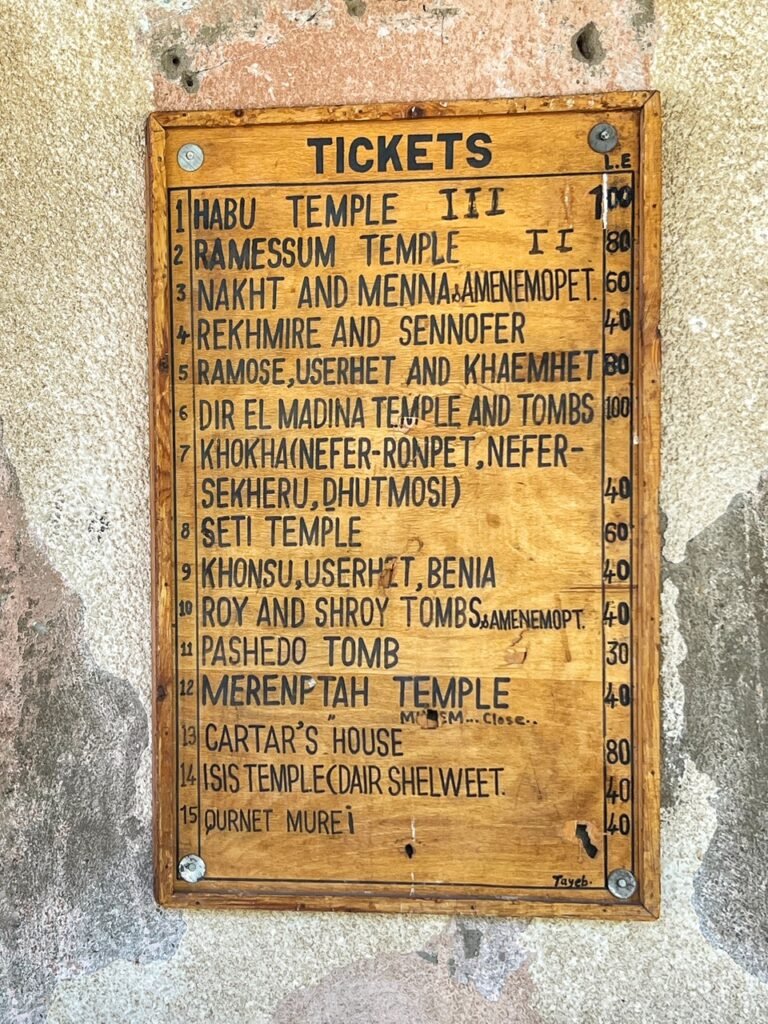
Although we appreciated all the temples and tombs of Luxor, unsurprisingly our favorite were the ones few people visit… the site of the Deir el-Medina which consists of the houses, the remains of the village and their own color-blasted necropolis associated with the community of artists, artisans and workmen engaged in the cutting and decoration of the tombs in the Valleys of the Kings and the Queens during the New Kingdom (c. 1500 to 1100 B.C.).
That’s right…hundreds of male masterminds devoted themselves exclusively to the creation and decoration of the tombs of their pharaoh. And these workers of the royalty were far from slaves. In fact, they were brilliant artists and treated quite well, while alive and apparently dead too based on their tombs.
To get out to the site, we asked Mohammed to drive us out to the sites (in exchange for a hefty tip!) First we had to stop and get our tickets at a ticket office that looked like it fell out of Spielberg’s set from Indiana Jones. The cost for tombs was 100 Egyptian pounds each ($4) and well worth it.

Passing an abandoned village. We don’t know its story, but one of our followers indicated their guide had told them the yellow houses indicated the inhabitants had been to Mecca.

When they weren’t making pharaoh tombs, the workers had their own dazzling death chambers, which they obviously chiseled away on weekends or Bank holidays. The first we came to was the Tomb of Inherkha. Inherkha, according to the entrance sign, was a servant in the place of the truth and a chief workman.
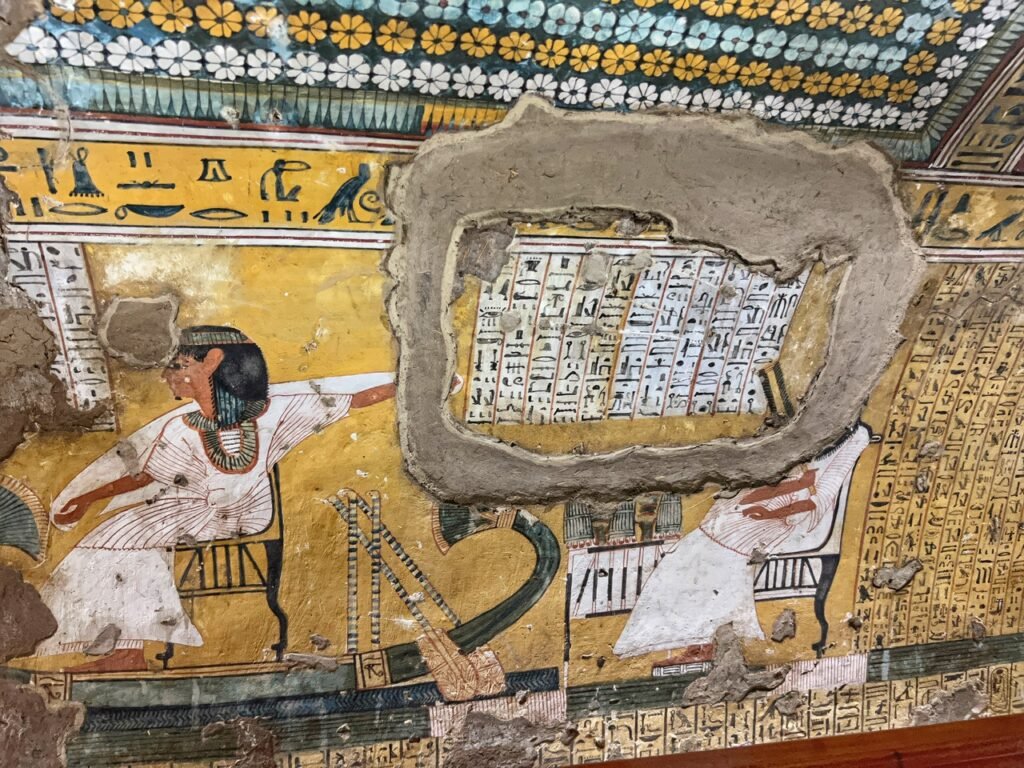
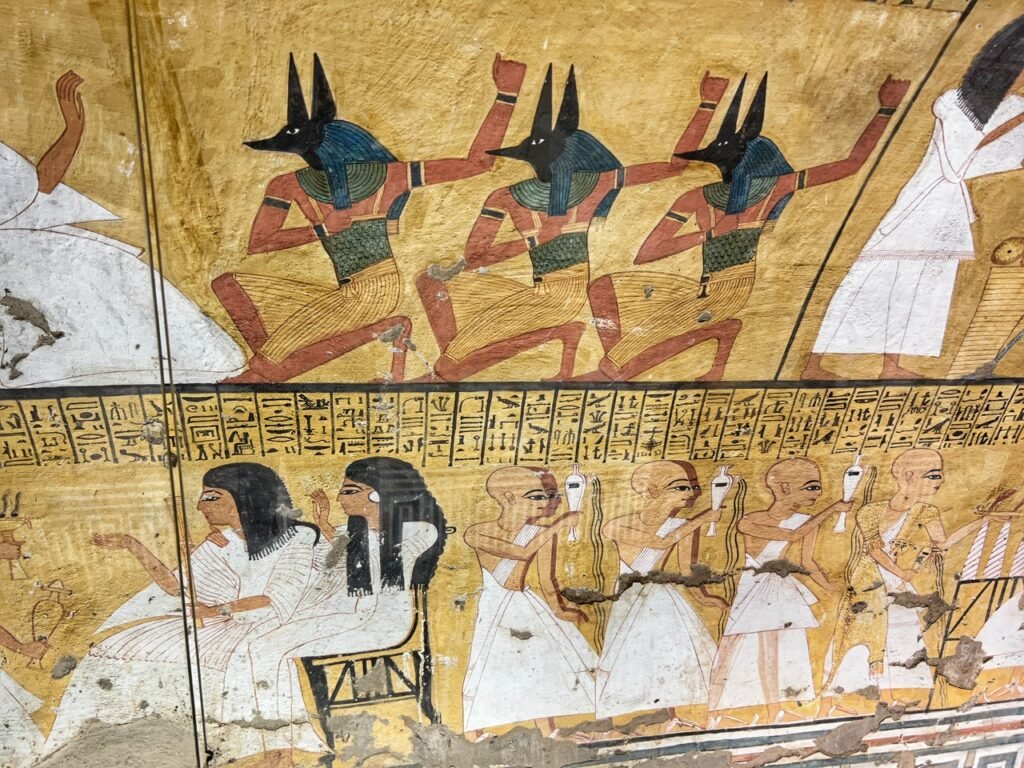
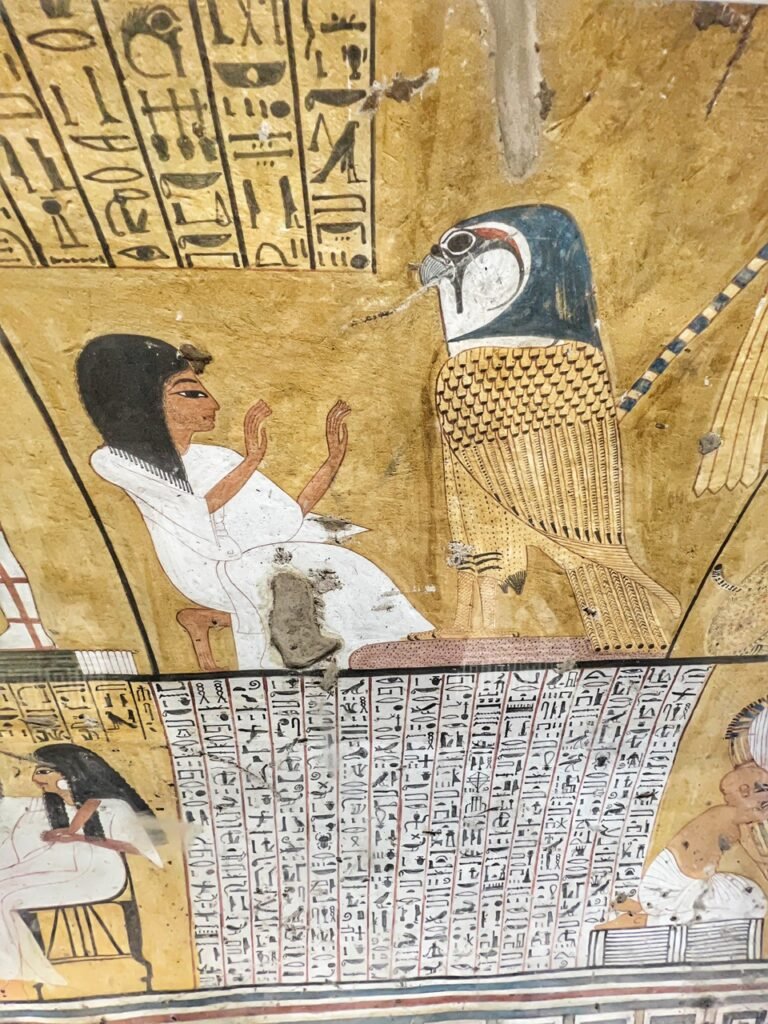


This tomb contains one of the best artistic examples of the 20th Dynasty, containing scenes from the book of the dead and of the book of the gates, as well as scenes showing the underworld.
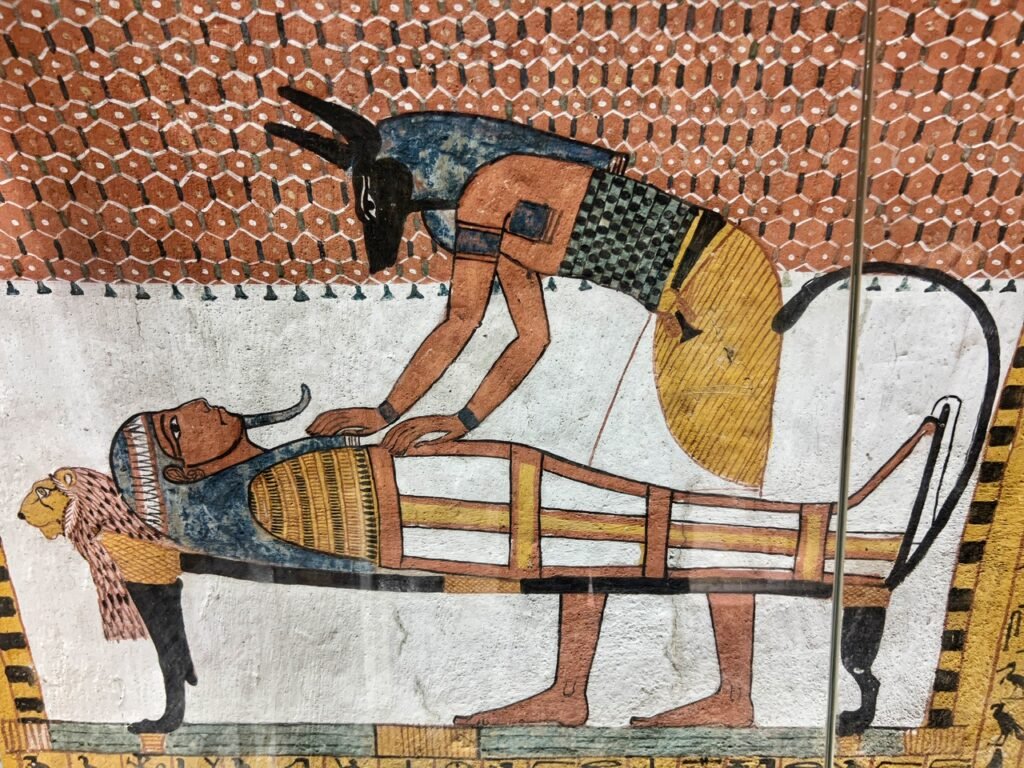
Tomb of Sennutem. Not sure who this guy was, but must have also been a Valley of Kings CEO based on the glitz of it. It was discovered in 1889 with valuable contents of funerary furniture, which are now in the Cairo Museum.

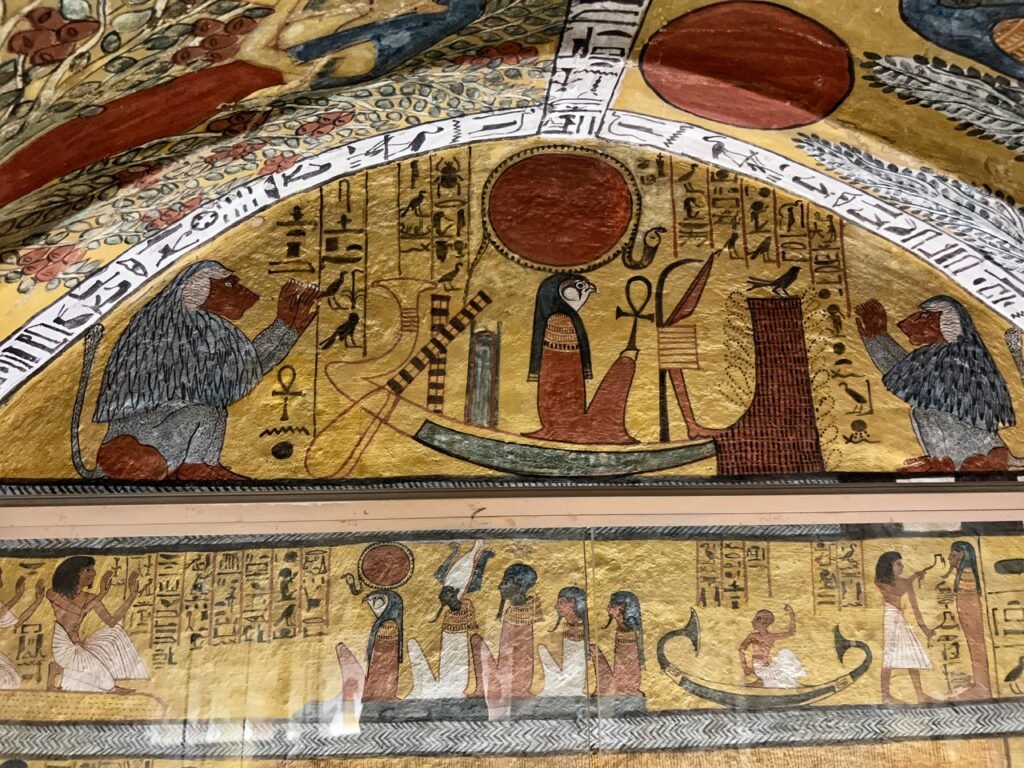
Its scenes are exquisite and its colors are in impressive state.
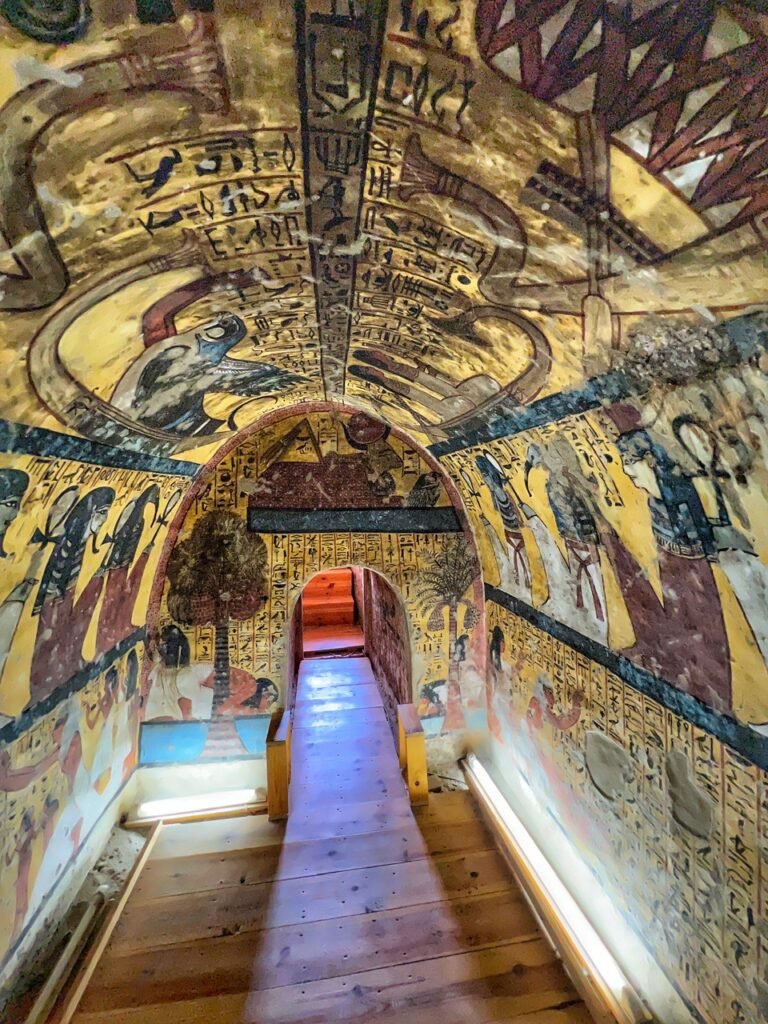
The Family Tomb, from the reign of Rameses II, consists of three tombs, belonging to the father Amun Nakht and his two sons Neb-en-Maat and Kha-em-teri who were working as servants in Deir el-Medina during the reign of King Ramses II.
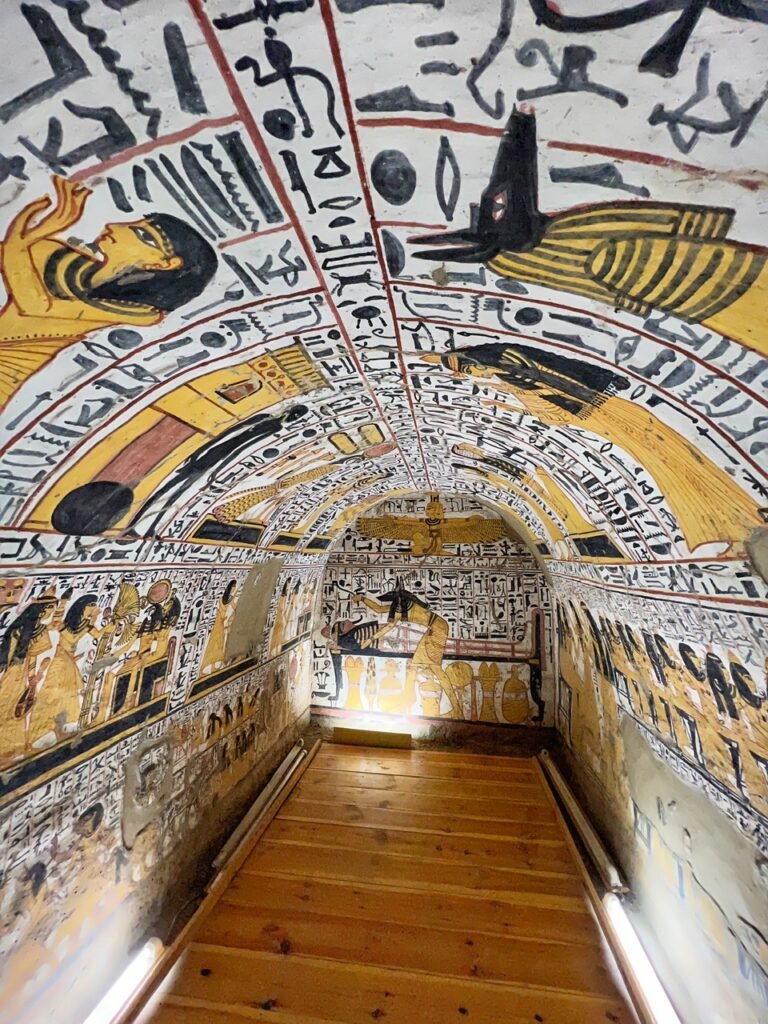
The tomb consists of an entrance that leads to a hall with a vaulted ceiling. followed by a transversal hall that leads to three burial chambers surmounted by three chapels.
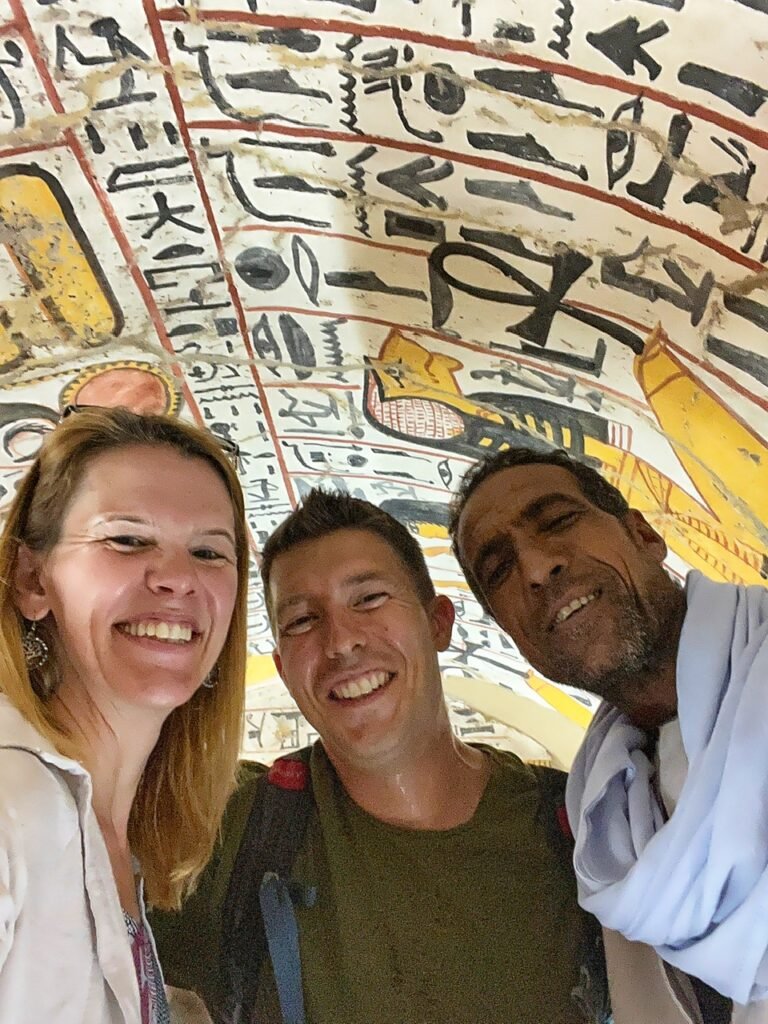
In the family tomb, we also picked up a friendly guide who pointed out some of the hieroglyphs and notable images. When we gave him $1 at the end, he literally kissed it with gratitude.
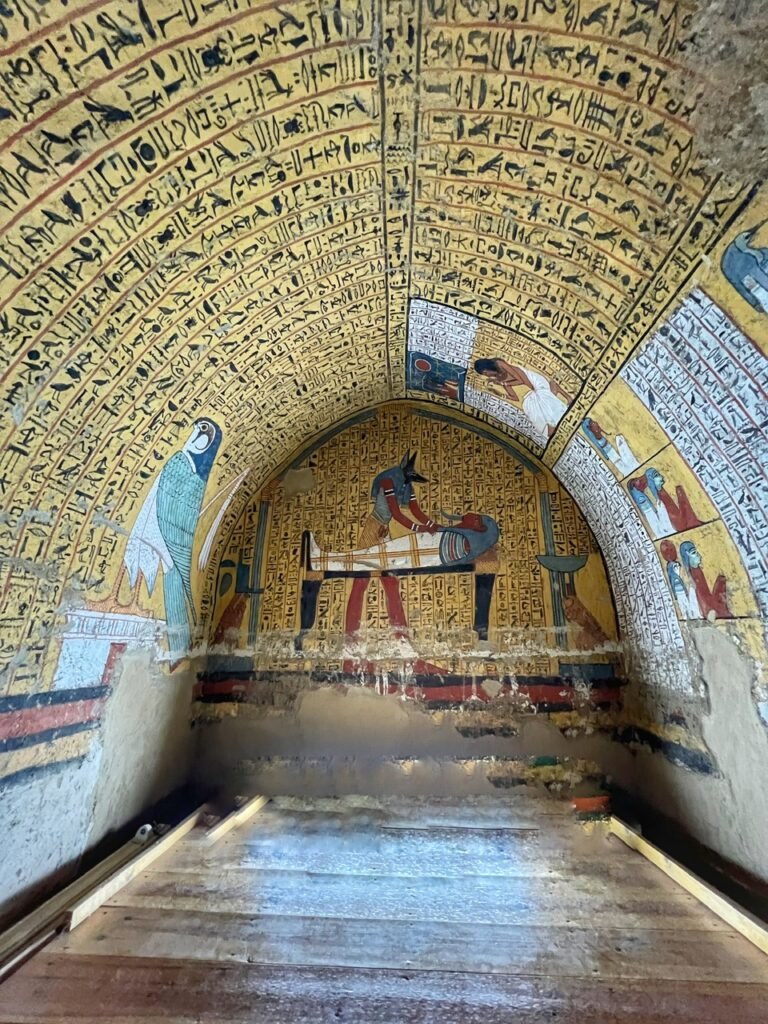
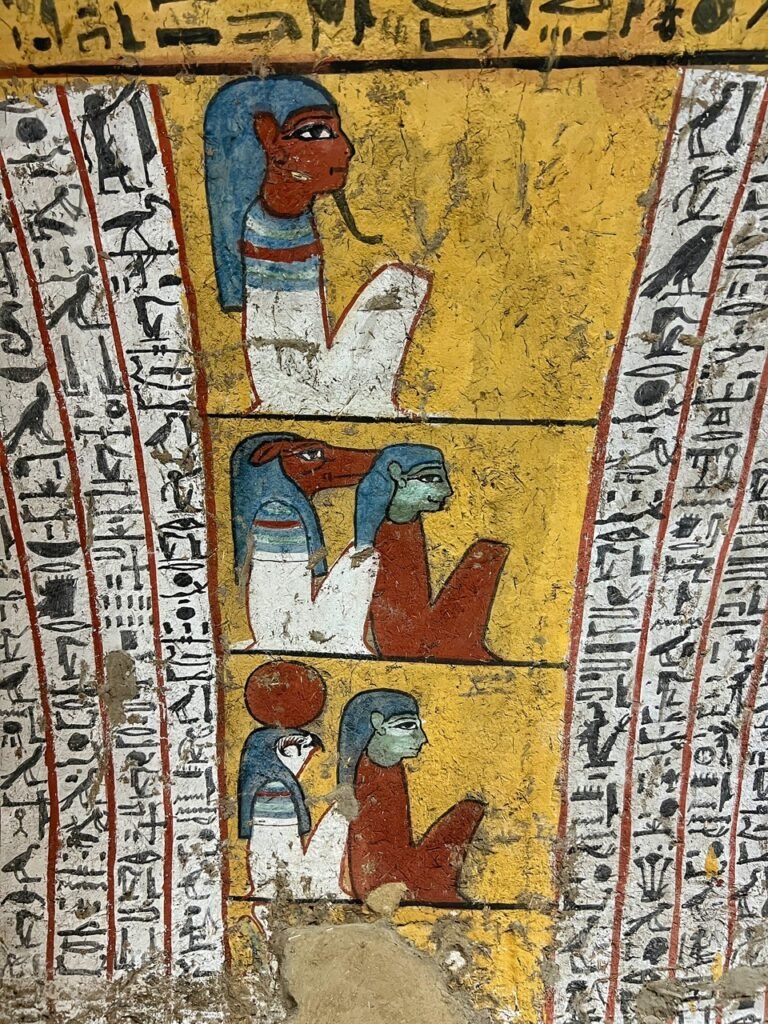
We think the worker’s saved the best tomb art for themselves 🤣 It’s like a comic strip, but you have no idea what is going on.
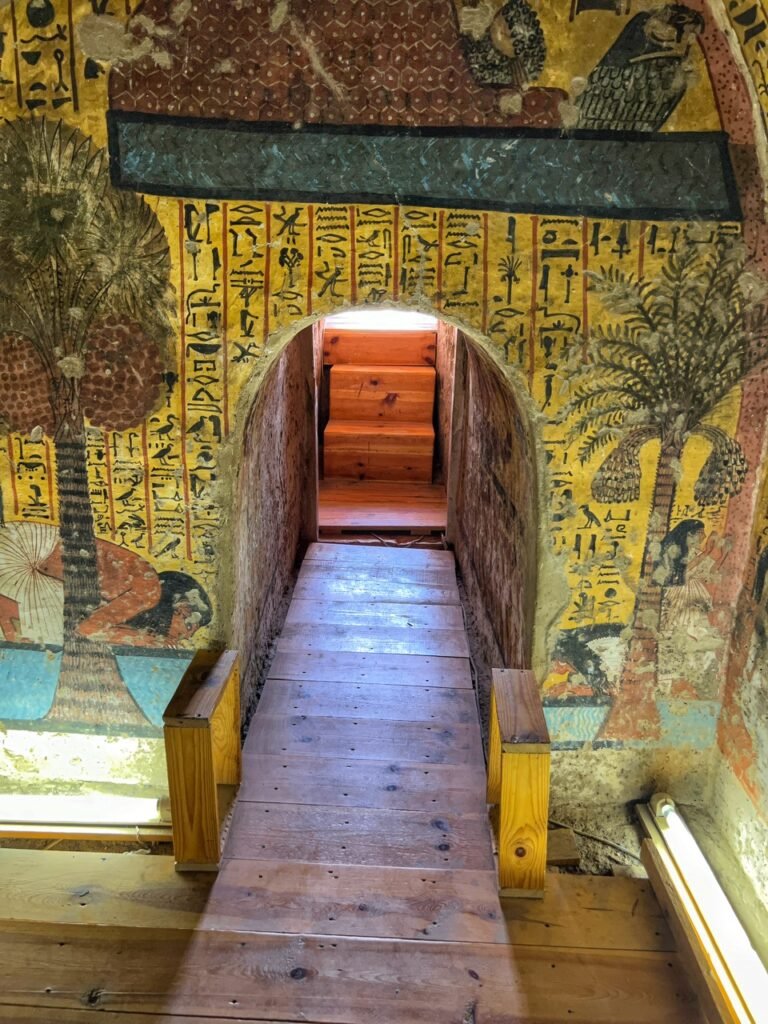
Exiting the tomb. There was lots of crouching and bending, but no crawling involved. These were so amazing to visit because there were basically empty! A much more enriching experience than Valley of the Kings for this reason alone!
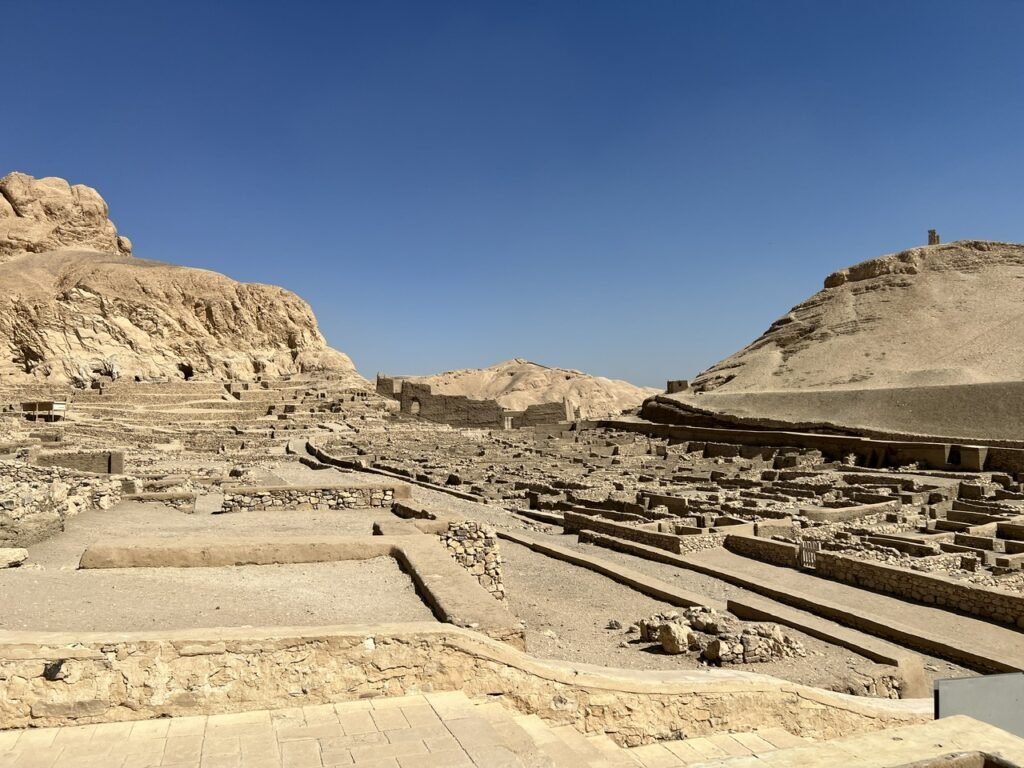
The village where the worker’s lived with their families. It is composed of 68 contiguous houses each divided into a series of four linked rooms, covering a total surface of approximately 70 square meters each. Door sills, door jambs, and lintels are of stone as are also the frameworks of niches and the bases of columns, while the walls are constructed of mud brick mixed with straw. Texts from preserved papyrus give an impression of a simple but well-organized social life: men leaving every morning for their work in the tomb, women, children and old people remaining at home. Such families consisted of 6 up to 10 persons. They preserved records of ordinary, everyday affairs, personal aspirations, artistic and literary creations, intellectual speculations, fears and hopes attributable to the community of persons who inhabited the village more than 3000 years ago.
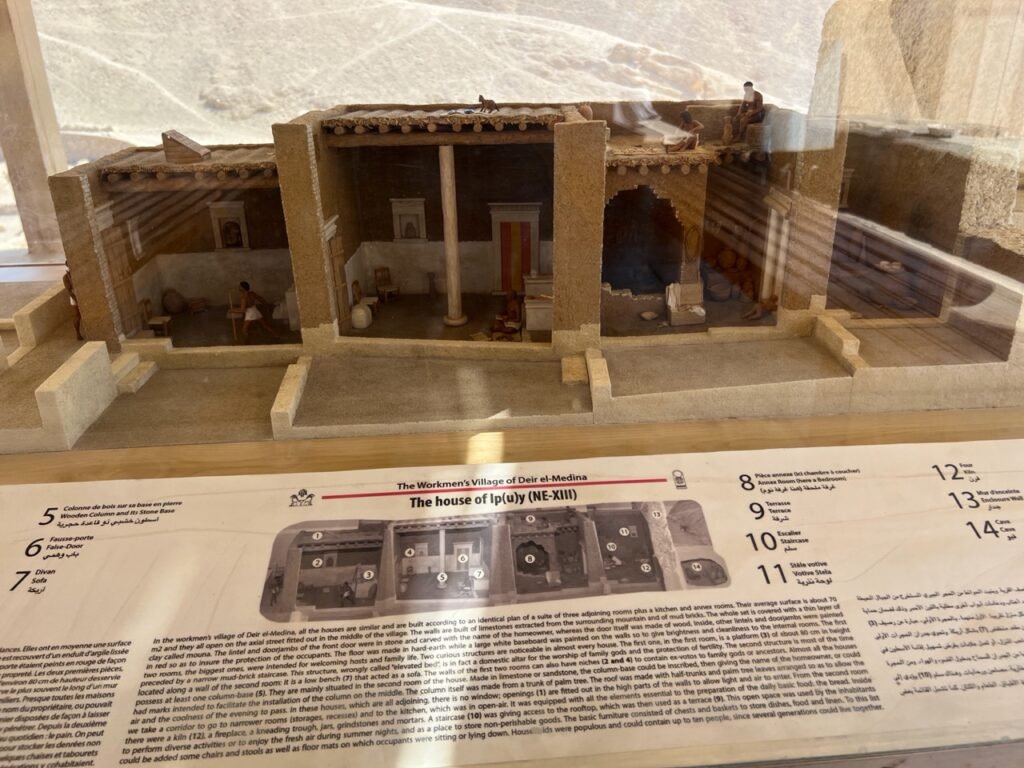
A mock-up of what their houses might have been like.

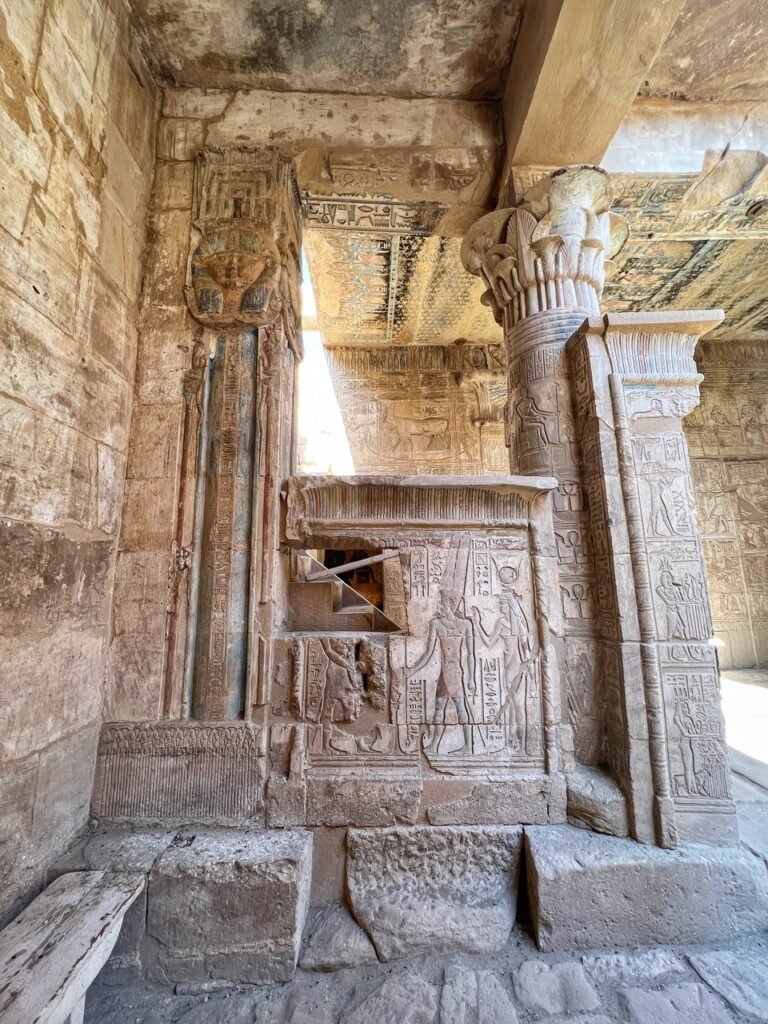
The 3rd-2nd Century BC Temple of Deir El-Medina was dedicated to Hathor, Maat Amnhotep and was transformed into a monastery in the Coptic Period.
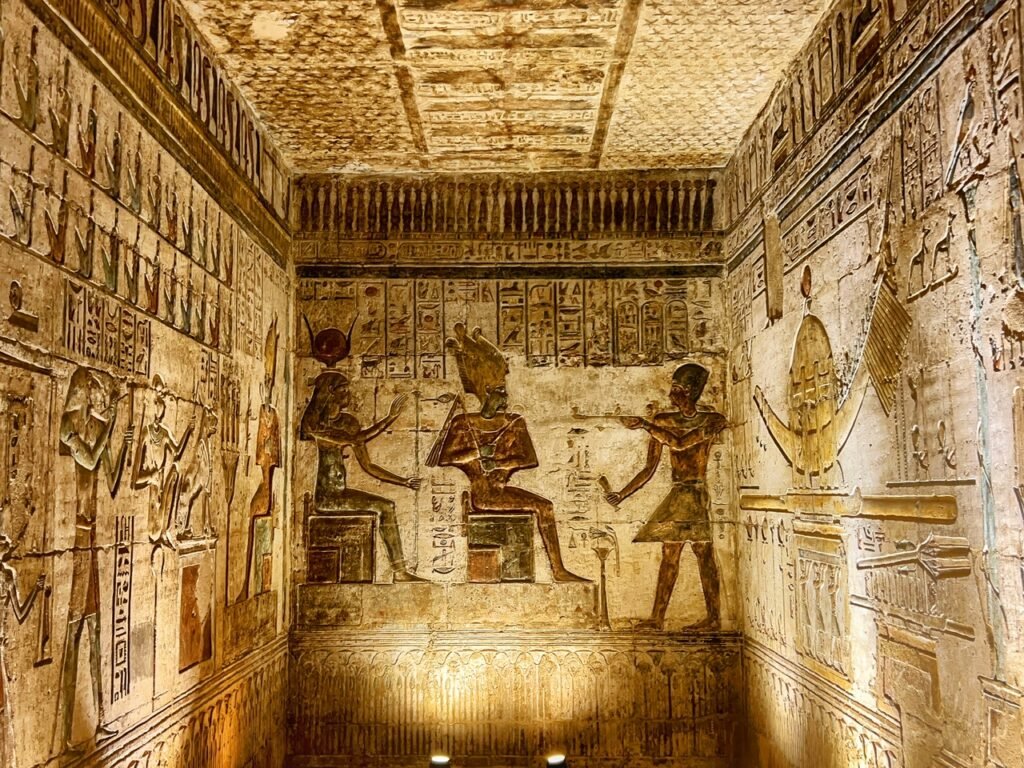
The images were detailed but colors were not quite as vibrant as in the tombs.
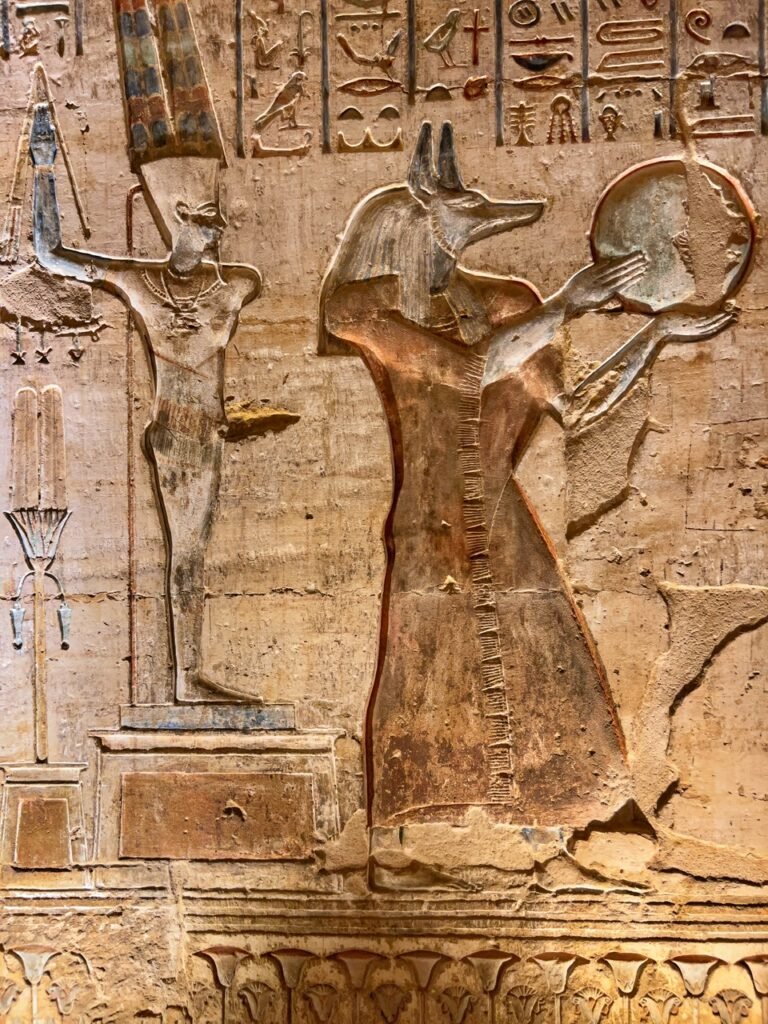
You might notice some light pornography here. A rather cocky-looking man is poking the dog god Anubis, in the back. Min, with his very noteworthy member, was naturally the Ancient Egyptian mascot of fertility, harvest and embodiment. Supposedly if you stroke it you too might have luck in this department. We chose to just take its photo instead.

A 3D photo of the temple.
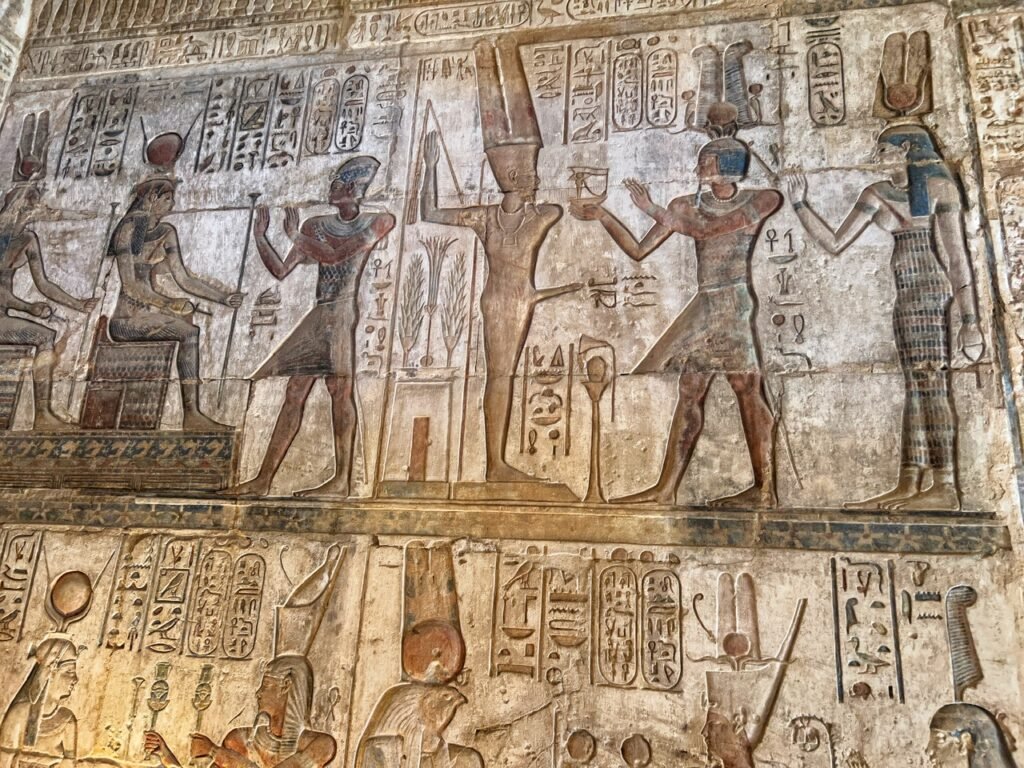
Him again. Ha. Now you can’t unsee it, eh?
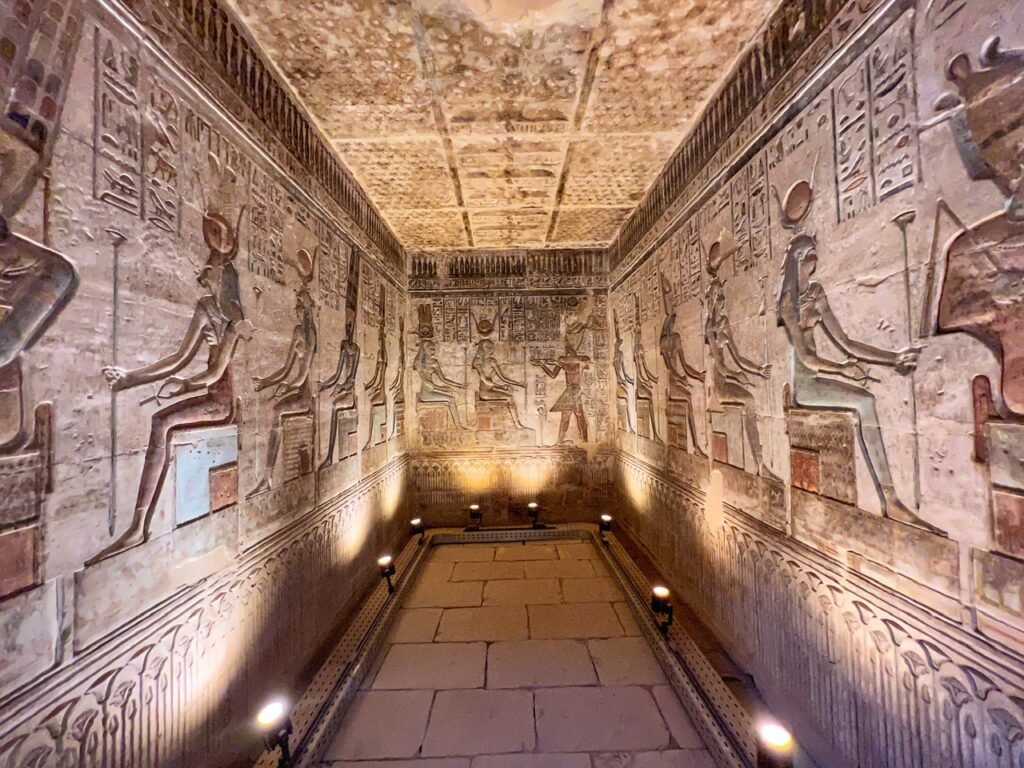
Looks like a classroom…
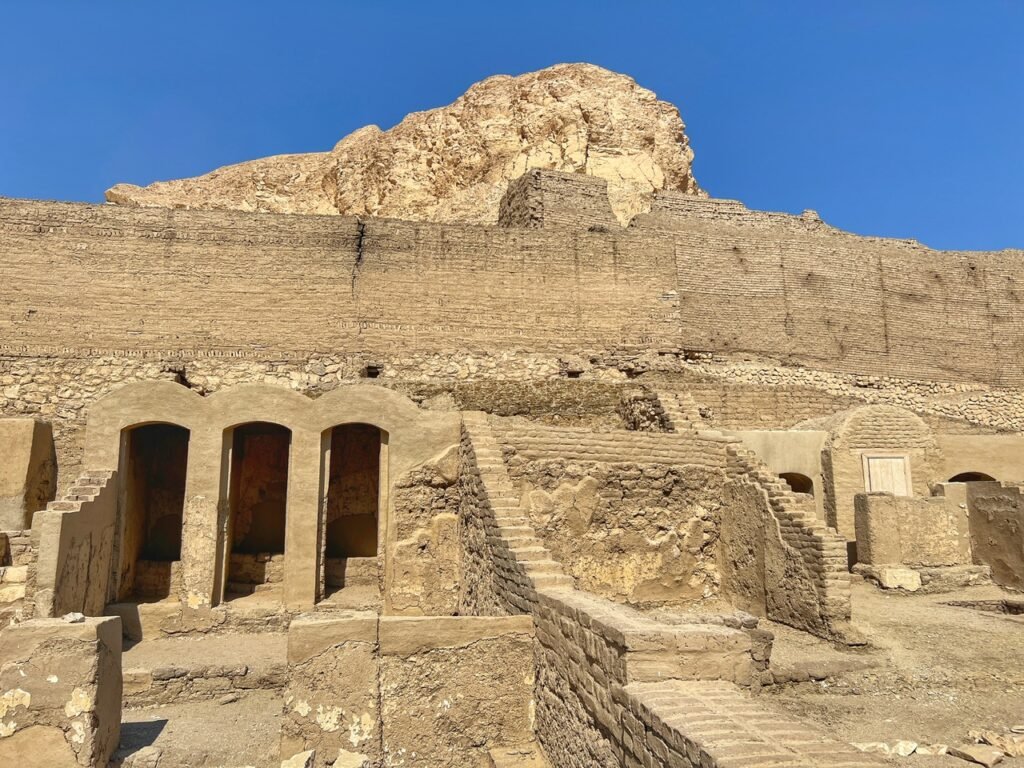
Another section of the temple complex.
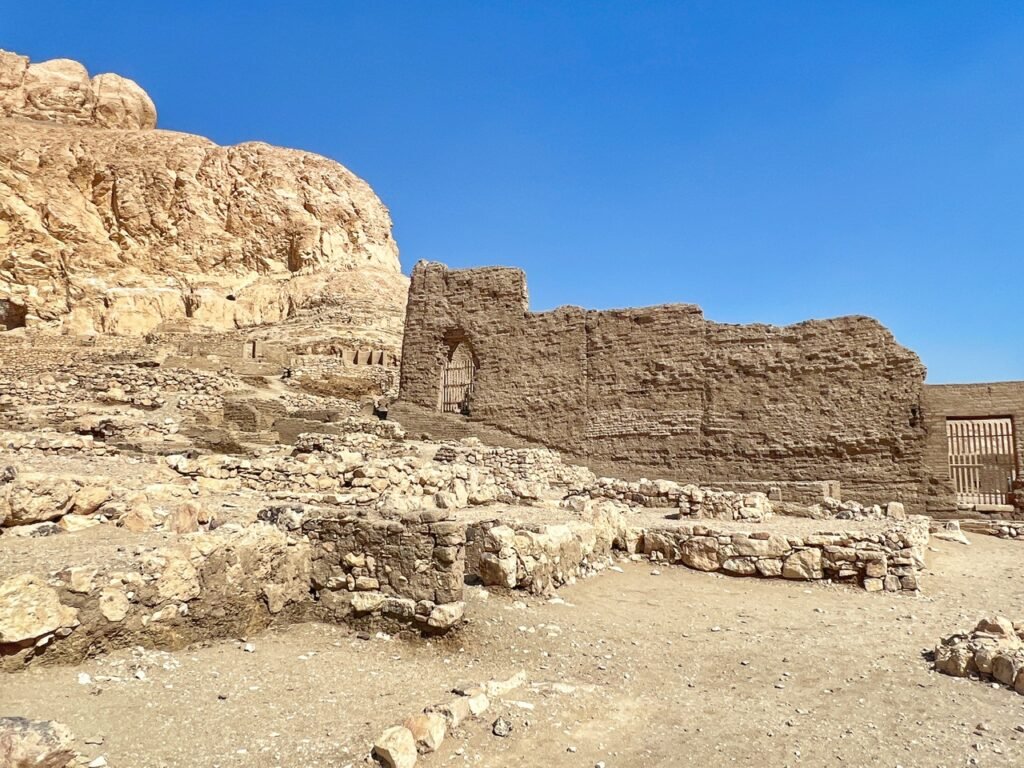
From the exterior.
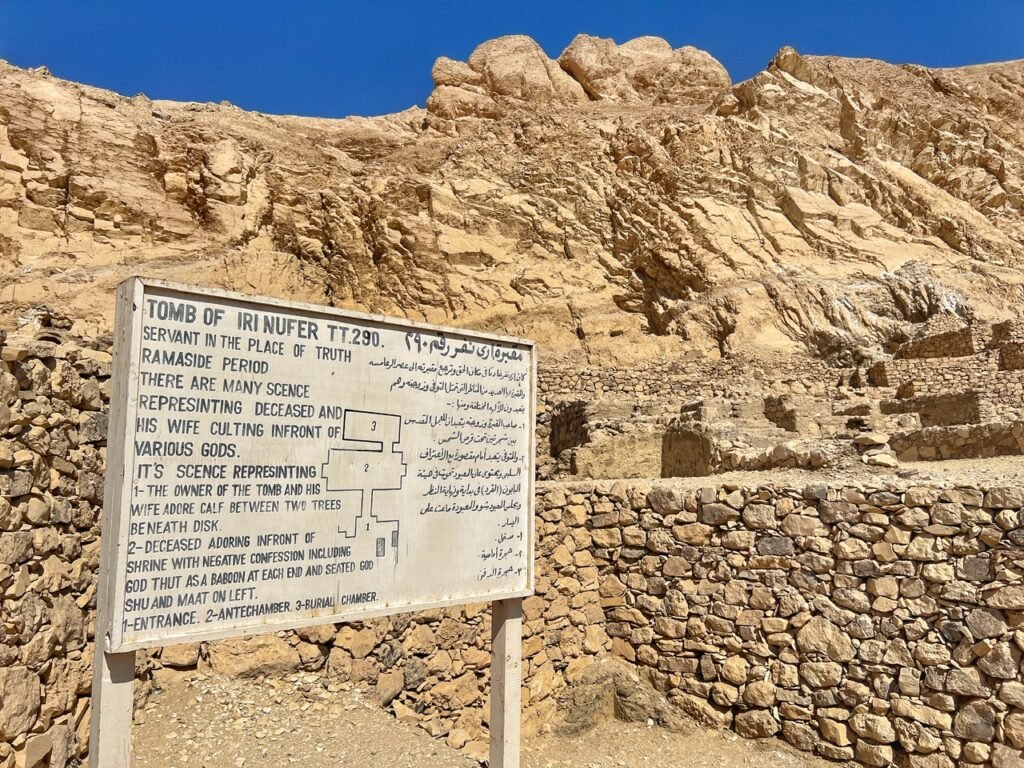
We tried to wander up to some additional tombs, and got the whistle blown at us. Even when you can’t see them, the Egyptian security guards are always watching. It’s not nearly as ripe for exploratory fun as in Turkiye. What are they worried about? Tombraiders?! Oh….
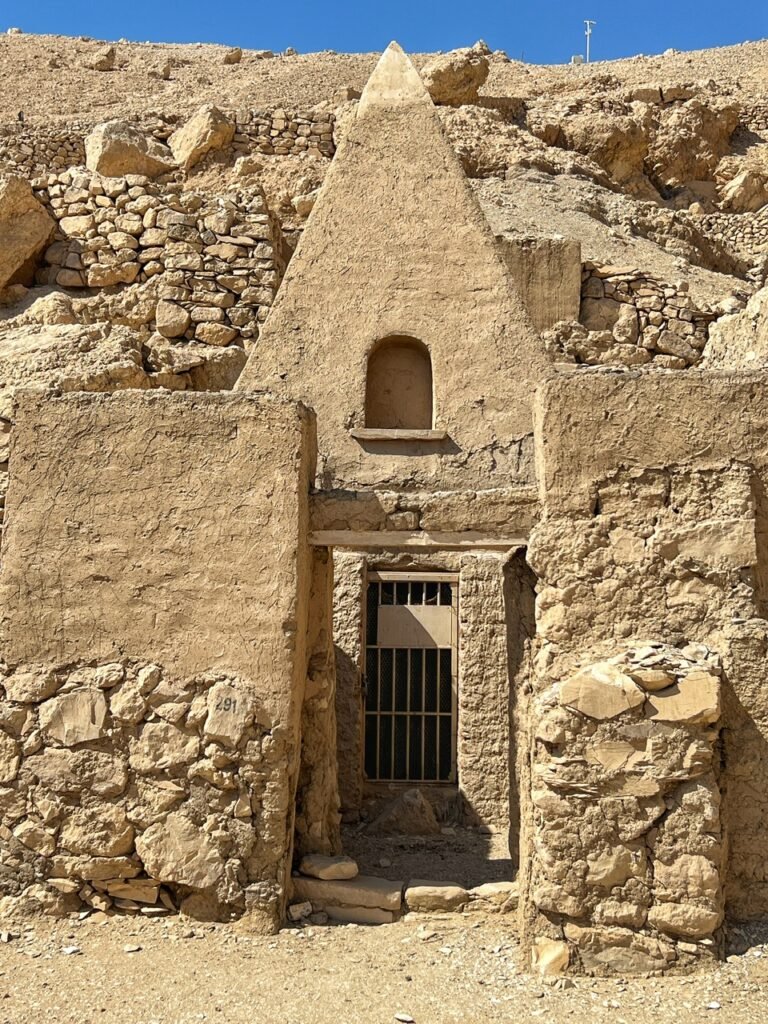
Still, we snapped a quick photo before turning around.
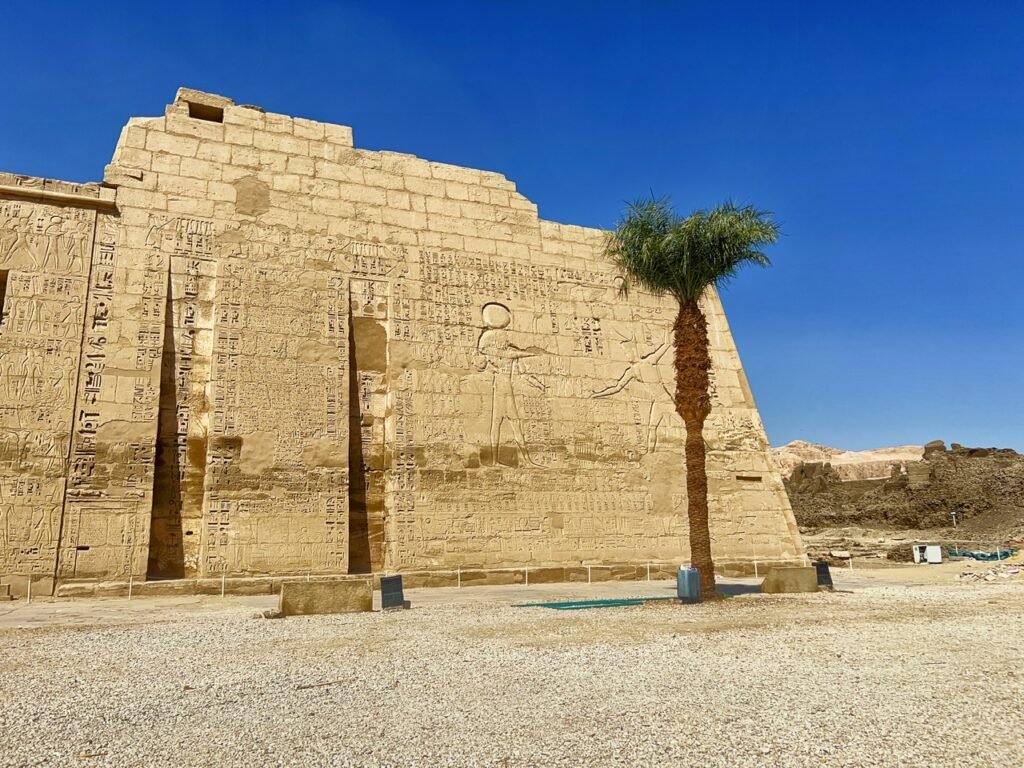
After the worker’s tombs, we stopped at Medinet Habu. According to Lonely Planet, Ramses III’s magnificent memorial temple is one of the west bank’s most underrated sites and it must be because we got in for the bargain price of $1.63 (40 Egyptian). At its height, Medinat Habu contained temples, storage rooms, workshops, administrative buildings, a royal palace and accommodation for priests and officials. It was the centre of the economic life of Thebes (ancient Luxor) for centuries.
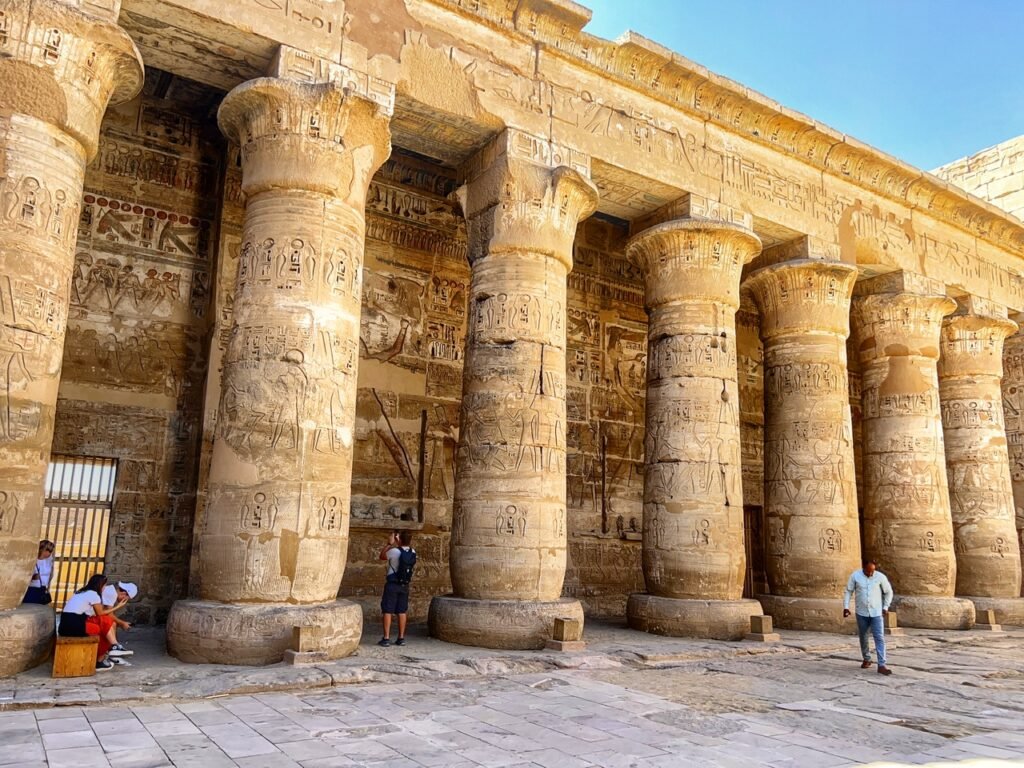
It later became an important Christian centre, and was still inhabited as late as the 9th century AD, when a plague was thought to have decimated the town.

In many reliefs, Ramses III is portrayed as the victor in several wars. Most famous are the fine reliefs of his victory over the Libyans (whom you can recognize by their long robes, sidelocks and beards). (LP)

A 3D image of the scene.
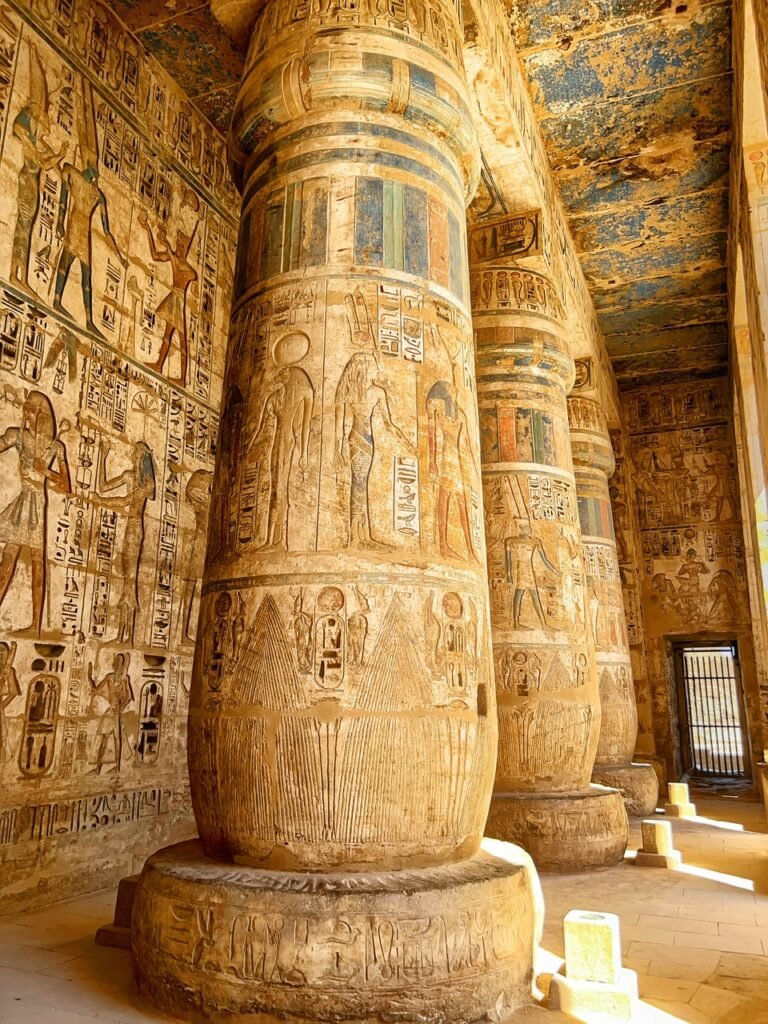
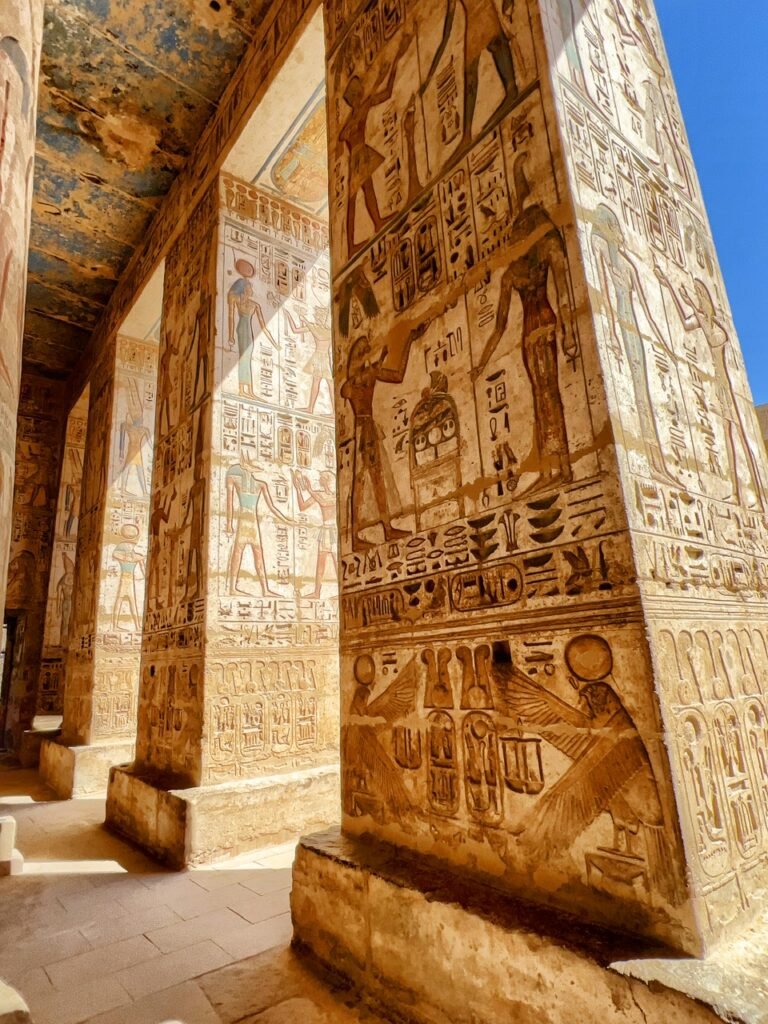
The striking columns.
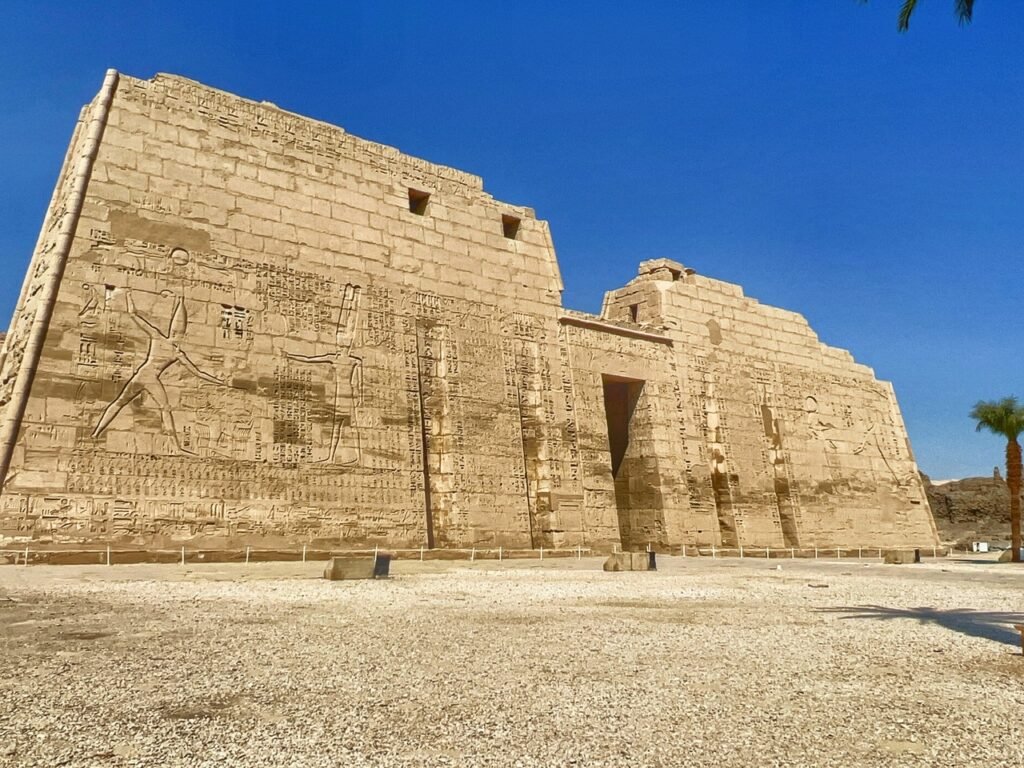
You exit the site through the unique Syrian Gate, a large two-story building modeled after a Syrian fortress: as with the images of the pharaoh smiting his enemies, this harks back to the famous battles between Egyptians and Hittites, particularly at the time of Ramses II.
A Taste of Local Life in Luxor
Travel of course is about seeing iconic and extraordinary sites like the Valley of the Kings and Karnak Temple, which are an experience of a lifetime. Unfortunately, these experiences can be a bit tainted by crowds and the hassling and scheming that often goes along with Egypt. A lot of people only report on this negative side, particularly those that only do tourist things. But, we’ve found, you have to look below the surface in a place like this. While it can be frustrating, this is simply their culture and you have to understand they are only doing what they know.
This said, we also found locals who truly understand that this isn’t the best way to deal with visitors. They understand that spreading positivity and good experiences welcomes more positivity, good experiences, well-deserved tips and repeat business thanks to our recommendations.
Because we stayed for six days, we had the good fortune of making friends with our hotel host Mohammed, whom we have mentioned in another post. He’s a fascinating and warm-hearted person, who not only shared his complex story and childhood but took us to his village home to meet his mom and dad. His mom stuffed us with a fabulous Egyptian meal, which we ate on a vibrant floor made for a princess.
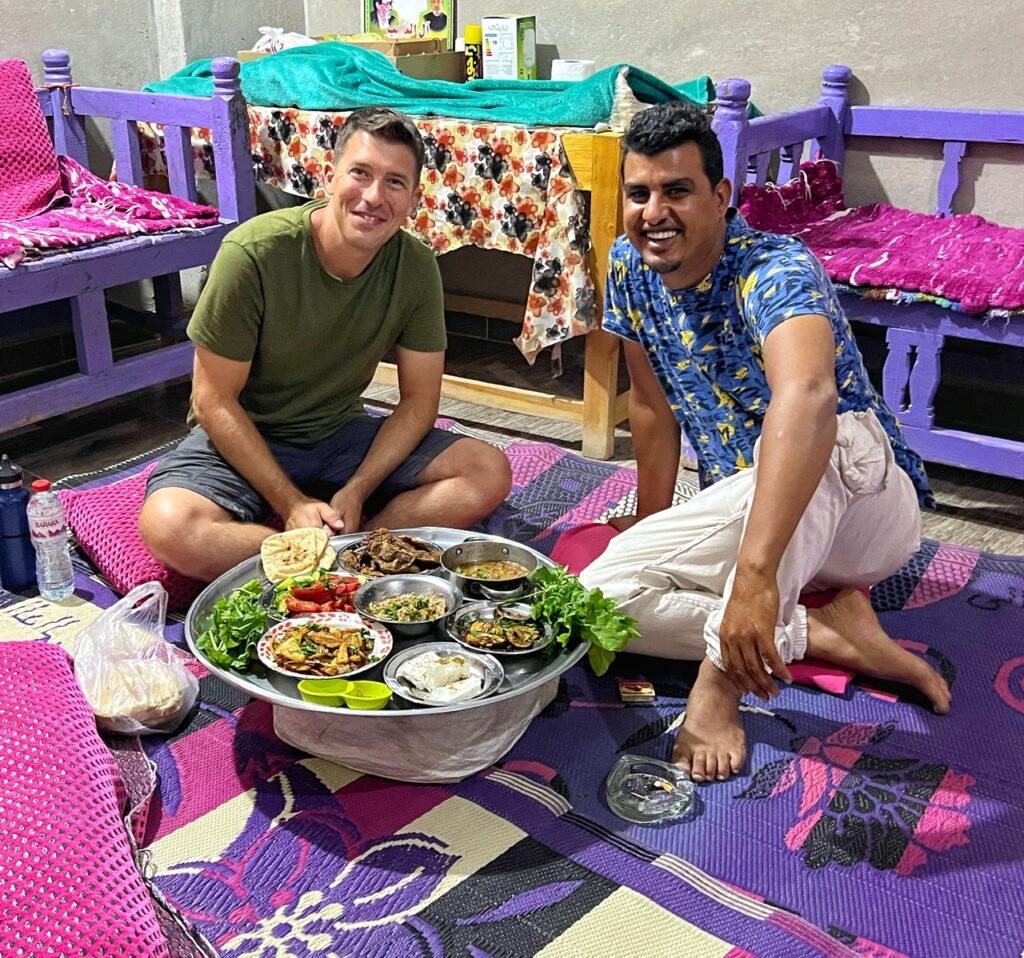
Greg and Mohammed ready to dive in. It was during this meal we asked about his childhood. He came from a family with four children, three boys and a girl. Due to circumstances, his brothers and he had to begin working at age 6 to help support the family while his sister went to school. Therefore, he never learned to read or write Arabic. He learned English “on the streets” but cannot read or write it either. It all made sense at that moment why we couldn’t communicate by text with him, or add him to social media. He couldn’t read our messages. Since being in hospitality, he has learned other languages including some German and French. It’s quite impressive considering how it all began.
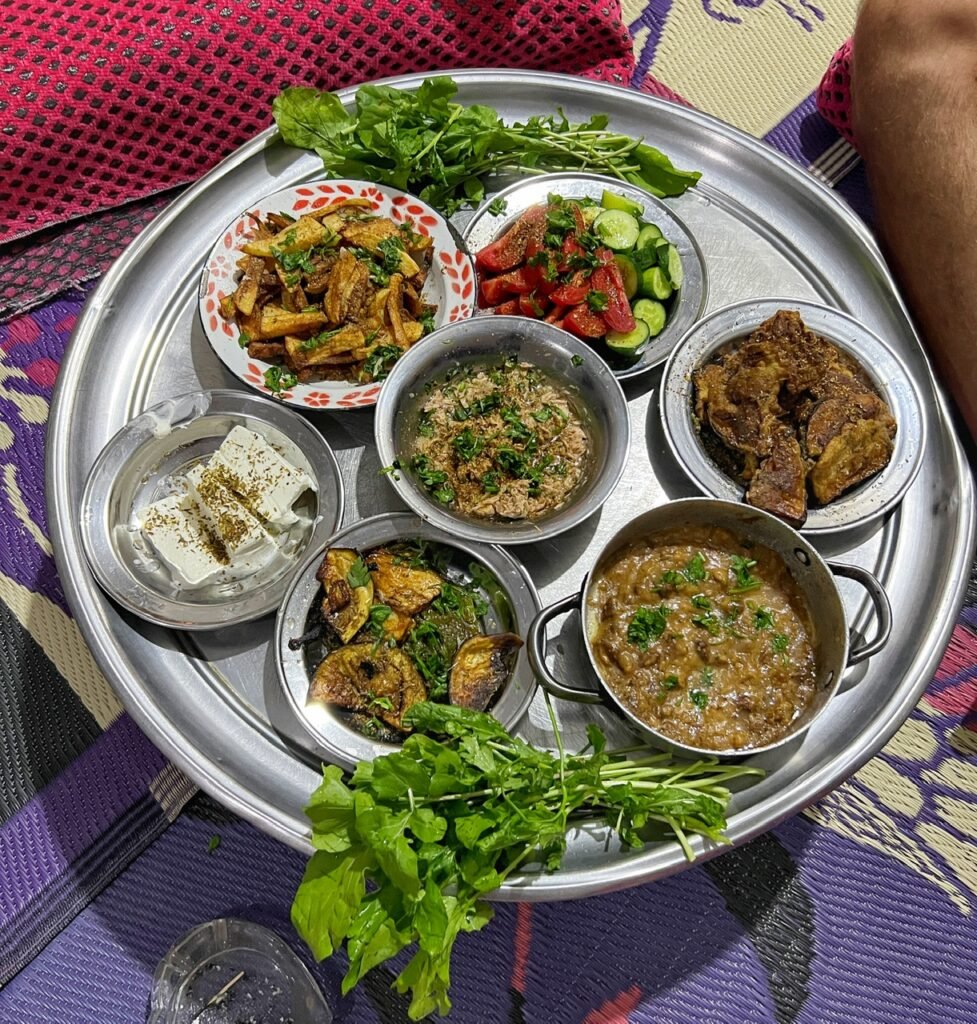
Our incredible spread of food: fried potatoes, cucumbers/tomatoes, fried eggplant, ful (Egyptian fava beans), sautéed eggplant, feta cheese and tuna all spiced and seasoned to perfection!
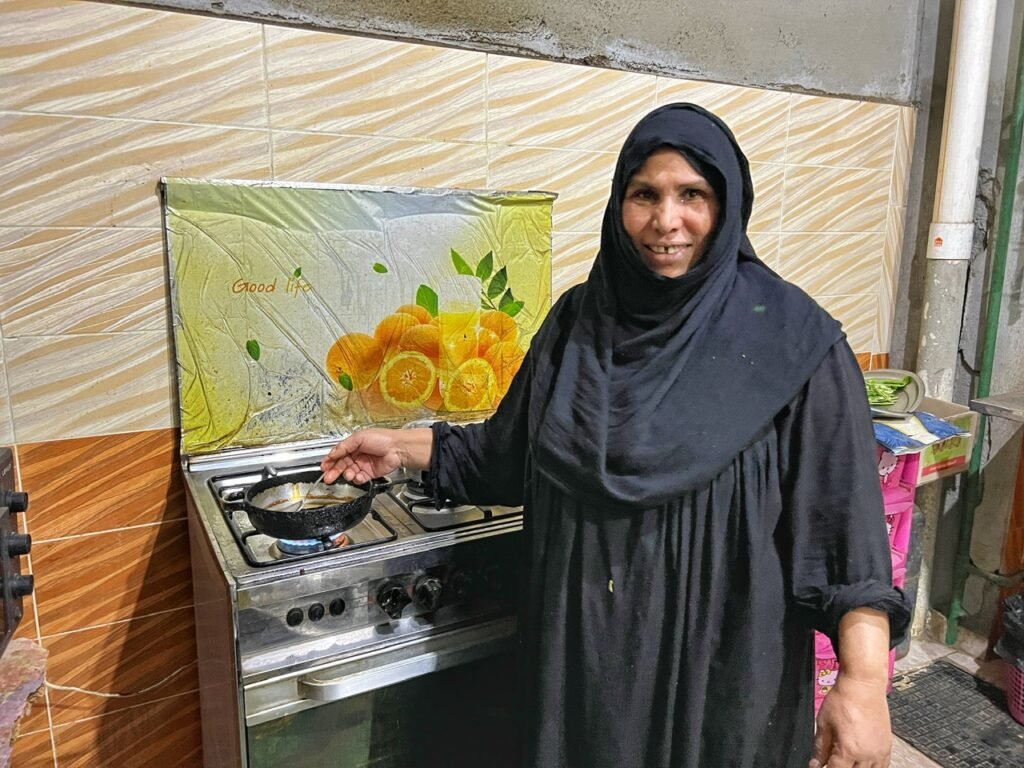
Mohammed’s mom in the kitchen. Although she didn’t speak any English, she was very sweet and smiley.
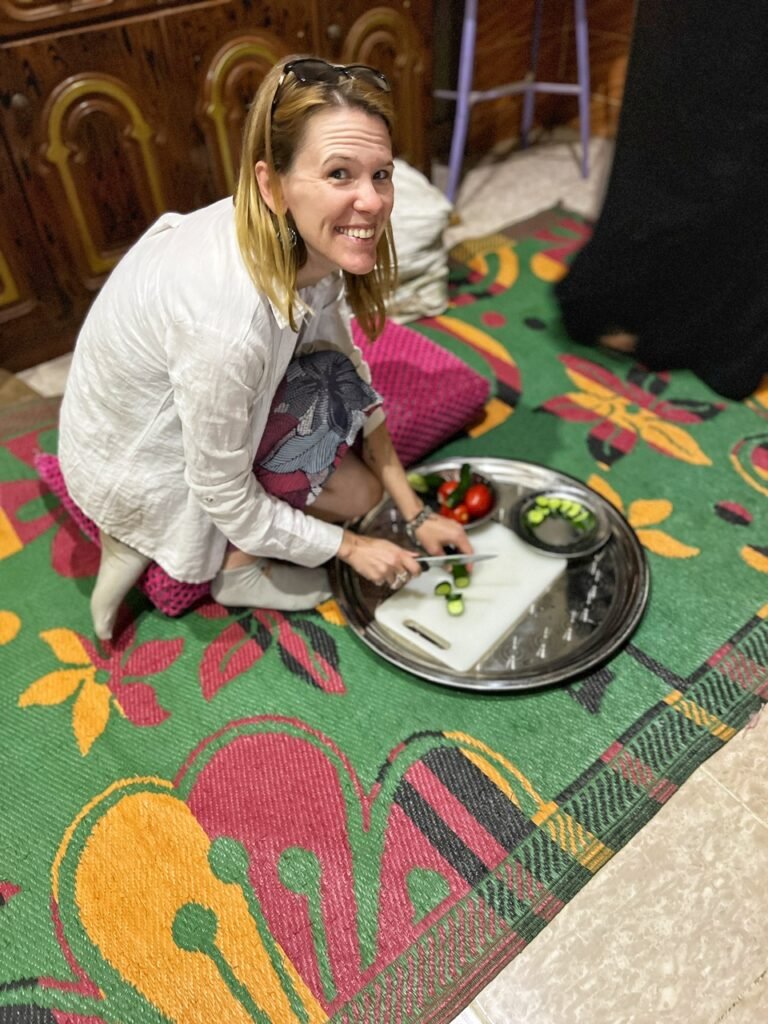
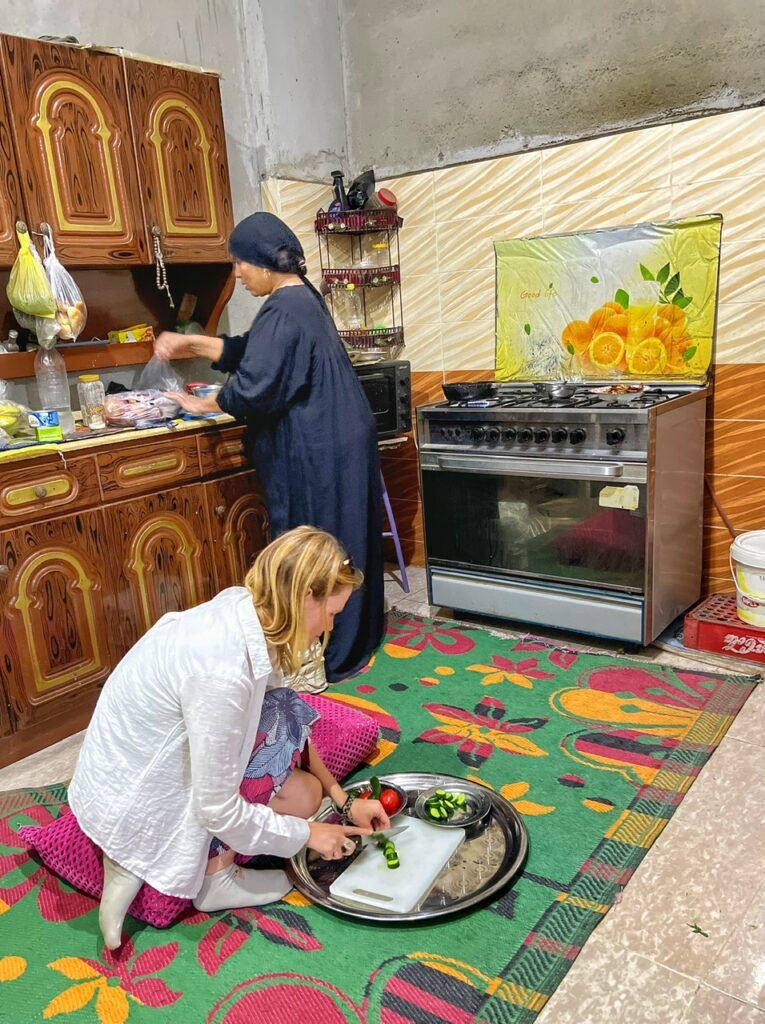
Mandy helping chop veggies. On the floor. We got a little concerned about the tap water used to wash all the veggies but realized it was used everywhere, and didn’t get sick. Fortunately, the water seems far from our experiences in India.
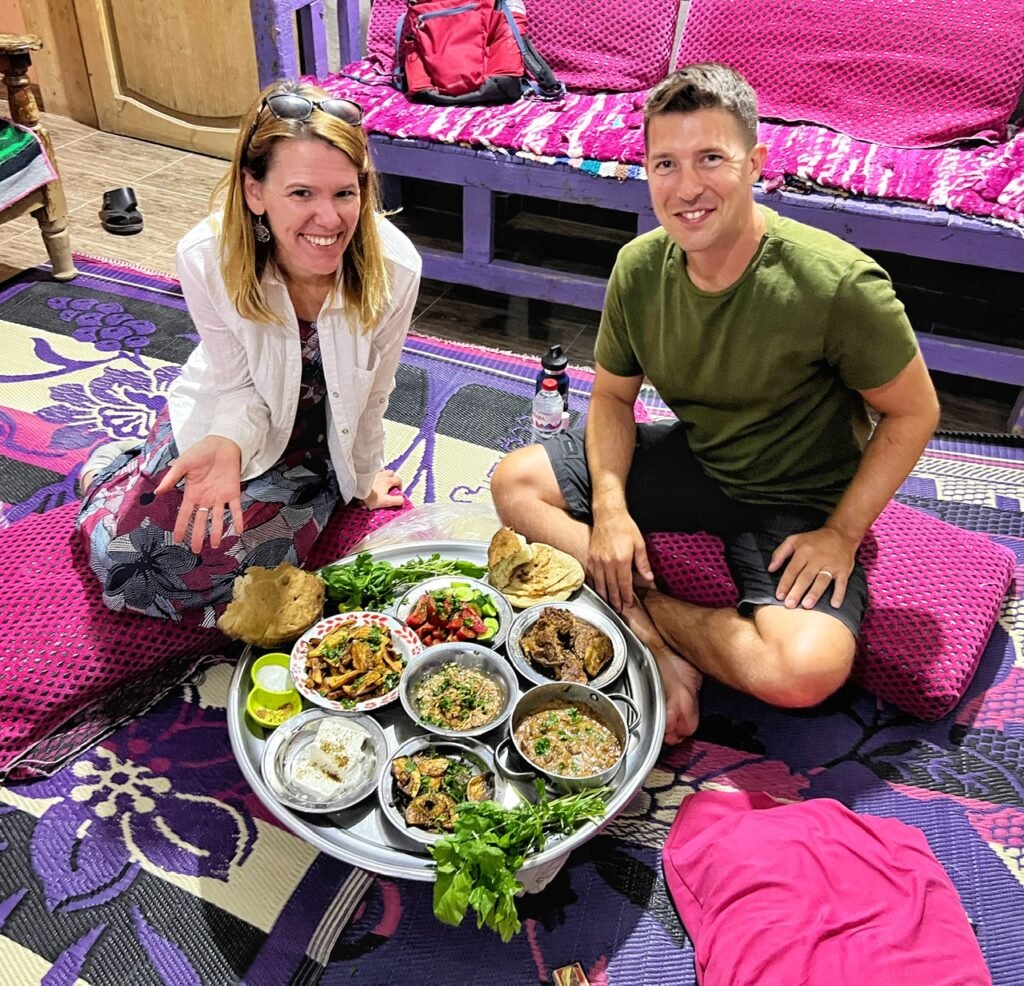
What a feast!!
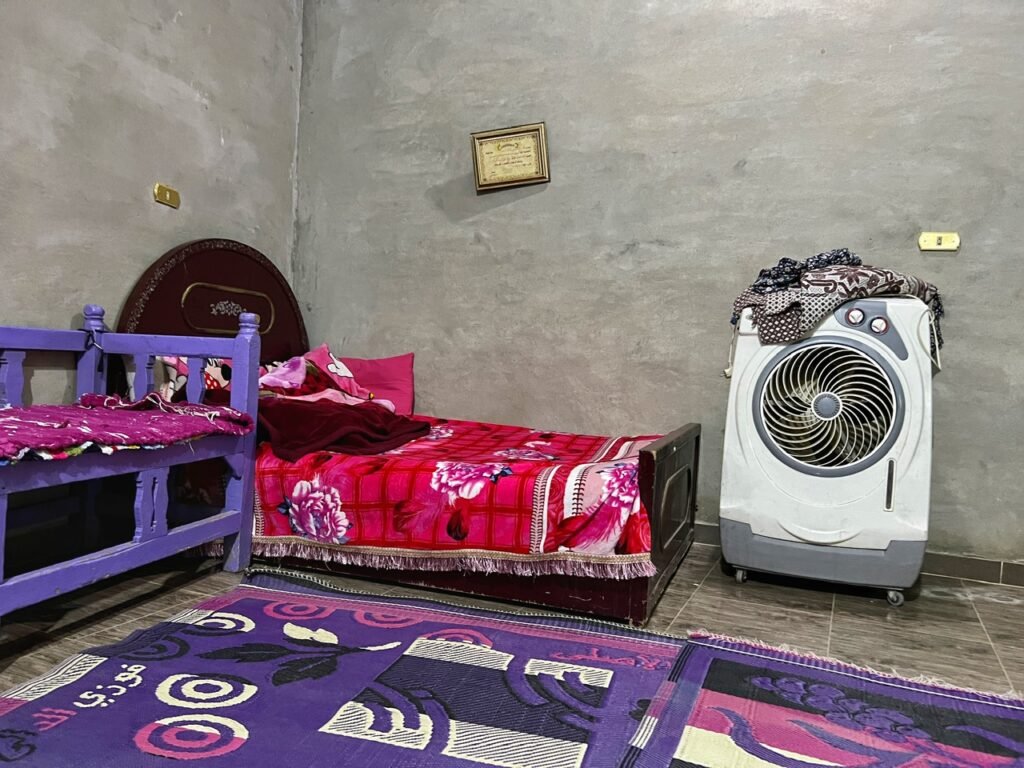
The other side of the room where we had our lunch featured a bed and a swamp cooler. Can’t fathom how hot it gets from April-October (Daily temperatures of 100+ (38C) on average)
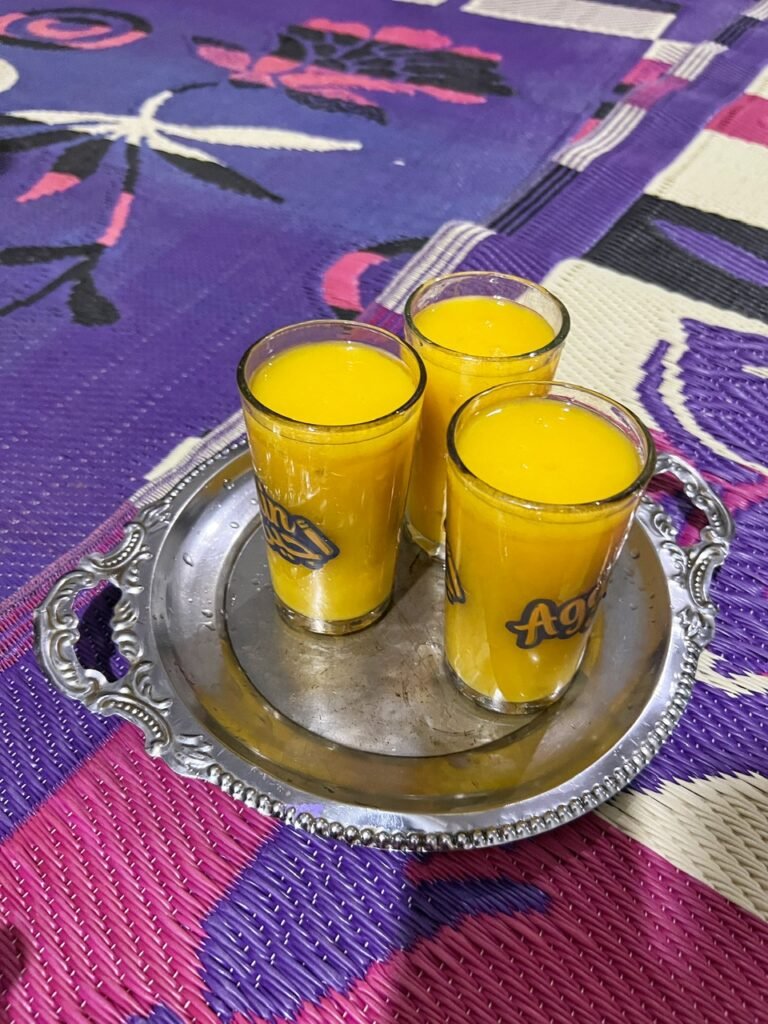
Oh…and to drink. Fresh mango juice, followed by guava juice. Sooo delicious! In the end, as Mandy kissed mama’s cheeks, we knew that Shukran (thank you) was not enough to express our gratitude. So, Mandy quickly learned the phrase “baraka allahu fik,” which means “May Allah’s (God’s) blessings be upon you” which seemed to be a good choice!

Mohammed’s dad owns a shop in the front room of their house. They live right by the mosque so he likes to work right after prayers because the people of the village “always need something.”
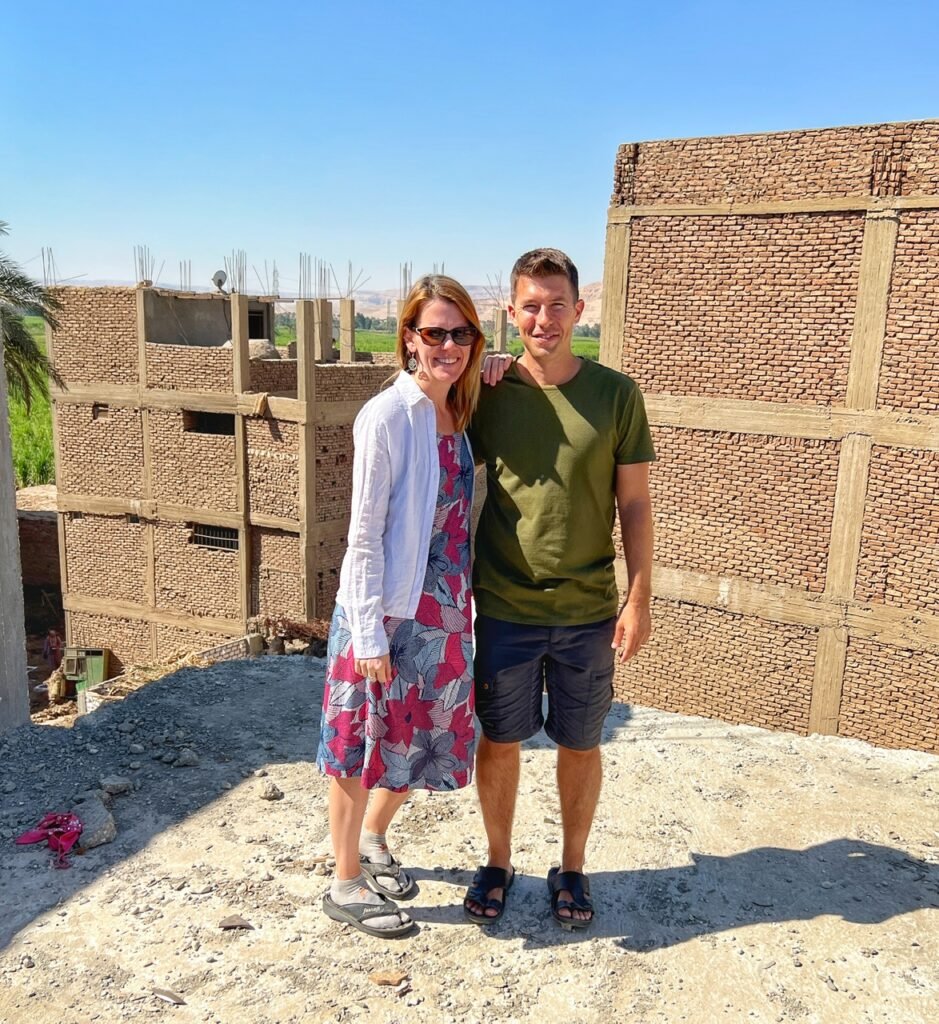
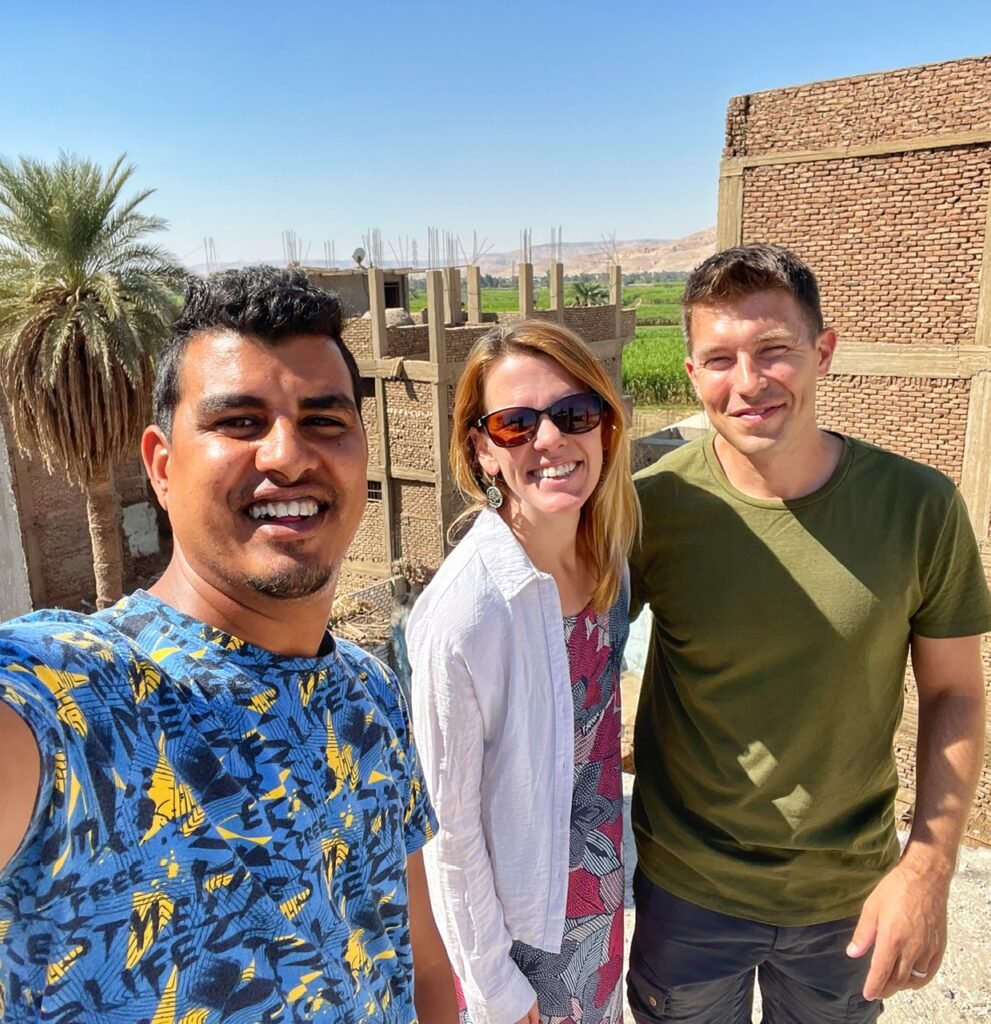
Mohammed then took us to the roof of his home where several rooms were still under complete construction. He said he hoped to move in there one day but had to have a wife, or two…three…first. At age 26, he’s at the age where his mom is starting to wonder when he’s gonna find a nice Egyptian girl, but he’s more interested in the nice European girls he meets through work. 🤣 There was something very familiar about Mohammed. Probably because he reminded Mandy of her Jordanian cousin-in-law of the same name, smile and quick wit.😉
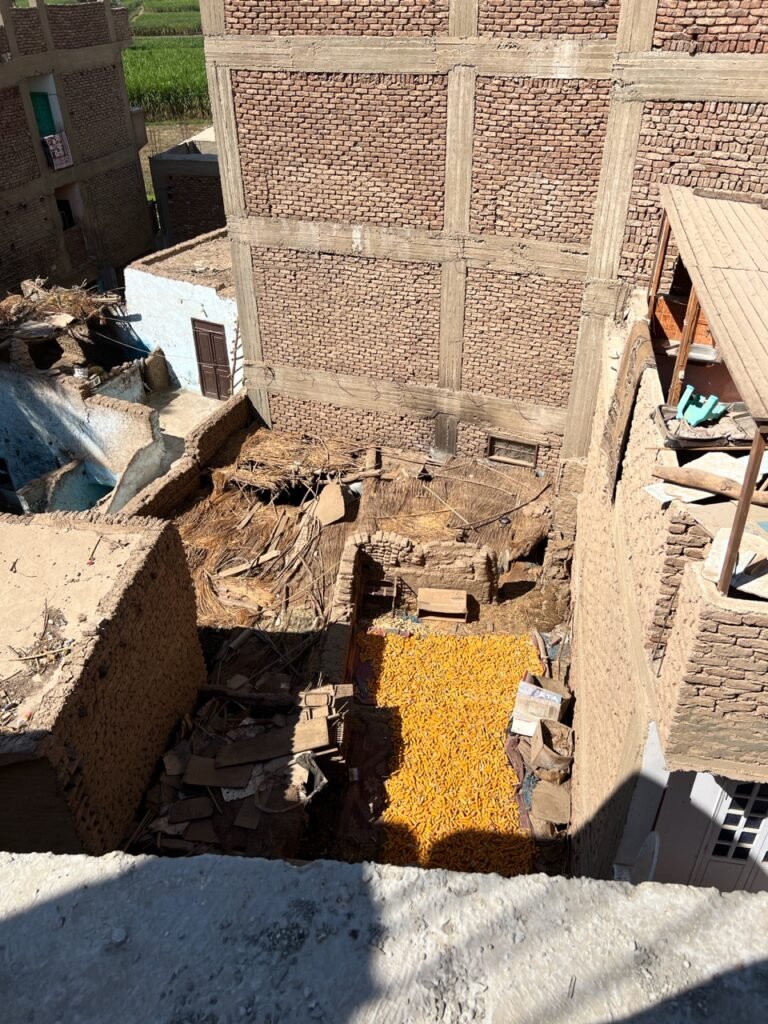
Peering off the roof to find layers of corn being dried. Sheep and horse food, evidently.
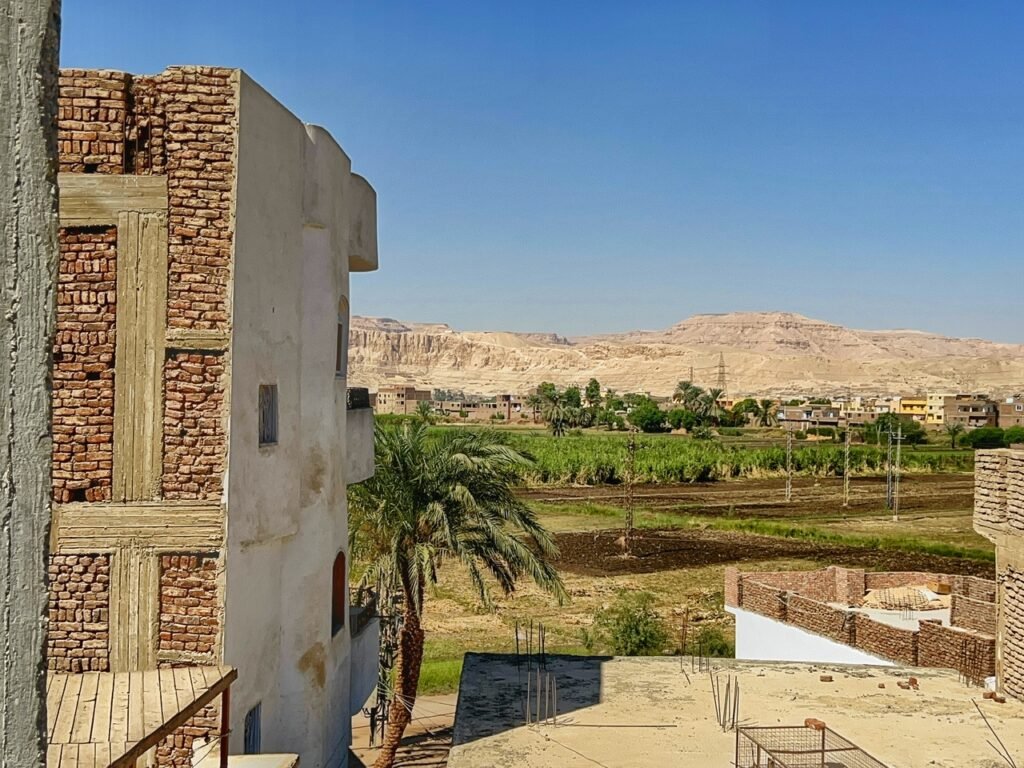
The mountains to the west of Luxor.
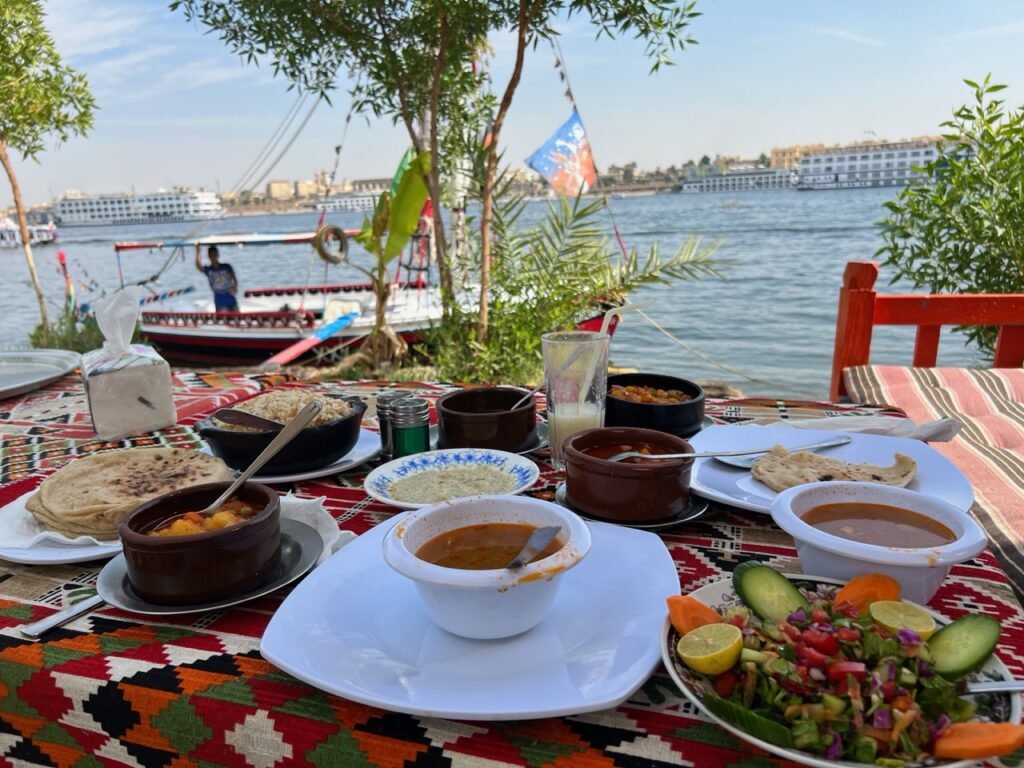

At a different meal, we enjoyed a restaurant right in front of our apartments called Nile freedom. It included a delicious chopped salad, two soups, two entrees, Baba Ghanouj, bread, rice and juice for 273 Egyptian Pounds (or $11.76.) And, as you can see, it was Nile side.
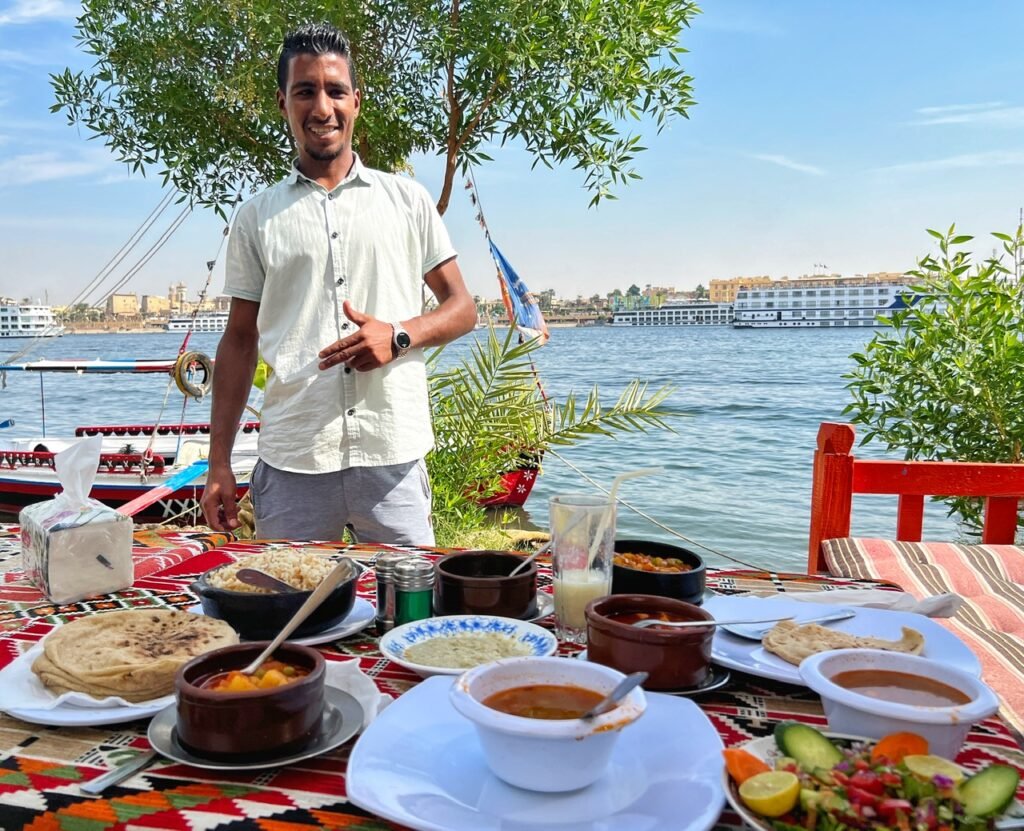
Our friendly waiter, who we met more than once, Zahir. At one point, we also had our only alcohol in Egypt…two small pours of wine for about $4. Not a bad price at all.
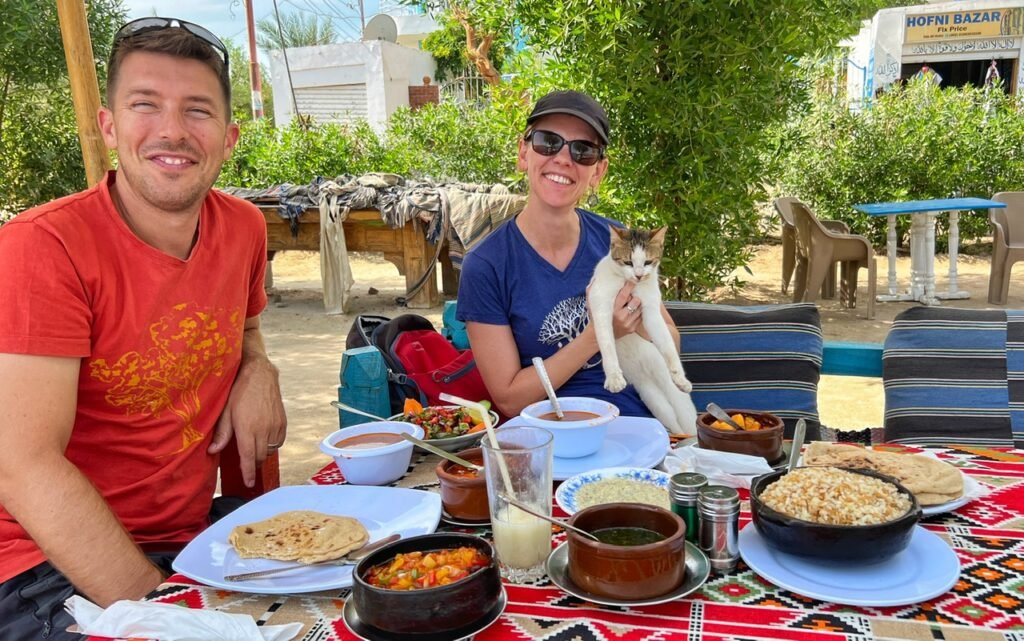
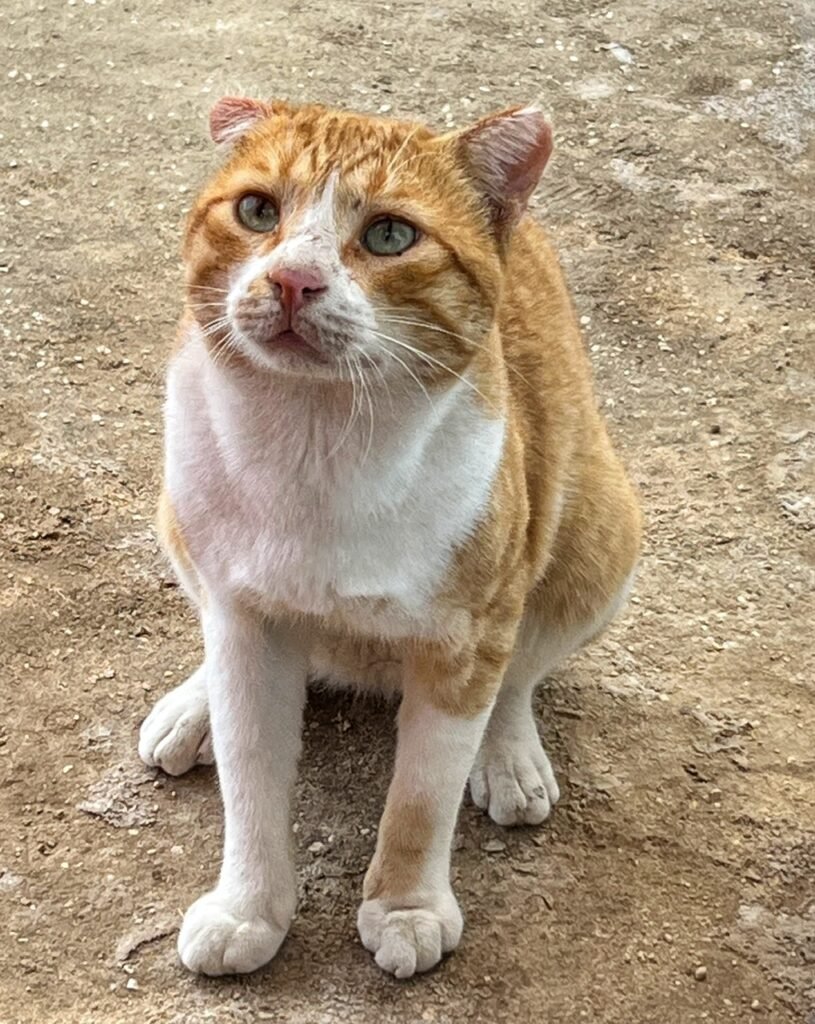
And of course, we had kitty companions. Some were a little less vocal than others.

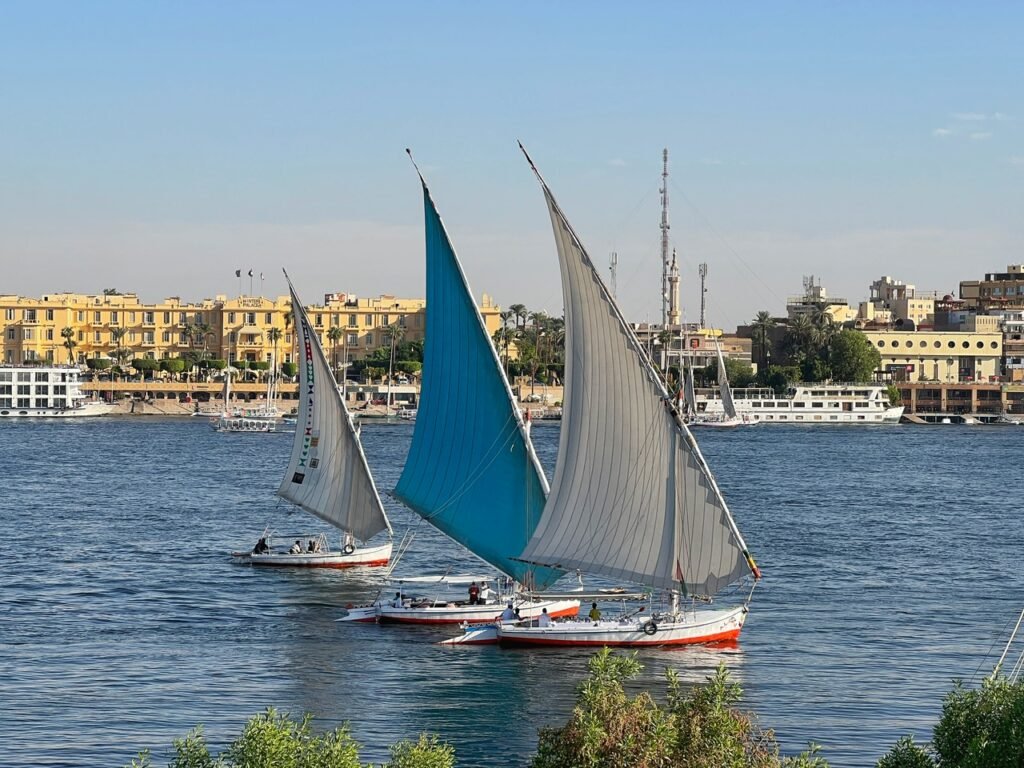
A felucca on the Nile. We decided to not take an overpriced ride ($10-20/hour.) Instead, we got a serene experience on the water on our $.20 ferry crossings. But they were lovely to gaze at over lunch or from on our balcony. We do know if we come back to Egypt, we’d love to do a four-day felucca ride from Aswan to Luxor.
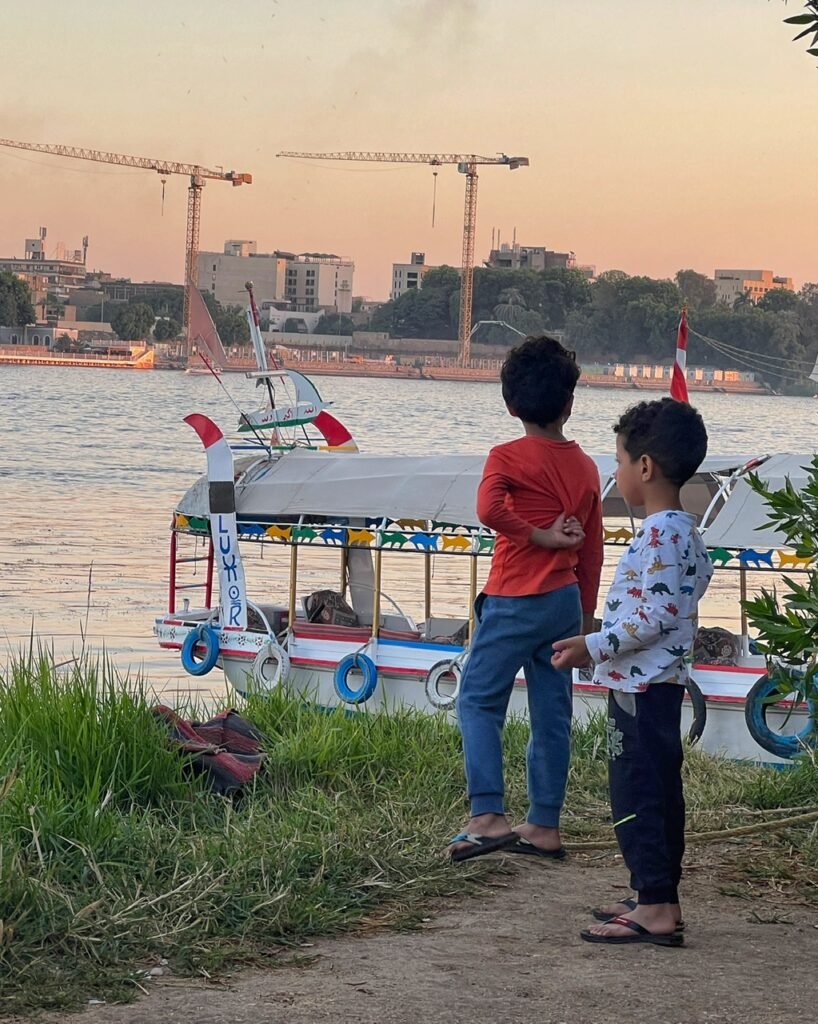
Two kids playing near the water at sunset.
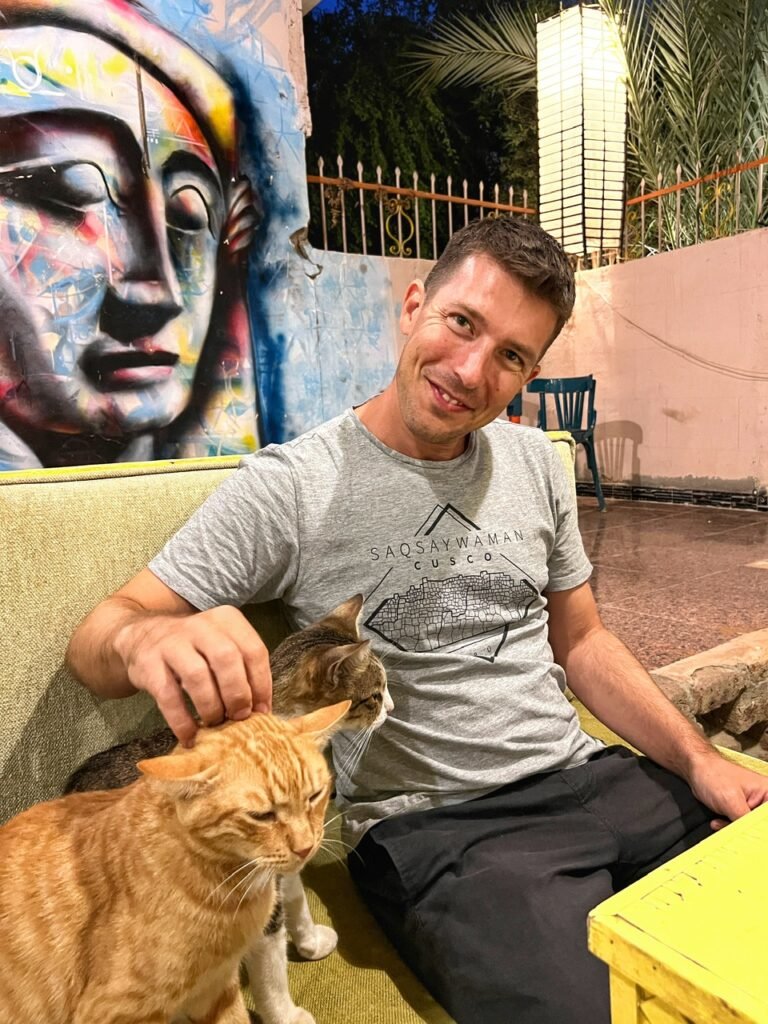
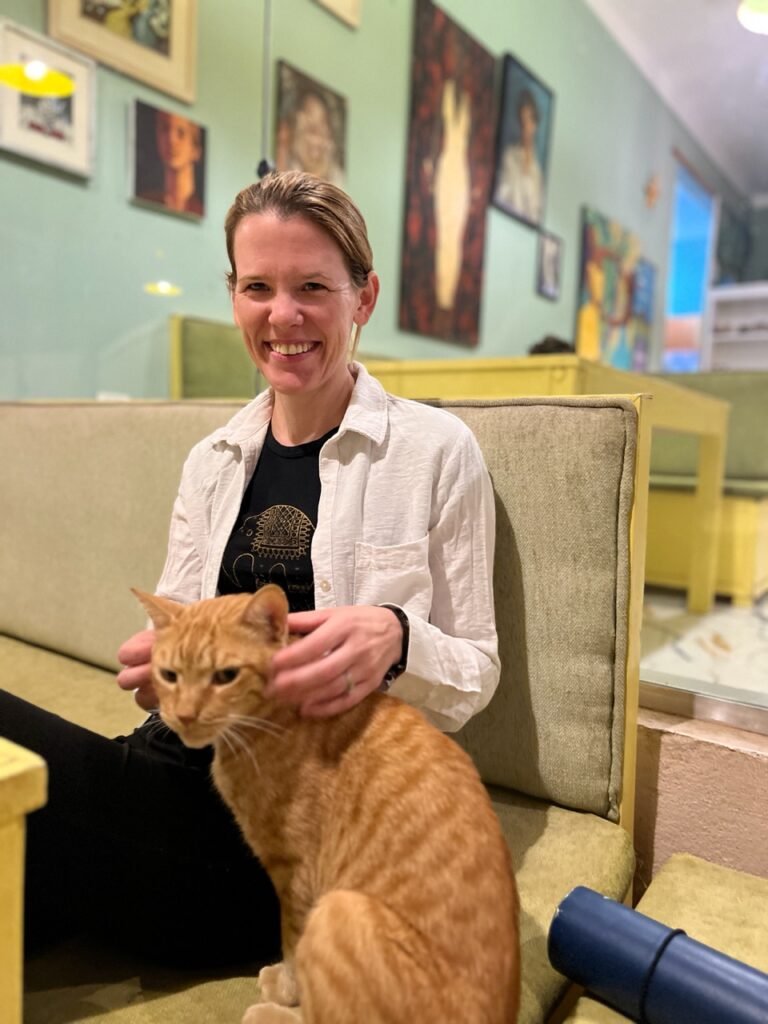
Other meals, other kitties. This was at a fantastic vegetarian restaurant called Wannas Art Cafe.
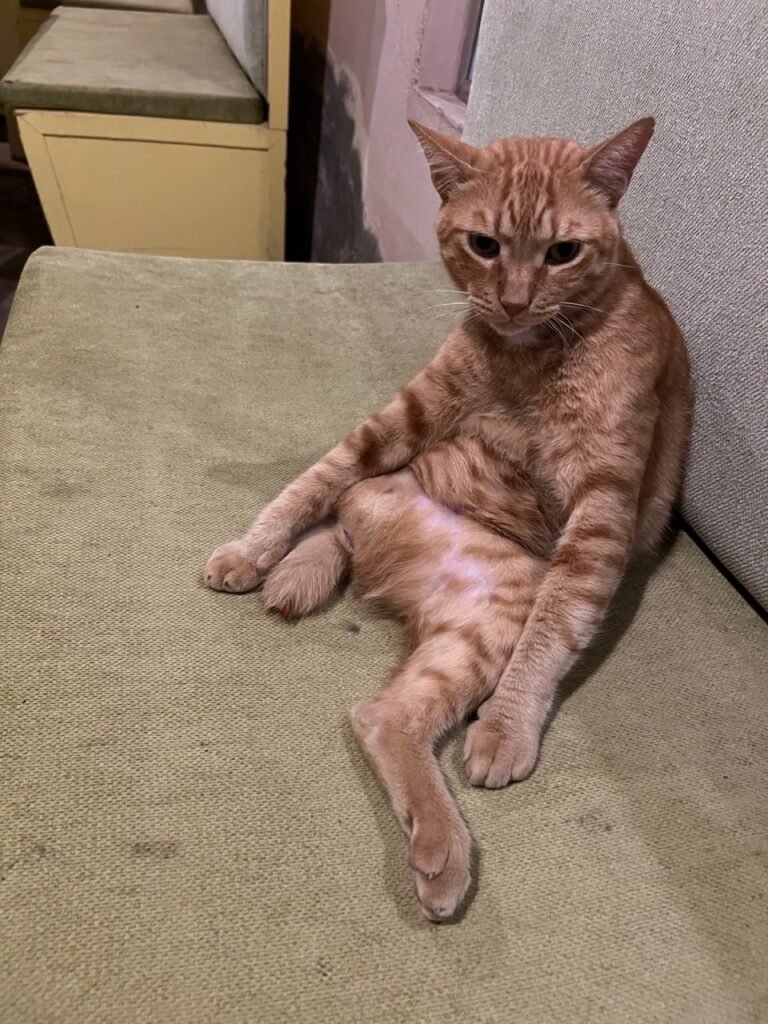
This particular cat’s name was Tripod, because he only had three legs and half a tail. He didn’t seem to have a clue he was different than the others, however. Oh, to be a cat!

One thing we noticed in Egypt a lot was “hassle-free” shops. So they do have a clue this is annoying?! Also, jsut a note, there are no books in that shop.🤣

Another unusual thing about Egypt? They don’t use their headlights. Hmmm. So, wear bright clothes at night. Maybe the only reason to have “fear” about traveling in Egypt. Other than this, we never once felt unsafe after dark in Luxor or Cairo.
Again, just a plug for where we stayed, White House Apartments, (no paid affiliation) which truly has earned its exceptional rating on Booking. Thank you to Mohammed and his family for an experience we’ll always remember. In the end, our favorite thing about Luxor was not the amazing sites. It ended up just being…in Luxor. But again, you gotta choose the right side of the Nile River! (West Bank, West Bank, West Bank!)




